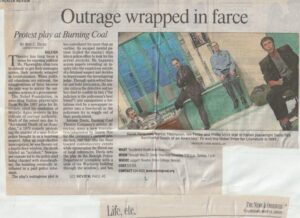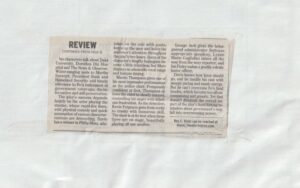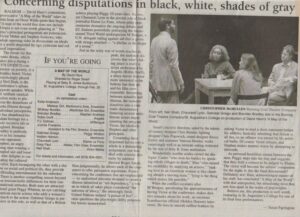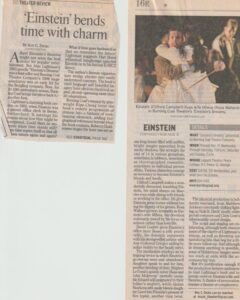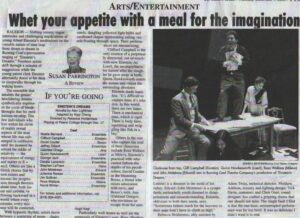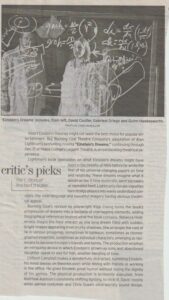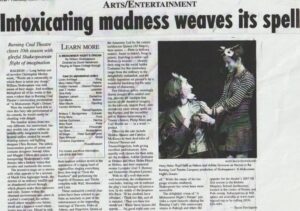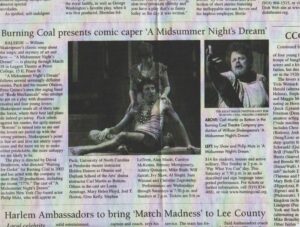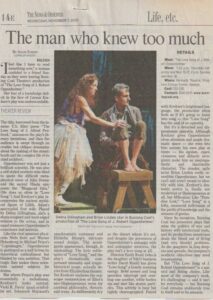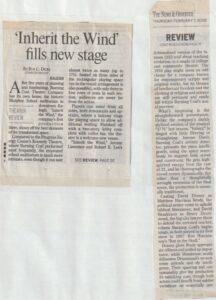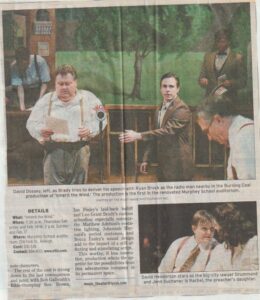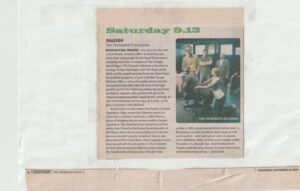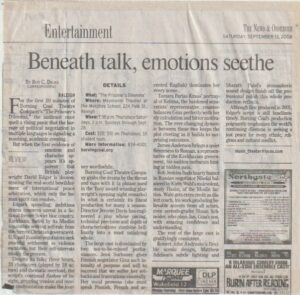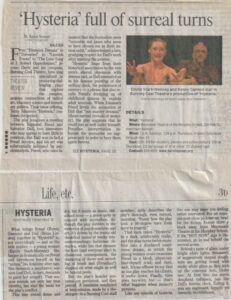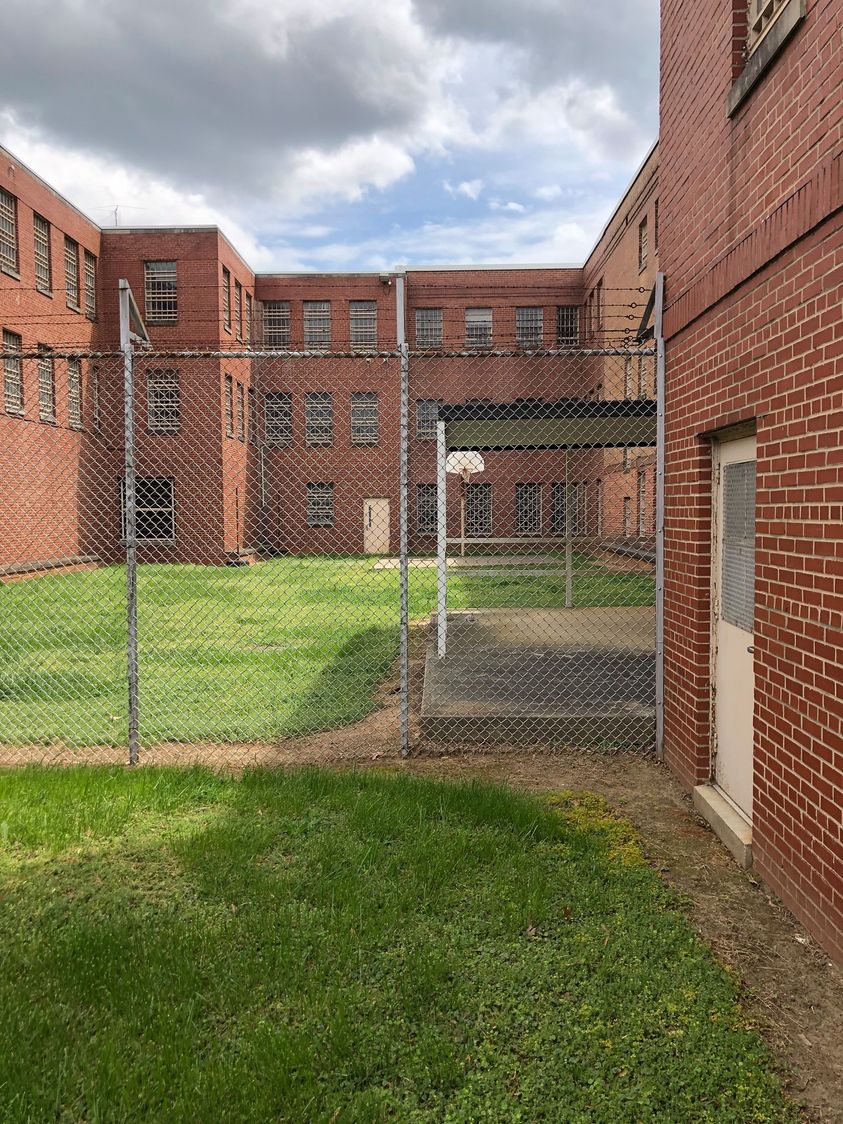
Through the Years Timeline:
Season 7: (2003-2004)
All the King's Men
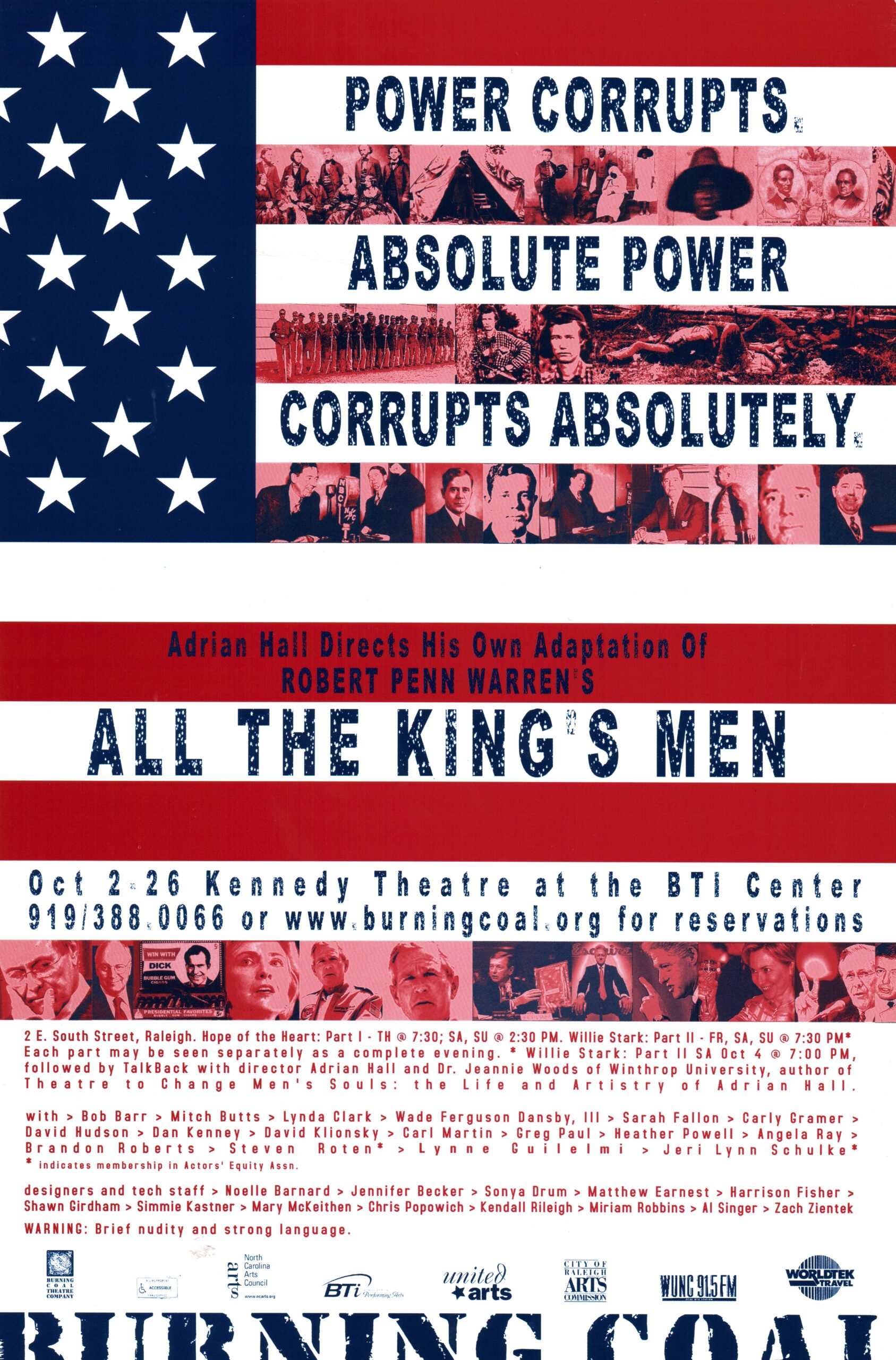
All the King's Men by Adrian Hall, Adapted from Robert Penn Warren
Dir. Adrian Hall
Dates: October 2.-November 2, 2003
Location: Kennedy Theatre
Waiting for Godot
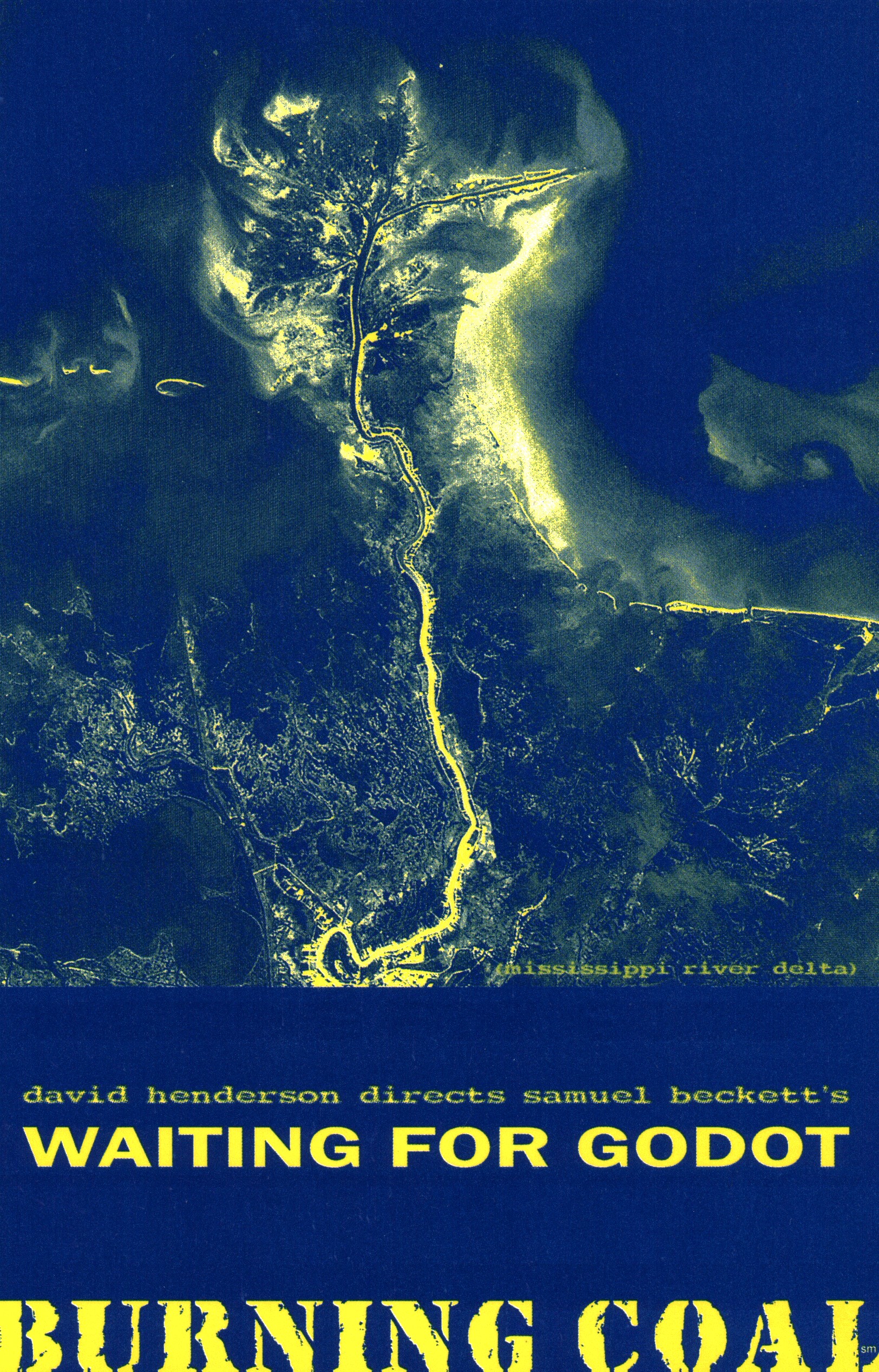
Waiting for Godot by Samuel Beckett
Dir. David Henderson
Dates: Aril 1-18, 2004
Location: Kennedy Theatre
The Man Who Tried to Save the World
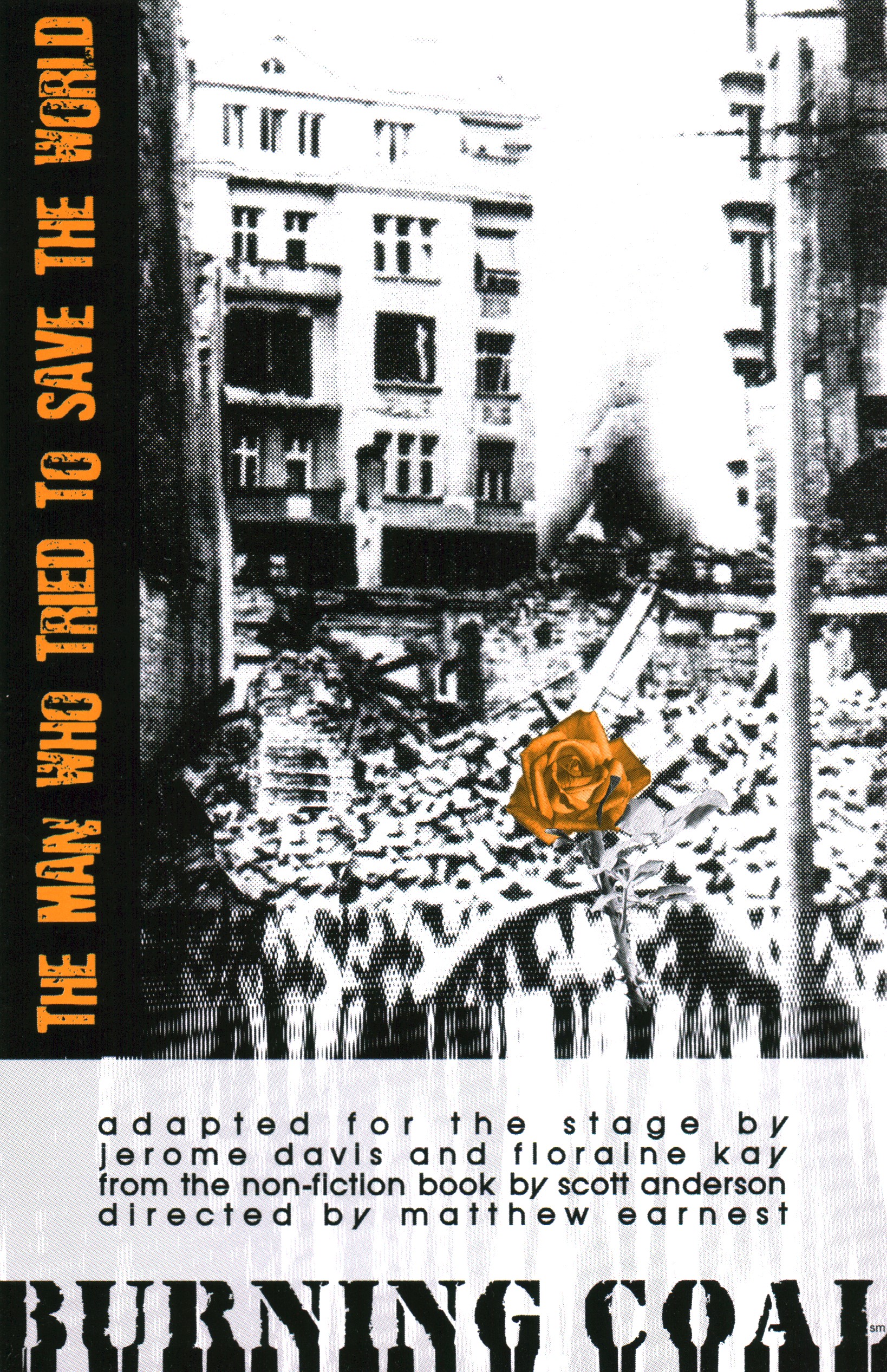
The Man Who Tried to Save the World by Jerome Davis and Floraine Kay adapted from the book by Scott Anderson
Dir. Matthew Earnest
Dates: May 27-June 13, 2004
Location: Kennedy Theatre
All the King's Men
All the King’s Men by Adrian Hall, Adapted from Robert Penn Warren
Dir. Adrian Hall
Dates: October 2.-November 2, 2003
Location: Kennedy Theatre
Artistic Director’s Notes:
I first met Adrian Hall in the winter of 1990. As I was settling into the rehearsal room in Providence with a cast of about 30 actors, waiting for the arrival of what I was quite aware was possibly the most important director in America, I was, to be sure, quite nervous. Adrian allayed those fears immediately. As I sat, studying my script and waiting, Adrian appeared noiselessly in the room behind me, moved quickly over to me and kissed me on top of my head! Without a word, he moved on to greet the others. I think he thought I was someone else! Later that day he suddenly cast me as “Young Scrooge” with the declarative statement, “Byuh, byuh….Jerry! You play Young Scrooge. You look Sixteen!” I was less than a month shy of my 31st birthday!
In Manhattan, at the time, everyone knew Adrian or had a story to relate. An actor, sitting in a subway car would hear a heated conversation and know by the “voice” that Adrian was being mimicked. The thick Texas accent, the stammer, the sentences that all ended with “Byuh, byuh, byuh … the Thing!” A fellow spirit was at the other end of the subway car, regaling a disbelieving listener with the legend of the tall Texan who’d made such a mark on the world. Before I met Adrian, I felt left out whenever I’d hear such a conversation. After I met him, I just smiled.
The history of the American Regional Theatre movement is a short one. It began in earnest with the creation of Margo Jones’ Theatre 47, and continued with the Alley Theatre in Houston, and the Pasadena Playhouse. Adrian knew, worked with and was influenced by the pioneers who effectively created the American Regional Theatre movement at those three institutions. He carried their dreams, their battle plan, with him when he went to Providence to lead the Trinity Repertory Company and, later, to the Dallas Theatre Center. Adrian is a hinge. The early pioneers of the movement taught him and he, almost exclusively, among his peers, continues the good fight, teaching what he has learned to a new generation of theatre leaders.
When Adrian leaves us at the end of the first weekend of performances of All the King’s Men, he will leave behind a little bit of himself and a whole lot of history. We at Burning Coal are proud and honored to be a small part of…the Thing.
Jerome Davis
Director’s Notes:
I grew up in the piney woods of East Texas. Today I live in the house I was born in, at least that part of the house that is still standing. My first degree was from East Texas State Teachers’ College (which is no longer named that). However, I did teach junior high school in two (non-consecutive) years, during which I also graduated from the Pasadena Playhouse and established my first theater company. During the Korean “conflict” I was drafted into the army and immediately sent to Europe, where I helped establish the 7th Army Repertory Company, which toured army bases in Austria. Germany, France and Italy. I apprenticed at The Playhouse Theater in Houston, Texas where later I directed five plays. I went to New York in 1954 with some vague notion of finding “a life in the theatre.” It was the beginning ears of “Off-Broadway,” and I directed 14 Off-Broadway plays, some of which ran longer than a year. The pay was minimal, and there were frequent trips to winter and summer stock, bus-and-truck tours, and many of what in those days were called “out of town jobs.” From Omaha, Nebraska to the old Fred Miller Theater in Milwaukee, the real income supplement came from jobs as a waiter, usher, office temp and at the post office during holidays. Later I would realize how valuable the New York Off-Broadway years were, meeting and mingling with the greats and non-greats, artists, actors and peers.
The national endowment for the Arts was finally created in 1964, and I moved to Providence, Rhode Island to establish the Trinity Repertory Company, where I worked for 26 years. In 1984 I became Artist Director of the Dallas Theater Center, which I ran in tandem with Trinity, 2000 miles apart, for five years. It was a very heady time for me. I truly believed the world was about to acknowledge that the American Theater was more than a one city (New York_ theatre system. The political winds of change shifted suddenly, not because of me, I hasten to point out. I left Trinity and Dallas in 1989, and became a freelance director again. Ironically, since that time I have directed four plays in New York City, but far more exciting, I have directed plays in major theaters in Atlanta, New Haven, L.A, San Diego, Louisville Seattle, Boston, Dallas and Providence. I’m here in Raleigh to bring attention from my checkered past that I never got to “put together” in any of those other worlds” All The King’s Men.
Crew:
Stage Manager: Adam Budlong
Scenery Design: Robert John Andrusko
Lighting Design: Chris Popowich
Costumer, Props: Jennifer Baker
Sound Design: Al Singer
Technical Director: Jennifer Becker
Asst. Director: Thomas King and Adam Traylor
Dramaturg: Jay Eckard
Asst. Stage Manager: Andy Hayworth and Sherry Derry
Cast:
Paul Garrett -Estragon
Thaddeus Edwards – Lucky
Vaughn Michael – Pozzo
Boy – Forte Brookings
Lamont Reed – Valdimir
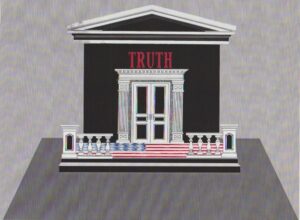
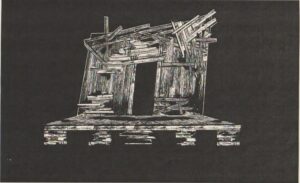
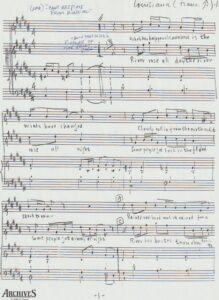
Have a fond or interesting memory of this play you’d like to share with us? We’d love to hear it!
Please Contact Us to Share!
Burning Coal Theatre
(919) 834-4001
224 Polk St., Raleigh NC 27604
Played Oct 2.-Novermber 2, 2003: All the King's Men
Waiting for Godot
Waiting for Godot by Samuel Beckett
Dir. David Henderson
Dates: Aril 1-18, 2004
Location: Kennedy Theatre
Director’s Notes:
I love the blues – not the state of mind, the music. My appreciation for them started with the legend of Robert Johnson – the idea that a man sat in one location waiting to exchange his eternal soul in return for the ability to play the guitar. The devil showed up. The deal was made and a legend was born.
The irony is that Robert Johnson never lived to enjoy the success. He died before he was appreciated.
But what if the devil never showed? What if Robert Johnson was at the wrong crossroads? Would he still be waiting? Would we still be waiting?
The blues master Taj Mahal has called the blues “sweet release.” An outward expression of an inner turmoil. Just singing makes the troubles, makes them tangible, validates one’s existence. If you can feel it and express it, you must be alive.
“Waiting for Godot” has a lot of blueslike resonance. Just like a Robert Johnson song, lines are repeated over and over again. We get the inner turmoil. We get the outward expression of fear. We get a desire to validate existence. But do we get “sweet release?”
Vladimir and Estragon are waiting. For what, we don’t know. It could be God, it could be The Devil, it could be just some person named Godot.
At the crossroads, you never know whom you might meet.
David Henderson
Crew:
Stage Manager: Gail P. Hall
Dramaturg: Deborah Kramer
Choral Director: Alison Lawrence Smith
Vocal Coach: Be Boyd
Assistant Stage Manager: Tess Crane, Hillary Hart Paul
Scenery Designer: Simmie Katsner
Lighting Designer: Scott McIleney
Costumes and Props designer: David Serxner
Light Board Operator” Michelle Barskile
House Manager: Betty Bucci
Poster/Mailer Graphics: William Lightfoot
Costume Cre: Shannon Garlick, Paige Meyers, Sarah Nauhaus, Christine Rapp
Painting: Morag Charlton
Cast:
Nick Beard – Holofernes
Jerome Davis – Boyet
Scot Detwiler – Dumain
David Henderson – The King of Navarre
Elizabeth London – Maria
Allison Ma’luf – Katherine
Rachael Maurer – Moth/Jacquenetta
Beth Carroll – Dull
Robin Monteith – Rosaline
Randolph Curtis Rand – Don Armado
Michelle Barskile – Marcade
Jim Krist – Sir Nathaniel
Benjamin Smith – Longaville
Alexander Yannis Stephano – Berowne
Nan L. Stephenson – Costard
Jessica Thompson – Princess of France
Chorus:
Ana Benschop, Megan Brett, Kat Campbell, Vanessa Durand, Erin Kate Grady, Gracie Patterson, Krissy Smith, Kristin Tucker
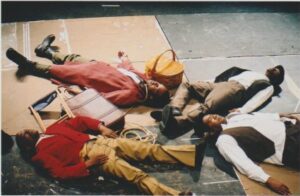
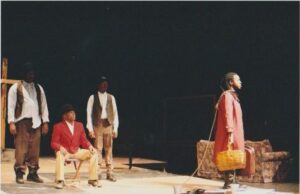
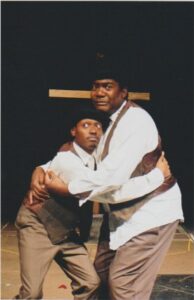
Have a fond or interesting memory of this play you’d like to share with us? We’d love to hear it!
Please Contact Us to Share!
Burning Coal Theatre
(919) 834-4001
224 Polk St., Raleigh NC 27604
Played Aril 1-18, 2004: Waiting for Godot
The Man Who Tried to Save the World
The Man Who Tried to Save the World by Jerome Davis and Floraine Kay adapted from the book by Scott Anderson
Dir. Matthew Earnest
Dates: May 27-June 13, 2004
Location: Kennedy Theatre
Director’s Notes:
You really don’t need to own a coat in Dallas, Texas, where Fred Cuny and I grew up. That’s the truth. In Dallas, a dynamic, spirited city in a grandiose state, the gusts that freeze the plains every January are met head-on by warm air from the Gulf, keeping the winter temperatures there to an average of 55 degrees. Imagine then, the wonder of the Dallas citizenry when a rare carpet of snow finds its way across their green lawns. The schools close immediately. Children finally have the scenery on which to become the characters in their books. Parents take lots of photos. But out on the interstates, less conspicuous scenes are enacted by an unofficial brotherhood (usually in their late teens to early 30s), who are galvanized into action by the ice and snow: I call them, collectively, Big Daddy. They patrol the frozen highways, usually in two-Daddy teams, searching for motorists who have careened into the ditch – hopefully these motorists will be female. The descent is swift and efficient. The titanic pickup stops on a dime (thanks to tire chains used for the first time in six years). As it chugs, eager and heaving, out leap the Daddies with tow-straps newly purchased, and in a moment the car is on its way. Having refused any discussion of payment the Daddies resume their mission, a cooler of beer between them on the seat and country music rattling the gun rack.
For reasons that will be clear after tonight’s performances, I hereby nominate Frederick C. Curry as President Emeritus of a new organization: The Texas & Worldwide Federation of Big Daddies. In years to come, younger Daddies will marvel, even the most leathen of tow-persons will blush when, in a resounding twang, Fred’s accomplishments are called out one by one to the annual assembling to possess one day some of Fred’s skill, compassion, horse sense, audacity, humor, moxie and stubbornness. But for one of them to find even an ounce of Fred’s courage will be rare indeed, as rare as snow in Dallas.
Matthew Earnest
Crew:
Stage Manager: Andy Hayworth
Asst. Director: Jay Eckard
Scenery Design: Bill Rodgers
Lighting Design: Matthew Adelson
Sound Design: Joseph Troski
Technical Coordinator: Jennifer Becker
Asst. Stage Manager: Jeremy Allen and Noelle Barnard
Graphics Design: Simmie Kastner
Dresser: Vicki Szemple
NC Humanities Scholar/Modern European Politics: Dr. Alex Degrand (NCSU Politics)
NC Humanities Scholar/Modern Russia: Dr. Gerald Suhr (NCSU)
Cast:
Mitch Butts- Tex Harris/Teacher/Relief Worker #1/Gerry Nadel/Aslan/General Shalikashvili
Lynne Marie Guglielmi – BBC Radio Interviewer/Sonja Vukotic/Beth Rabren/Jinx’s Daughter/Elizabeth Socolow
David Henderson – Fred Cuny
Trae Hicks – Craig Cuny/Relief Worker #2/Farmer/Lardassed Russian Bureaucrat/Morton Abramowitz/Colin Powell
George Jack – Russian Government Official #2/Phillip Shutler/Mike Huston/Don Krumm/Kurt Schork
Carl Martin – Russian Government Official #3/Carl Long/Mr. Dilbert/Relief Worker #3/Ziya/Iraqi Soldier
Robert Terrell Milner – Scott Anderson
Canady Vance – Charlotte Cuny/Jinx Parker/Maridova
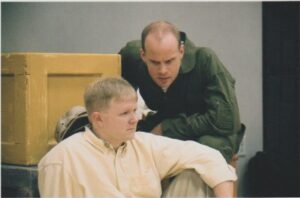
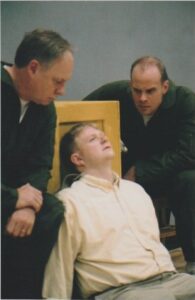
Have a fond or interesting memory of this play you’d like to share with us? We’d love to hear it!
Please Contact Us to Share!
Burning Coal Theatre
(919) 834-4001
224 Polk St., Raleigh NC 27604
Played May 27-June 13, 2004: The Man Who Tried to Save the World
Season 8: (2004-2005)
James Joyce's 'The Dead'
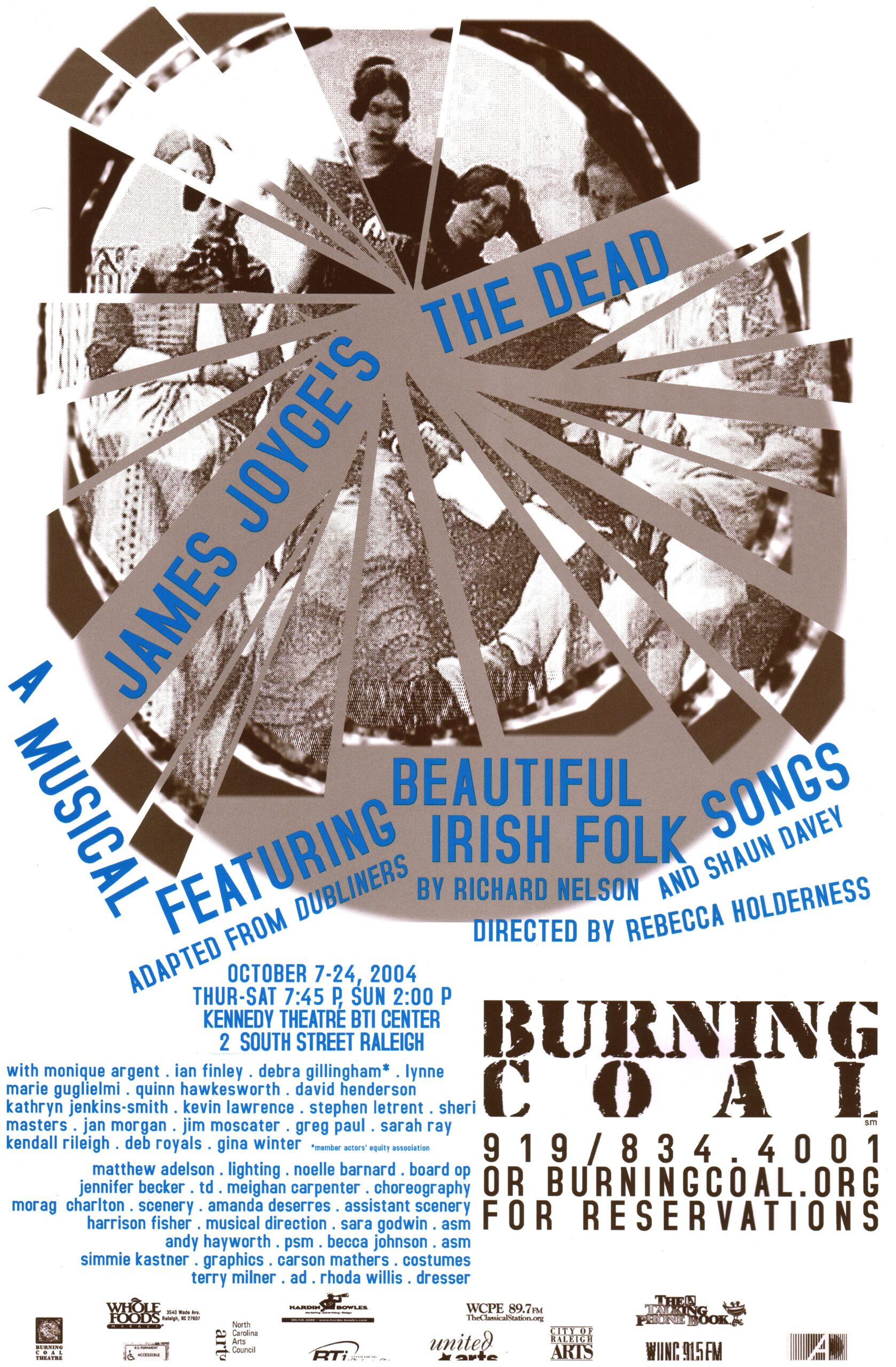
James Joyce's 'The Dead' Adapted by Richard Nelson and Shaun Davey, adapted from the book by Richard Nelson
Dir. Rebecca Holderness
Dates: October 7-24, 2004
Location: Kennedy Theatre
90 in 90 and Safe House
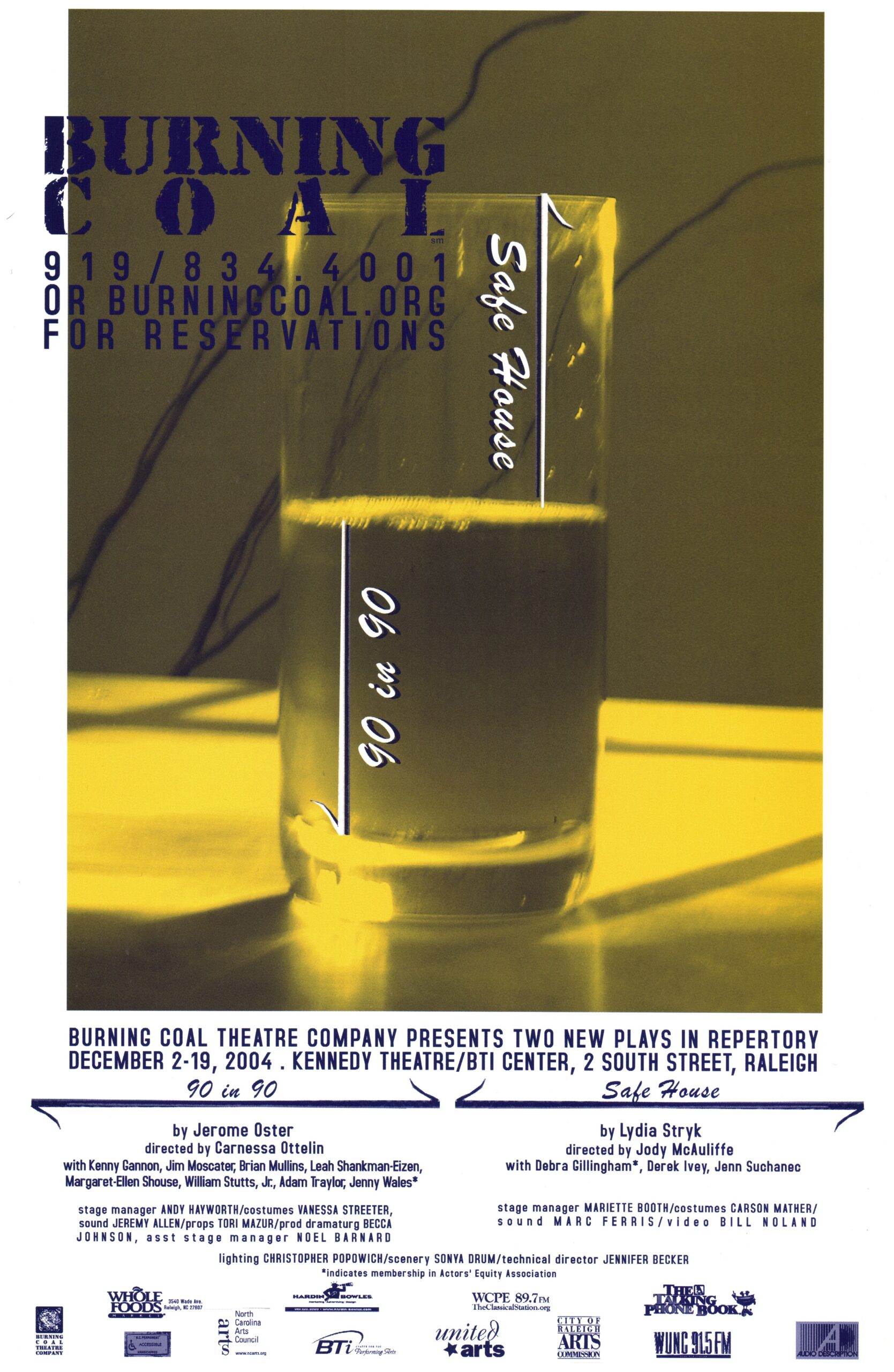
90 In 90 by Jerome Oster
Dir. Carnessa Ottelin
Dates: December 2-19, 2004
Location: Kennedy Theatre
Safe House by Lydia Stryk
Dir. Jody Mcauliffe
Dates: December 2-19, 2004
Location: Kennedy Theatre
Lipstick Traces
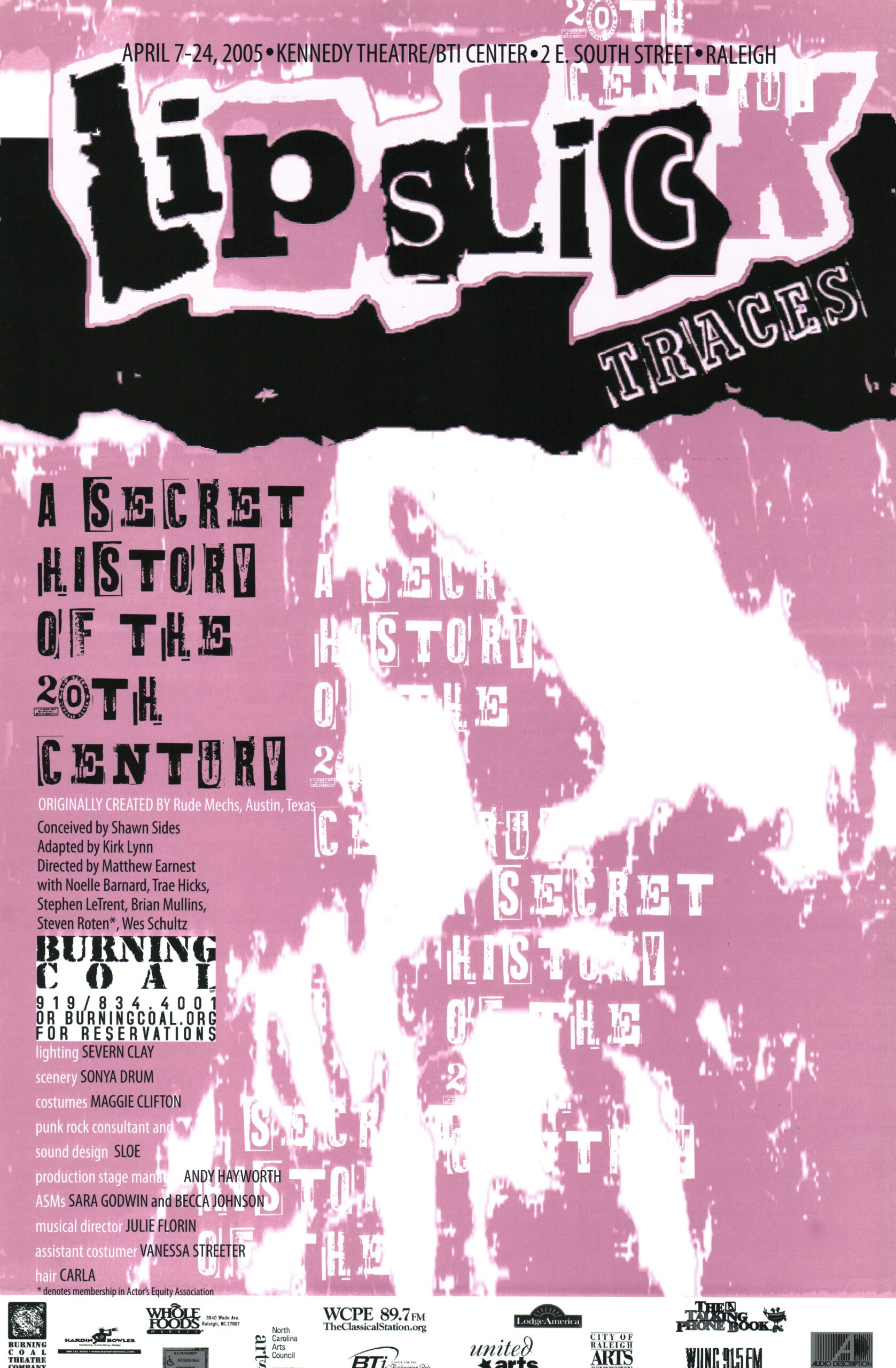
Lipstick Traces originally created by Rude Mechs, Austin Texas. Conceived by Shawn Sides. Adapted by Kirk Lynn from the book by Greil Marcus
Dir. Matthew Earnest
Dates: April 7-24, 2005
Location: Kennedy Theatre
Accidental Death of an Anarchist
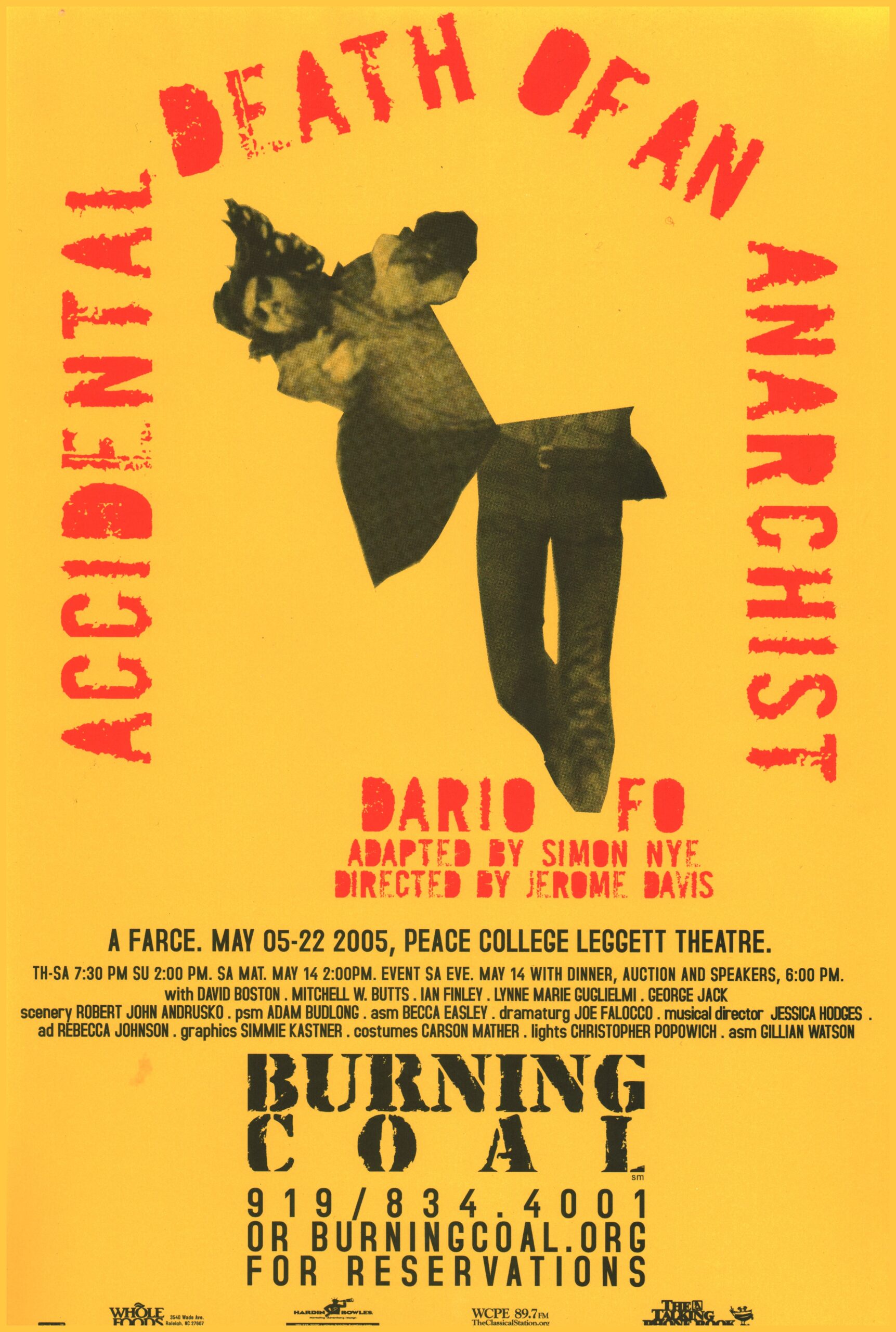
Accidental Death of an Anarchist by Dario Fo, Adapted by Simon Nye
Dir. Dir. Jerome Davis
Dates: May 5-22, 2005
Location: Leggett Theatre Peace College
James Joyce's 'The Dead'
James Joyce’s ‘The Dead’ Adapted by RIchard Nelson and Shaun Davey, adapted from the book by Richard Nelson
Dir. Rebecca Holderness
Dates: October 7-24, 2004
Location: Kennedy Theatre
Artistic Director’s Notes:
The musical James Joyce’s ‘The Dead’ opened on Broadway, appropriately enough, in the dying days of the 20th century. So, too, did Joyce close his majestically eclectic collection Dubliners with ‘The Dead.’ The musical’s book, by the wonderful, unheralded Richard Nelson, is cause for celebration, as is the music and lyrics, cobbled together from a variety of sources old and new by Nelson and the Irish composer Shaun Davey. The short story, which seems to meander a bit at a turn of the century Christmas family gathering before getting down to business, is really about the simple and profound idea that we cannot escape our connections to other human beings, no matter how hard we try. That, of course, is an idea as necessary today as it was 100 years ago. Joyce (and Nelson and Dacey) have packaged the idea around a certain set of “downbeat” images (winter, an ailing aunt, a marriage on the rocks, a long dead beau), but from that darkness, there arises a kind of noble spirit that is so accurate, so full of grace, that it feels like a brisk morning breeze.
We imagine that our past has nothing to do with our future. We dream we are in control of our destinies, that we can break away from those who came before, that we are immune from the human collisions that color each day, that the storm that passes will only pass once, and once gone will have nothing more to do with us. Joyce laughs at that idea. He saw that the storm just may turn around and come back, against all odds. He says in “The Dead” that the young man who pined for you a quarter century before (or the waiter who served your coffee at Starbucks last week?) may rise up like a specter in a bad horror film and utterly rearrange your today. For me, it is a wonderful, positive thought. Think about how we might live if we felt that each connection would be lasting; profoundly likely to change our future. After all, that young man under the window might turn out to be the only true love for you, and that Starbucks barista might one day be your neighbor, your boss, your lover, or your President.
‘The Dead’ is a call to arms. It is Joyce’s gentle suggestion that a society on the verge of civil conflict (1904 Ireland or America 2004) should remember what it is that connects us one to another, that makes us human, that makes us one. There are plenty of superficial reasons to hate those who aren’t so obviously similar to ourselves, but aren’t there plenty more reasons to love them? The Irish at the turn of the 20th century failed to heed this call. The result? A century of agony, bloodshed, and backward sliding toward a lesser, not a great society, despite the great 20th century Irish artists fighting, like boys with their fingers in the dike, to keep their civilization from becoming submerged.
We can, of course, ignore the lessons offered up by those who came before, including those artists. We can sequester ourselves away in clannish “families” where everyone looks like us, dresses like us, prays like us, and make sure that we don’t ever meet those other ones. We can ride out hurricane Ivan, comfortable in the notion that our superior technology (and perhaps moral high ground?) will protect us and that once the storm is gone, it is over and done with. We can ignore the young fellow standing under the window in the rain. We can, or we can not. That is the choice. A hundred years ago Joyce lived and died, and tonight we present to you his tale of all the living and the dead. Hear their cry.
Jerome Davis
Crew:
Musical Director: Harrison Fisher
Stage Manager: Andy Hayworth
Choreographer: Meighan Carpenter
Asst. Director: Robert Terrell Milner
Vocal Coach: Roger Smart
Scenery and Props Design: Morag Charlton
Costume Design: Carson Mather
Lighting Design: Matthew Adelson
Technical Director: Jennifer Becker
Asst. Stage Manager: Sara Godwin and Rebecca Johnson
Graphics Design: Simmie Kastner
Dresser: Rhoda Willis
Makeup Design: Rebecca Holderness
Dance Captain: Lynne Marie Guglielmi
Cast:
Quinn Hawkesworth – Aunt Julia Morkan
Gina Winters – Aunt Kate Morkan
Jan Daub Morgan – Mary Jane Morkan
David Henderson – Gabriel Conroy
Debra Gillingham – Gretta Conroy
Greg Paul – Mr. Browne
Ian Finley – Freddy Malins
Kathryn Jenkins Smith – Mrs. Marlins
Deb Royals – Miss Molly Ivors
Jim Moscater – Bartel D’arcy
Kendall Rileigh – Lily
Stephen Letrent – Michael
Sarah Ray – Rita/Young Julia Morkan
Monique Argent – Student
Lynne Marie Guglielmi – Student
Musicians
Harrison Fisher – Piano
Kendall Rileigh – Violin
Kevin Lawrence -Cello
Monique Argent – Tin shitel, Bourdain
Sarah Ray – Flute
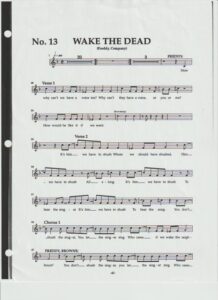
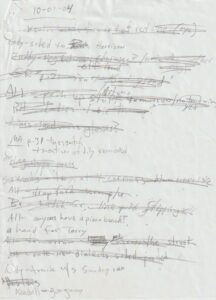
Have a fond or interesting memory of this play you’d like to share with us? We’d love to hear it!
Please Contact Us to Share!
Burning Coal Theatre
(919) 834-4001
224 Polk St., Raleigh NC 27604
Played October 7-24, 2004: James Joyce's 'The Dead'
90 in 90 and Safe House
90 in 90 by Jerome Oster
Dir. Carnessa Ottelin
Dates: December 2-19, 2004
Location: Kennedy Theatre
Safe House by Lydia Stryk
Dir. Jody Mcauliffe
Dates: December 2-19, 2004
Location: Kennedy Theatre
Artistic Director’s Notes:
Baseball fans remember that magic October night in 1988 when a bearded, balding, MVP candidate named Kirk Gibson, so damaged by two separate injuries that he would not take another swing during the entire World Series, stumbled to the plate for the LA Dodgers (ever the bums) to face the mustachioed playboy, Dennis Eckersley from rough and tumble Oakland. Eck hadn’t given up a homer since the war of 1812, Gibson needed a gurnet to get into the batter’s box, and the Dodger crowd was talking on their cell phones and admiring their Rolexes. The As led by a run and there were two out in the bottom of the ninth, a runner on the base. After two flailing swings that even I could have managed, Gibson somehow laid wood to Eck’s devilish sidearm toss and sent that ball rocketing into history. Bums manager Tommy Lasorda, whos physiognomy recalled none so much as the Michelin Man, shot out of the dugout like a twelve year old, followed by 23 delightfully stunned tobacco chewing men-children. Gibson’s grimacing dance around the basepath was as painful and beautiful as a ballet. Kirk Gibson had risen from the grave.
I don’t know where the artistic equivalent of Kirk Gibson is these days. The scene is certainly set for his or her appearance. It’s late in the game, we’re behind, and the mustachioed villain is on the mound. All of the usual suspects have gone down swinging, but each time I look into the dugout, I see sullen downcast faces, angry and spent. It’s a scene I play over and over in my head. I can’t get it out of my mind.
Alright, I’ll quit with the lame baseball analogy and say what I mean to say . The arts are important to society. Period. Over and over I hear arguments that we must appeal to CEOs in the boardroom because without catering to their tastes, we can’t survive. I don’t believe that. Without them, we can’t drive SUVs, own fancy homes and send our kids to Carnegie Mellon. And of course that is what we want, we artists. If that surprises you, and it might, it shouldn’t. We are, after all, human. And so we eye the ledger, we finagle the bottom line, and we drift ever so slowly away from our mission, our lot in life: the creation of art. And not just something that passes for art, but quality art. But how, then do we do that? There is no formula, is there?
Well, I think I can tell you how not to do it. First we must fight the impulse to prosper. Shakespeare’ most popular play, in his time, was probably seen by a few thousand people. Compare that to the ratings of Desperate Housewives. How many people read the great works of Twain, for instance, or Ralph Ellison. Far fewer than read the autobiography of whichever ex-junkie talk show host was splayed across the Times Best Seller list last week. But think for a moment: how poor would our society be without A Connecticut Yankee in King Arthur’s Court or The Invisible Man? One shudders to consider what might have been if either of those fiercely independent no-conformists not laughed at the status quo and swung for the fences (okay I’m drifting back into the sports thing again). Secondly, we must redefine the argument so that quality is the only acceptable measure of success. But quality, you say, is subjective! One man’s quality is another man’s piffle. Of course. But that doesn’t mean we can’t give chase. We shouldn’t be trying to define it, We should be trying to own it. To wear it. And knock it into the night. Ask any baseball fan how many hot dogs were sold in the 88 Fall Classic, how much NBC spent to televise the Series, how much Gibson’s salary was that year: not one will have the answer. But ask them if they remember the sound of the bat striking the ball, the gasp of the crowd, Gibson’s strained fist-pumping gesture as he rounded second base – and I’ll bet you you’ll see a twinkle in their eye. So let’s start saying that quality is good. Period. Third, we have to look for new artists. Stagnation is the death of art and anything that leads to stagnation must be fought. Does that mean we have no institutions? No, it means we rigorously hold our institutions to the highest standard for artists, not the lowest. We stopped walking into pretty buildings and thinking that success has been achieved. The pretty buildings and the fountains and the coffee bar in the lobby is the beginning of the artists’ work and when those who are entrusted with the keys to such hallowed halls rest on their laurels and stagnate, they must be run out of town. Out with the old. In with the new.
Tonight, and I pray, every night, we’re going to swing for the fences (I’m giving in to it) at Burning Coal. We’re going to step up to the plate and stare down that bully, that flamethrowing villain who wants the world to think that it’s okay for art to be “okay,” that simpleton who believes that a person or an arts group’s value to its society can be measured at all, let alone in a spreadsheet. Tonight we’re going to present to you a new play. A play no one has ever seen. I don’t know if it’ll be any good, but I do know what it might be. Our society needs new artists now in a more profoundly urgent way than ever in our country’s history, and if we strike out, the game is lost. Try as I may, I can’t get the scene out of my head. Lasorda is nervous and tired. His hands are sweaty. He turns to the bench. Sullen faces stare back. He stands. He paces. “Gibson,” he bellows, “what about that injury?” The wounded man rises slowly and takes himself a bat. “It’s okay, coach,” he whispers. “I think I’ve got one good swing.”
Jerome Davis
Director’s Notes:
Where do plays begin? Everywhere-situations, moments, emotions…Playwright Jerry Oster’s observation of a woman in Foster’s market, an announcement for a play competition, and a staged reading are catalysts for the play presented tonight. The blood, sweat and tears of a team, both seen and unseen, have taken the ideas of the text and turned then into a reality.
The greatest plays we remember all have a universal commonality. Each started with a premiere. Time would tell how many people would be exposed to the play, but those who participated in the genesis would always be able to say, “I was there.” I can only speak for myself and say that I am honored to have been here. As I have watched this script go from draft to draft, reading to reading, and rehearsal to rehearsal, I am reminded of why I love directing. The beauty of dramatic art is that no one person creates a dramatic work. Each of us plays our part to the beset of our ability. By the end of the process, we have collaborated on a piece that is exponentially better than anything we could have done on our own. In that way, dramatic art is beautifully synergistic. Looking back at this ever-evolving “whole,” that is 90 in 90, all that I can do is thank the rest of the parts that went into creating this evening. Jerry Oster for trust me with his baby and allowing us to parent it together. Josh Purvis for a kind, smart set of eyes and ears. A cast and crew whose humor, talent, and ownership of the project continue to astound and inspire me. Andy Hayworth, angel extraordinaire. Burning Coal for allowing me to tell the story and proudly say, “I was there.” Enjoy and thanks for coming.
Carnessa Ottelin
Director’s Notes:
“Safe House” takes us inside a shadowy world of spies and betrayals where truth is decidedly uncertain and perhaps unknowable. One undeniable fact is that unlike foreign spies, most real American turncoats almost always betray their government just for money, often spurred on by a healthy dose of petty resentment. After all, why bother with anything like a higher purpose, idealism, irony, or pity, when you can simply demand cash. One of these three characters in Lydia Stryk’s “Safe House,” Henry, is just such a figure. Desperate for appreciation and immersed in his comic-book world of superheroes, this government agent relentlessly pursues his aggressive appetite for power and things. His wife Mary, like Carmella Soprano, intuitively knows but rests in denial of her husband’s diabolical dealings, until she cares more about one of his victims than she does about her own safety. The third member of this triangle is Marta, a woman whose exact origin is deliberately ambiguous, but certainly is from one of those places in which America is actively engaged in the so-called “war on terror”–the Middle East, the near East, suffice it to say, the Orient. According to the typical Western vision of the Orient, the danger and threat, the very demons themselves, come from the East. In Stryk’s radical vision, not a demon but a savior comes from the East, to warn the heorine, Mary, of the price of real knowledge, the knowledge of what’s inside the mind of the Other. Marta carries a terrible secret, and Henry, a spy with no moral core, unleashes it to pay for the renovation of his kitchen. Only one of the characters emerges from this debacle full of hope for the future, a future in which, nonetheless, something terrible has been set in motion.
Jody McAuliffe
90 in 90 Crew:
Stage Manager: Andy Hayworth
Scenery Design: Sonya Leigh Drum
Lighting Design: Christopher Popwich
Costume Design: Vanessa Streeter
Props: Tori Mazer
Sound Design: Jeremy Alen
Technical Director: Jennifer Becker
Asst. Director: joshua Purvis
Dramaturg: becca Johnson
Graphics Design: Simmie Kastner
Asst. Stage Manager: Noelle Barnard
Dressers: Lormarev Jones and Amy Massey
Safe House Crew:
Stage Manager: Mariette Booth
Scenery Design: Sonya Leigh Drum
Lighting Design: Christopher Popowich
Costume Design: Carson Mather
Props: Mariette Booth
Sound Design/Composer: Marc Ferris
Video Design: William Noland
Technical Director: Jennifer Becker
Clown Consultant: Jef Lambdin
Asst. Director: Jesse Patrone-Werdiger, Maura Farver
Graphics Design: Simmie Kastner
Asst. Stage Manager: Vanessaw Rodriquez
Dramaturg: Frank Lentricchia
90 in 90 Cast:
Leah Aizen – Linda
Kenny Gannon – Joe
Jim Moscater – Mike
Brian Patrick Mullins – Richard
Margaret-Ellen Shouse -Michelle
William Stutts – A good Looking Man
Adam Traylor -David
Jenny Wales – Dana
Safe House Cast:
Debra Gillingham – Mary
Derrick Ivey – Henry
Jenn Suchanec – Marta
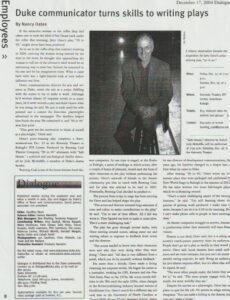
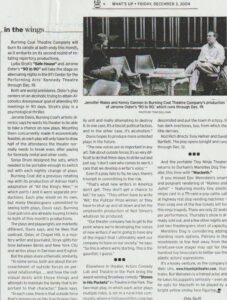
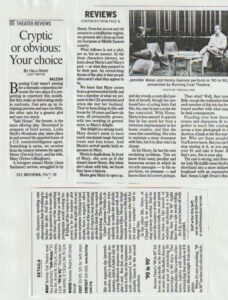
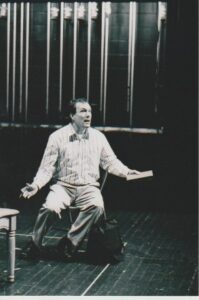
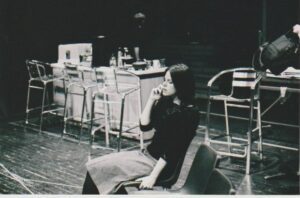
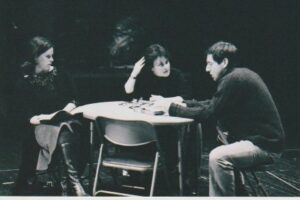
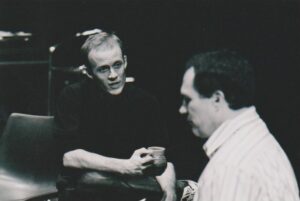
Have a fond or interesting memory of this play you’d like to share with us? We’d love to hear it!
Please Contact Us to Share!
Burning Coal Theatre
(919) 834-4001
224 Polk St., Raleigh NC 27604
Played December 2-19, 2004: 90 in 90 and Safe House
Lipstick Traces
Lipstick Traces originally created by Rude Mechs, Austin Texas. Conceived by Shawn Sides. Adapted by Kirk Lynn from the book by Greil Marcus
Dir. Matthew Earnest
Dates: April 7-24, 2005
Location: Kennedy Theatre
Artistic Director’s Notes:
Bono said, in describing the influence of Punk on his band U2:” Everyone knew Punk was a scam. Everyone except us backward country boys, who heard its call and believed it was the real thing.” Okay, so Bono and I have something in common after all. For a lot of country boys and girls, too, I guess, in 1976 the earth moved under our feet, if but for a moment and it was thrilling in a way that this strange human condition can ever so often be.
I remember my high school psychology teacher gathering the class one afternoon. She spoke in somber tones. It seems in recollection that she gathered us in a semi-circle, the lights dimmed, and foreboding music wafted by as they told us, grimly: “Something is happening in London.” She paused for effect. “It is called … Punk Rock.” She glared at each of us like an Angel of Warning. “And …it is coming here. It is coming this way. The band is called The Sex Pistols. And they …” (she could barely get it out) “…spit on each other. And stick pins through their cheeks.” She finished with a warning. “They are coming to Atlanta (which was half a day’s drive). You Musn’t (I believe she capitalized it just like that) Go. You Must Not.”
Strange that a psychology teacher would not understand the effect this scene would have on we youngsters. I knew three things in that moment. My future opened before me like a book and I saw the writing in fire. One: I must go to that concert. Two: That I would not go to the concert. And Three: That I would hate myself the remainder of my days for having not gone.
Those thoughts rattled around my head for the rest of that day and into the long week of tedium. The Pistols did land in the U.S. They managed a few concerts, including Atlanta, before self-destructing in a fury of drugs, violence and mayhem (see Sid and Nancy). And they did manage to make the world move, just a little bit; four poor street kids with virtually nothing but a talent for mockery. Perhaps it says something terrible about the human condition that such mockery is capable of shaking things up. But I have chosen, since that hair-raising afternoon in ‘76, to interpret their short stay with us a different way. I thought about it, dwelt on it, rationalized it, and still couldn’t shake the feeling of exhilaration, that something had happened, and that it was a good thing. But how? How could these scurvy, rude boys have anything positive to say? Certainly they would have scoffed at such a thought. Then, a couple of years later, just as the first wave of Punk was breathing its last breath, Peter Shaffer’s play Amadeus opened on the West End. It is a play that suggests that God speaks through imperfect vessels, and that it is the message that must be listened to, not the messenger. Well, the message of the Pistols, and all the wonderfully weird movements that you’ll hear about tonight (Dada, Situationist, et al) is that we are responsible for ourselves, and for each other. And that means being aware. Being awake. Wide Awake. In 1976, in the world of popular culture, image and fashion and style were everything. Still are, today, pretty much. But in 1976, if only for a short time, a boy named Johnny Rotten bellowed “I yam an antichrist,” and woke the world. You aren’t likely to see a play (at least not an interesting one) about the Disco movement, which followed rapidly on Punk’s heels, and was funded largely by record companies, radio stations and other corporate entities, because the music’s effect was contradictory to Punk’s. It was a tranquilizer, a narcotic. It would be lovely if we lived in a world in which artists could “wake us up” by being articulate, intelligent, thoughtful. But Punk told us that if we want the world, we’re going to have to make it for ourselves. And maybe the way to go about that, Rotten seemed to suggest with his snarl, is to start by tearing down the mess we’ve made. Tear it up! More on that subject next month from Burning Coal. Stay tuned.
Jerome Davis
Crew:
Stage Manager: Andy Hayworth
Technical Direction and Scenery Design: Sonya Leigh Drum
Lighting Design: Severn Clay
Costume Design: Maggie Clifton
Props: Wes Schutlz
Sound Design and Punk Rock Consultant: Joseph “Sloe” Slawinski
/Dead Ace Productions
Graphics Design: Julia Woltjen
Asst. Stage Manager: Sara Godwin and Becca Johnson
Asst. Costumer: Vanessa Streeter
Asstr. Scene Designer: Katie Ware
Hair: Carla @ Cherry Bomb
French Consultant: Katie Ware
Cast:
Narrator/Siouxsie Sioux – Noelle Barnard
Huelsenbeck/Glen Matlock/Dada Death – Trae Hicks
Heretic/Michael Mourre/Tristan Tzara/Paul Cook – Stephen Letrent
Hug Ball/Guy Debord/Steve Jones – Brain Mullins
Malcom McLaren/Grundy-Steven Roten
Johnny Rotten/Dada Death – Wesley Schultz
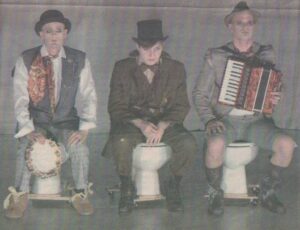
Have a fond or interesting memory of this play you’d like to share with us? We’d love to hear it!
Please Contact Us to Share!
Burning Coal Theatre
(919) 834-4001
224 Polk St., Raleigh NC 27604
Played April 7-24, 2005: Lipstick Traces
Accidental Death of an Anarchist
Accidental Death of an Anarchist by Dario Fo, Adapted by Simon Nye
Dir. Dir. Jerome Davis
Dates: May 5-22, 2005
Location: Leggett Theatre Peace College
Artistic Director’s Notes:
In the late 1980s in New York City, an incident occurred involving the killing of a black man by a white man in a street fight. As the details came forward, we learned that the white man in question was an off-duty New York City cop, that he and some of his friends had run through a red light at a crowded intersection and when the black man, a pedestrian, dared to shout after them for nearly running him down, they stopped their jeep, one jumped out and punched him in the face. The man was an African immigrant who had been malnourished in his early life in Africa. His bones, particularly his skull, were brittle. The punch killed him instantly. The cop, not incidentally, was an amateur boxer. Also, alcohol was involved, the party in the jeep had just come from a bar. The last detail of the story is one that will surprise no one with a rudimentary knowledge of the workings of the New York City police department: no charges were filed against the off-duty cop. This story, and all too many others I could relate from my dozen years in the City, led me to feel ambivalence towards the “boys in blue” and to the idea of democracy as a truly viable form of governance.
One of the reasons Dario Fo’s play has interested me for years is his desire to take a tragic situation like this one and turn it into a farce. Is he fooling? Can such a tragedy really be a reason for laughter? Fo stated that we should not mourn for our fallen comrades, for to do so was to risk catharsis–and that catharsis leads inevitably to a cleansing of our feelings and allows us to feel that everything is now “okay.” You’ll hear this idea voiced by one of the characters tonight, amid the pratfalls and tomfoolery. It is an idea worth serious scrutiny. Has our ability to reconcile our collective or individual guilt led to a broad passivity? And does that passivity aid and abet those who would shift our society away from the egalitarian ideal and closer to a facist state (Mussolini defined fascism as “the merger of the corporation with the state”). As fewer and fewer corporations own more and more media outlets, as more and more people pour into the great art institutions to see and hear the same pablum year after year, the question cannot be ignored. If art and journalism are supposed to be primary defenses against the development of facism, we are in trouble. Our art has split pretty evenly between crass, vulgar trifles and esoteric determinedly inaccessible brow-beating – work whose primary objective is to please a small audience of like-minded intellectuals. Neither of these forms challenge anyone. Fo challenged everyone. He smeared (like little Johnny Rotten?) in the face of everyone and every thing, particularly institutions, governments and agencies. Anything with a hierarchy was beneath contempt, in his mind, and therefore worthy of being made the fool.
If all this sounds like a rant, a tirade, a bit crazed, then ask yourself this question: if it is true, if America is on the verge of becoming a facist state, then what ought one to do? Dario Fo believes that ranting is the only effective civil way to achieve change. And he does it with a sense of humor, with his tongue in cheek, with his instincts for clowning honed to a razor sharp edge. His work and his life is a lesson for us all. Unless of course we are just fooling about our desire for a truly democratic state, a state in which a poor immigrant who had scratched his way to a new world might hope to walk down the street with dignity and without fear.
Director’s Notes:
O.k- Here’s the problem. While the “lighter” characters in this play have straightforward, though descriptive names (“Fang”, “Shallow”, “Tere-Sheet”), and most use diminutives (“Jack”, “Ned”, “Doll”), what the “higher characters call themselves is a little more complicated.
To start with, there’s the sir name. All royalty has shown tremendous lack of imagination in this matter (they would say they “uphold tradition”). Thus, we have the King, Henrie IV, whose oldest son is called Henry, and next son is called John, after his grandfather. And we have Henry Percy, Earl of Northumberland, and his son … Henry Percy. Indeed, the nobility probably need the variety. What with all the Henrys, Johns, and Thomases, a council of Parliament might easily turn into a production of The Bald Soprano.
To make things simpler, these nobles sometimes use nicknames. Both King Henrie and Prince Henry are called “Harry”. But the Prince is also called “Hal”, so that helps. And Henry Percy (Fils) is called “Hot-Spurre”, so there’s no confusion with dad. But dad is usually called a name the royals used most often with each other; that of title. So Percy (Pere) is “Northumberland”, his brother “Worcester”, the King’s sons’ “the Prince of Wales”, “Lancaster”, “Gloucester”, “Clarence” (yes, Clarence is a title, his name is Thomas). These titles derive from actual counties in England that owed money and allegiance to their lord. It would be like someone calling you “North Raleigh” or me “Brooklyn” (well, “Fort Green” anyway).
Even simpler, the nobles just as often call themselves by where they were born. So, Henrie – “Harry” – “Hal” – Prince of Wales, is called Henrie “Monmouth”, his father Henrie “Bollingbroke”, and his father, John “of Gaunt”. Simpler still, though least used, is the family name. Edmund is called “Mortimer”, the Percys are called “the Percys”, and the King’s family is called “Plantagenet” (but only once)!
Simplest of all is the nice habit the nobility has of calling anyone of any relation to them “Cousin”. And Kings of different countries, who are no relation whatsoever, call each other “Brother”.
So, is everything clear?
O.k. On to spelling and pronunciation….
Randolph Curits Rand, May 1999
Crew:
Stage Manager: Adam Budlong
Technical Director: Dennis Johnson
Scenery Design: Robert John Andrusko
Lighting Design: Christopher Popowich
Costume Design: Carson Mather
Props: Robin Hughes
Sound Design: Jeremy Allen
Music Director: Julie Florin
Graphics Design: Simmie Kastner
Production Dramaturg: Joe Falocco
Asst. Director: Rebecca Johnson
Asst. Stage Manager: Becca Easley, Andy Hayworth, Gillian Watson
Marketing DIrector: Becky Suzik
Lighting Operator: Barbara Corbin
Cast:
Phillip Mutz – Them Maniac
George Jack – Bertozzo
Ian Finley – The Officer(s)
Kevin Ferguson – The Detective
Martin Thompson – The Chief
Lynne Marie Guglielmi – The Journalist
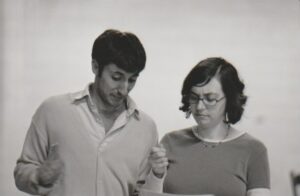
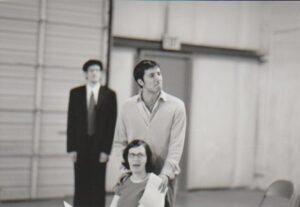
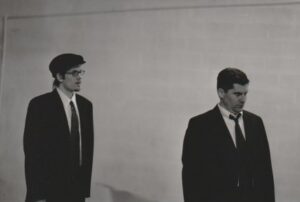
Have a fond or interesting memory of this play you’d like to share with us? We’d love to hear it!
Please Contact Us to Share!
Burning Coal Theatre
(919) 834-4001
224 Polk St., Raleigh NC 27604
Played May 5-22, 2005: Accidental Death of an Anarchist
Season 9: (2005-2006)
The Taming of the Shrew
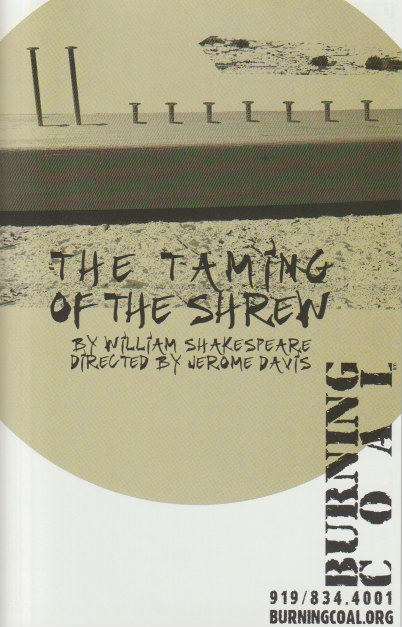
The Taming of the Shrew by William Shakespeare
Dir. Jerome Davis
Dates: September 15-October 2 2005
Location: Kennedy Theatrre
A New War
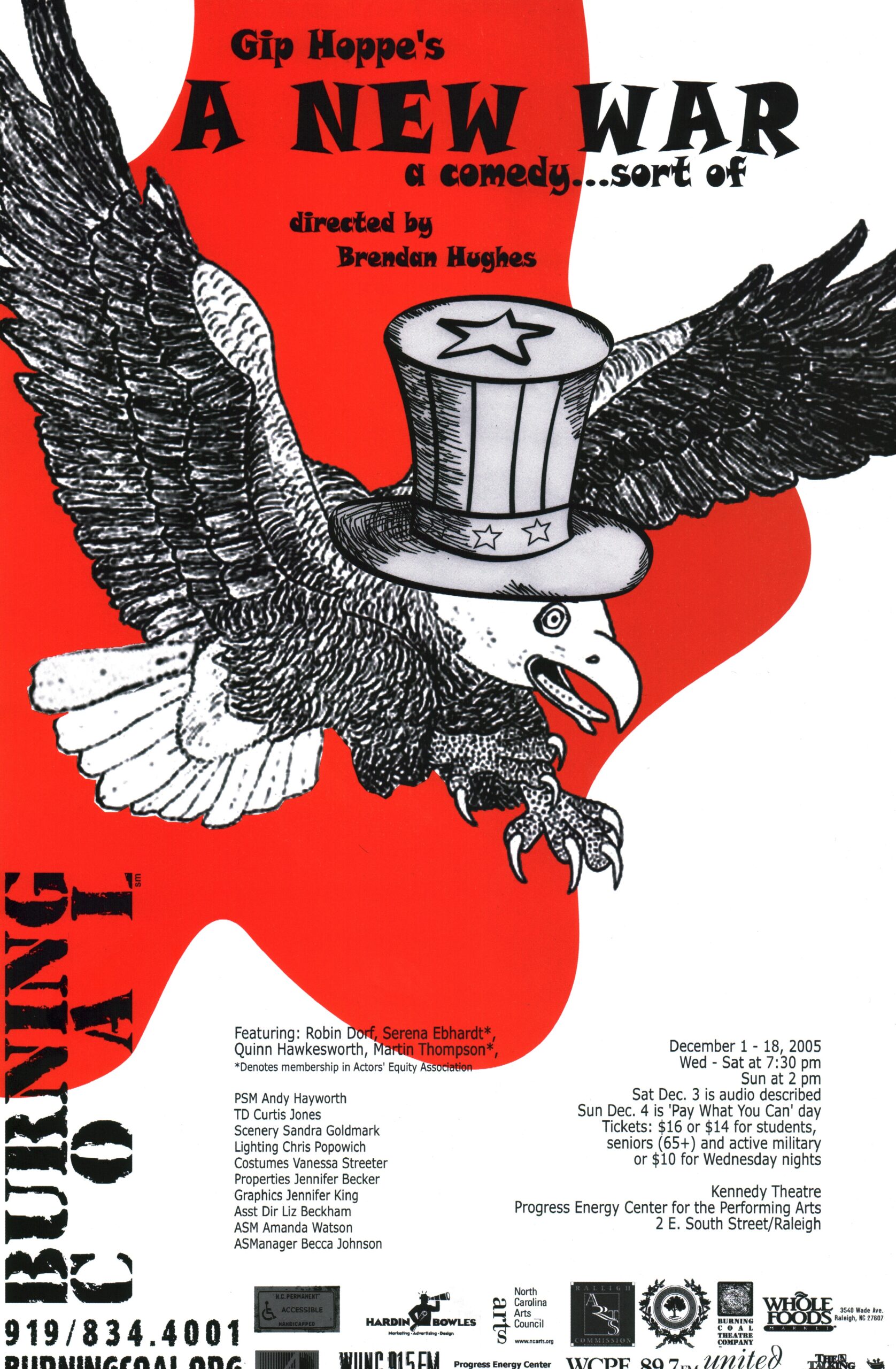
A New War by Gip Hoppe
Dir. Brendon Hughes
Dates: December 1-18 2005
Location: Kennedy Theatrre
A Map of the World
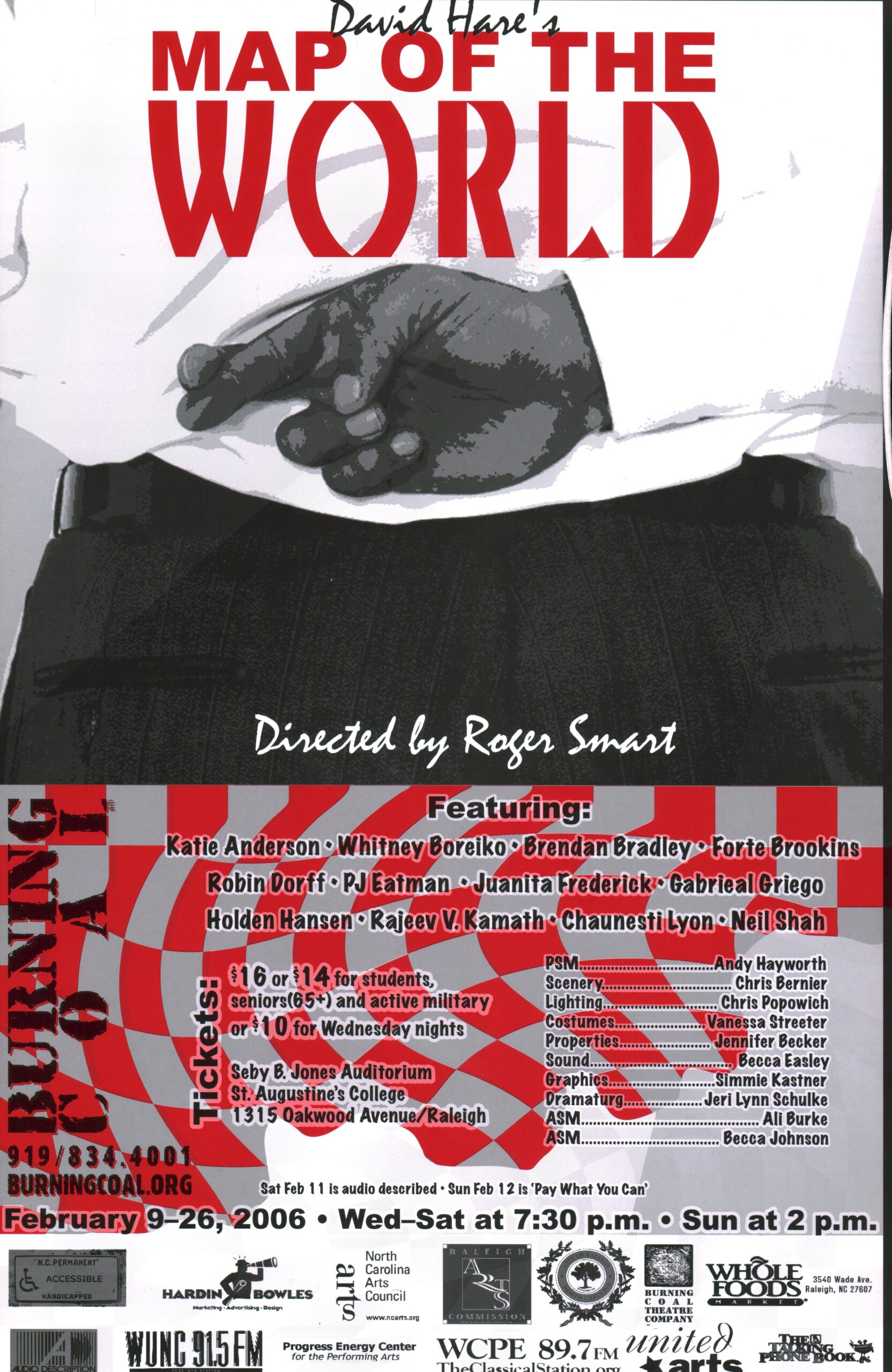
A Map of the World by David Hare
Dir. Roger Smart
Dates: February 9-26 2006
Location: Seby B. Jones Auditorium St. Augustine’s College, Raleigh
Miss Julie
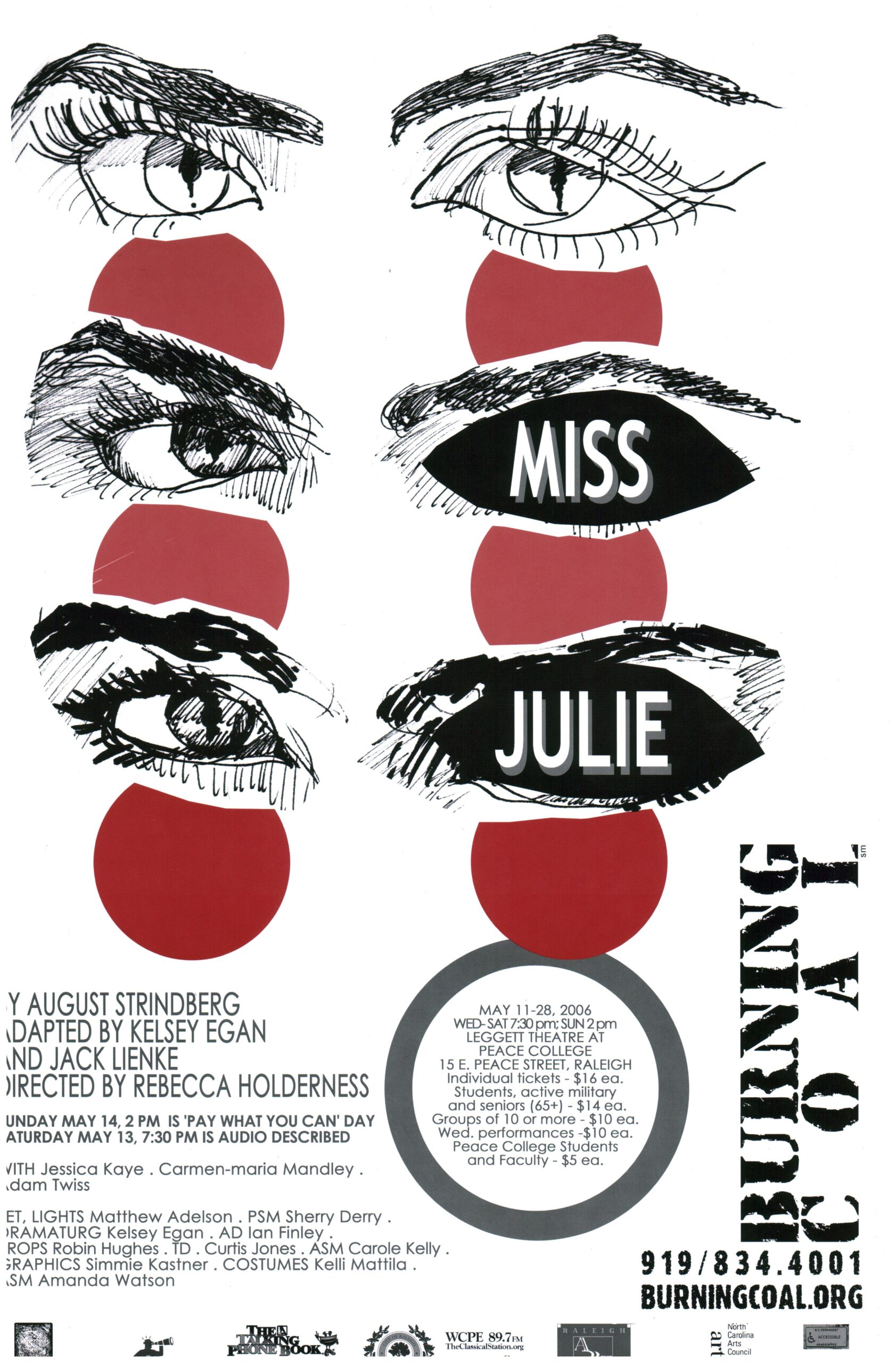
Miss Julie by August Strindberg, Adapted by Kelsey Egan and Jack Lienke
Dir. Rebecca Holderness
Dates: May 11-28 2006
Location: Leggett Theatre
The Taming of the Shrew
The Taming of the Shrew by William Shakespeare
Dir. Jerome Davis
Dates: September 15-October 2 2005
Location: Kennedy Theatrre
Crew:
Stage Manager: Andy Hayworth
Costume Design: Maggie Clifton
Sound Operator: Barbara Corbin
Scenery Design: Sonya Drum
Props: Gabriel Griego
Technical Director: Curtis JOnes
Graphics Design: Simmie Kastner
Asst. Director: Gina Kelly
Lighting Design: Cindy Limauro
Asst. Stage Manager: Vanessa Streeter
Dramaturg: Gilliam Watson
Sound Design: Joseph “Sloe” Slawinski
Cast:
Phil Crone – Baptista
Nick Berg Barnes – Petruchio
Bob Barr – Vincentio
Liz Beckham – Tranio
David Coulter – Pedant
Luke Custer – Grumio
Ian Finley – Biondello
Heather Fisher – Curtis, Attendant, Ensemble
Debra Gillingham – Katherina
Heather Hackford – Bianca
Becca Johnson – Gregory/Haberdasher/Officer/Attendant/Ensemble
Danijela Lazarevic – A Widow/Nicholas/Attendant/Ensemble
Stephen LeTrent – Hortensio
Ryan Nazionale – Lucenctio
Justin Schwartz – Nathaniel/Servant/Ensemble
Amanda Watson – A Tailor/Philip/Attendant/Ensemble
Jason Weeks – Gremio
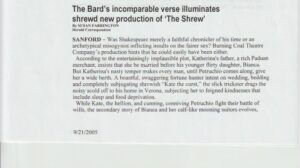
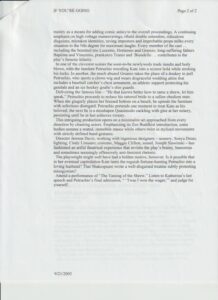
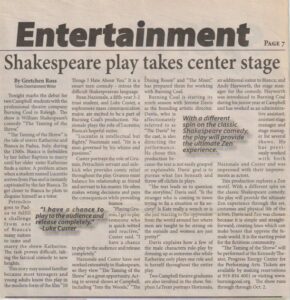
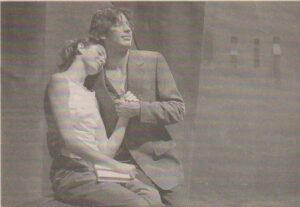
Have a fond or interesting memory of this play you’d like to share with us? We’d love to hear it!
Please Contact Us to Share!
Burning Coal Theatre
(919) 834-4001
224 Polk St., Raleigh NC 27604
Played September 15-October 2 2005: The Taming of the Shrew
A New War
A New War by Gip Hoppe
Dir. Brendon Hughes
Dates: December 1-18 2005
Location: Kennedy Theatrre
Crew:
Graphics Design: Simmie Kastner
Stage Manager: Andy Hayworth
Technical Director: Curtis Jones
Asst. Stage Manager: Becca Johnson
Scene Design: Sandra GOldmark
Lighting Design: Chris Popowich
Costume Design: Vanessa Streeter
Props: Jennifer Becker
Sound Design: J. Hagenbuckle
Sound Operator: Adam Budlong
Asst. Director: Liz Beckham
Cast:
News Man: Robin Dorff
News Woman: Serena Ebhardt
Quinn Hawksworth: Actor #1
Martin Thompson: Actor #2
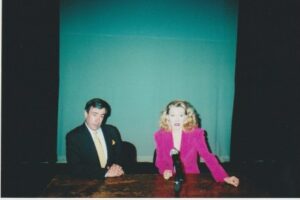
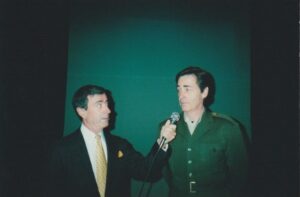
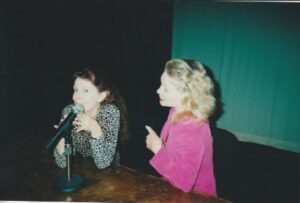
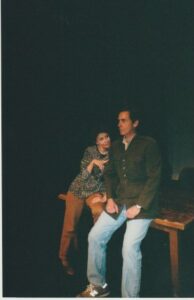
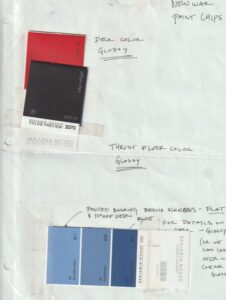
Have a fond or interesting memory of this play you’d like to share with us? We’d love to hear it!
Please Contact Us to Share!
Burning Coal Theatre
(919) 834-4001
224 Polk St., Raleigh NC 27604
Played December 1-18 2005: A New War
A Map of the World
A Map of the World by David Hare
Dir. Roger Smart
Dates: February 9-26 2006
Location: Seby B. Jones Auditorium St. Augustine’s College, Raleigh
Artistic Director’s Notes:
In Joe Papp’s prime, the Public Theatre in New York presented many new works by American playwrights: Rabe (Streamers), Shange (For Colored Girls…) along with glorious Shakespeare productions in Central Park, peopled with big American actors like James Early Jones and Colleen Dewhurst and Al Pacino. So what was Papp up to in 1985, transferring the decidedly British playwright, David Hare, straight from the decidedly British National Theatre, down to the lower East Side? Hare is a writer whose work has interested me since I sat in the darkness of the Public’s main space on Lafayette Street that night and watched the great Indian actor Roshan Seth speak the brilliant, hateful, profound, profane and entirely convincing text give to him by Hare in the searing role of ‘Victor Mehta.’ Later, I would come to realize that Mehta was one in a long chain of Hare conservative antagonists who get all the best women and all the best lines. I wanted to be like Mehta, I wanted people to hang on my every word, I wanted to enter a room and have waiters scurry to do my bidding. I wanted starlets to drop their careers for me and handsome young men to go red in the face when I came around their women. As the performance progressed, it became increasingly clear that Mehta was more of a monster than any of the piñatas Hare had painted for him to bash around – but also more of a human being. He thought, he argued, he bled – he won, and won, and won, until Hare pulled the rug and he was felled by an unexpected uppercut. Not since Ali/Spinks…!
The silence in the hall that night was like black butter, rich and hideous. Mehta had been bested by a scrub – a kid. No, not. Surely. And indeed, the god of Hare would not, could not allow the great man to lose, finally. For those men do not lose to other men. But Mehta’s victory comes at a terrible price. That night I stood and cheered for the first time in a New York audience. Jaded souls stood with me. I thrust my fist into the air. “We don’t do that here!” whispered the woman next to me. I raised it higher. “We do now,” I shouted. (Okay, I made that part up!)
David Hare is, like very few writers in our language, one who began thrashing about in his youth and has not let up, while sharpening his skills to the point where he now hits his target regularly. From the stunning My Zinc Bed, which I guess is too damned good for a New York producer to take a chance on, to the more recent Stuff Happens, in which he lays out precisely what Patrick Fitzgerald has been lugubriously trying to in his grand jury investigation, but a year earlier, to the stunning commercial success, Plenty, to the intimate Skylight to the hilarious, early Knuckle to his “State of England” trilogy to…well, you get the idea. David Hare has been producing work for thirty years that is matched in quality and quantity, over that period, by only one other that I know: Athol Fugard. And even Fugard has trailed off of late. Rolling Stone once wrote: “I guess Neil Young is the king of Rock and Roll. I don’t see anyone else standing near as tall.” Substitute David Hare and English Language Theatre and the same sentiment would apply.
Is Hare a closet Conservative? He would bristle at the thought. If you read his published diaries, you’ll get the idea that he just might be. In these works, he comes off aloof, arrogant, self-centered, and not at all sensitive. But his Conservative characters, those big, brash, thrashing bulls like Mehta and Lambert Le Roux in Pravda (Rupert Murdoch’s twin?) or Skylight’s Tom (based on Terence Conran), almost always male, Anglo or Anglo-educated (as is Mehta), middle-aged and at the very top of their game, are distinguished in that they are not at all that way. They listen, they respond, they think, they parry, they hurt. They think. The reason to do a Hare play is that this voice is absolutely in the world. It may be inside us all. To not do Hare in this day is to ignore the truth. Bring it out, hear its pitch, and do a little thinking, too. Then make your case.
Jerome Davis
Crew:
Stage Manager: Andy Hayworth
Scenery Design: Chris Bernier
Lighting Design: Chris Popowich
Costume Design: Vanessa Streeter
Props: Jennifer Mann Becker
Sound Design: Becca Easley
Graphics Design: Simmie Kastner
Asst. Stage Manager: Keith Bugner and Ali Burke
Lighting Operator: Barbara Corbin
Dramaturg: Jeri Lyn Schulke
Graphics: Karmen Piland
Cast:
Katie Anderson – Makeup Girl/Martinson’s Aide/Ensemble
Whitney Boreiko – Wardrobe Girl/Ensemble
Brendan Bradley – Stephen Andrews
Robin Dorff – Angelius
- J. Eatman – M’Bengue
Juanita Frederick – Assistant to the Film Director/Ensemble
Gabrieal Griego – Peggy Whitton
Holden Hansen – Martinson
Chaunesti Lyon – Elaine Le Fanu
Greg Paul -Waiter/Film Crew/Ensemble
Neil Shah – Victor Mehta
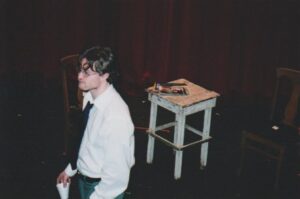
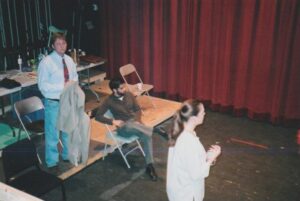
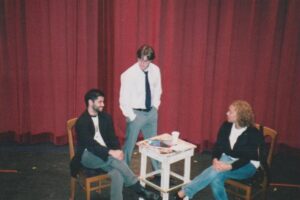
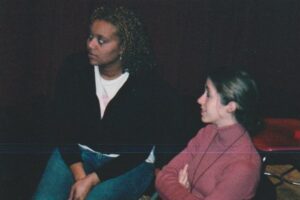
Have a fond or interesting memory of this play you’d like to share with us? We’d love to hear it!
Please Contact Us to Share!
Burning Coal Theatre
(919) 834-4001
224 Polk St., Raleigh NC 27604
Played February 9-26 2006: A Map of the World
Miss Julie
Miss Julie by August Strindberg, Adapted by Kelsey Egan and Jack Lienke
Dir. Rebecca Holderness
Dates: May 11-28, 2006
Location: Leggett Theatre
Artistic Director’s Notes:
Update on the Murphey School! Burning Coal is very near its fundraising goal to restore the historic Murphey School auditorium, located at Person and Polk. Our plan was to finish our capital campaign on June 30th, then spend about six months on buildout, which would get us into the building by January, 2007. We aren’t there yet but we are very close and I believe it is possible for us to meet this timetable. Wouldn’t that be extraordinary! However, we still need financial support to succeed. Although the end is near, if we stop now we will not succeed. IF you can help, please drop a check into the red envelope you’ll find here in your program, or call us with a visa or mastercard at 919.834.4001.
I am so looking forward to Burning Coal’s new life in the Murphey School auditorium. I want to tell you some of the things (but only some!) we have planned for the facility. In the building, we will have a fully operational coffee shop which will be open morning, noon, and night, up through performance time. We will have a small bookstore with off-beat plays and other theatre-specific publications that people can come in and read over coffee. We will be running a film series of classic movies, some of which will be “curated” to relate directly to the productions in progress. We’ll have a small space devoted to the showing of local artists’ work. We’ll have staged readings of new plays by North Carolina writers, classes for children, teens, adults and seniors. We’ll have seminars, lectures and discussions on issues of interest to the arts community. Oh, yes, and we’ll produce some great plays!!! We also hope to make the space available to other area theatres and arts organizations. In short, the Murphey School auditorium should be bursting with life. I hope you will make a contribution to our campaign.
I also want to use this space to thank Rebecca Holderness for her work with Burning Coal over the years. She directed Shakespeare’s Loves Labours Lost in our first season, Romeo & Juliet, which we toured to area schools, Einstein’s Dreams (which we will reprise in our tenth season), Travesties, A Doll House, and James Joyce’s ‘the Dead,’ as well as tonight’s Miss Julie. That’s a pretty broad range of work. Rebecca’s work is extreme in many ways, which is what I cherish about it. She pushes people, sometimes beyond what they believe to be their capacity. In twenty years of knowing and working with her, I have never yet seen her push anyone beyond their true capacity, though. She engenders respect, fear, admiration, awe, anger, focus and ultimately: work. Without her, Burning Coal would be nothing like the company it is today and I am most grateful to her for it. Rebecca, thank you for that work.
Lastly, I want to thank those core audience members (you know who you are!) without whom our little company would not exist. You will see many changes in Burning Coal in the years ahead. I hope and trust they will meet with your approval. In a profound sense, you are our company. Without you, we would only be whistling in the dark. Thank you … and come again!
Crew:
Stage Manager: Sherry Derry
Technical Director: Curis Lee Jones
Scenery and Lighting Design: Matthew Adelson
Costume Design: Kelli Mattila
Props: Robin Hughes
Graphics Design: Simmie Kastner
Dramaturg: Kelsey Egan
Asst. Director: Ian Finley
Asst. Stage Manager: Carole Kelly and Amanda Watson
Lighting Operator: Adam Budlong
Dramaturg: Dr. Assad Meymandi
Cast:
Gabriel Griego – Kristin
Jessica Kaye – Julie
Adam Twiss – Jean
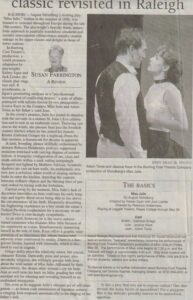
Have a fond or interesting memory of this play you’d like to share with us? We’d love to hear it!
Please Contact Us to Share!
Burning Coal Theatre
(919) 834-4001
224 Polk St., Raleigh NC 27604
Played May 11-28, 2006: Miss Julie
Season 10: (2006-2007)
1776
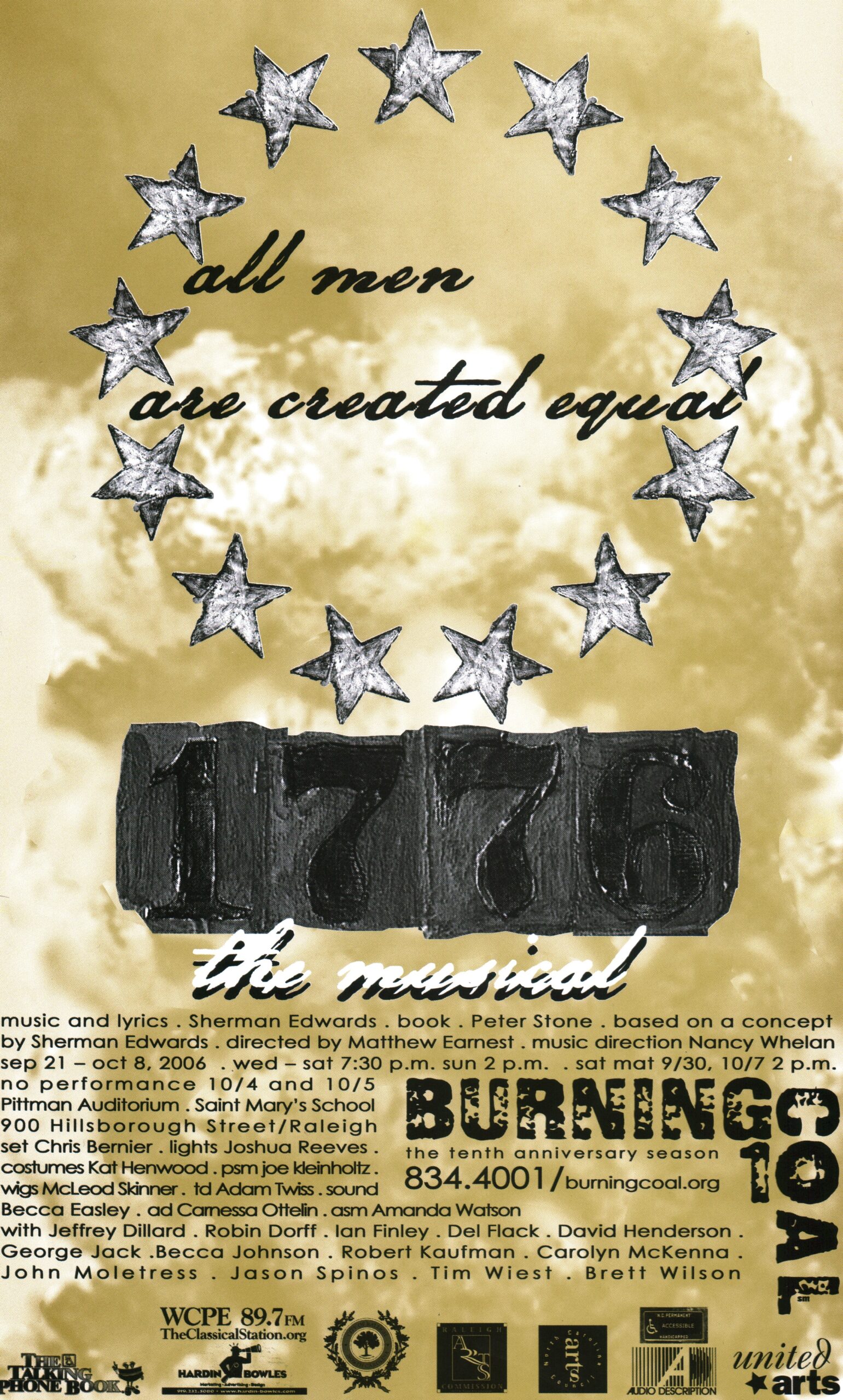
1776 by Sherman Edwards and Peter Stone
Dir. Matthew Earnest
Dates: September 21-August 8 2006
Location: Pittman Auditorium St.Mary’s School
Einstein's Dreams
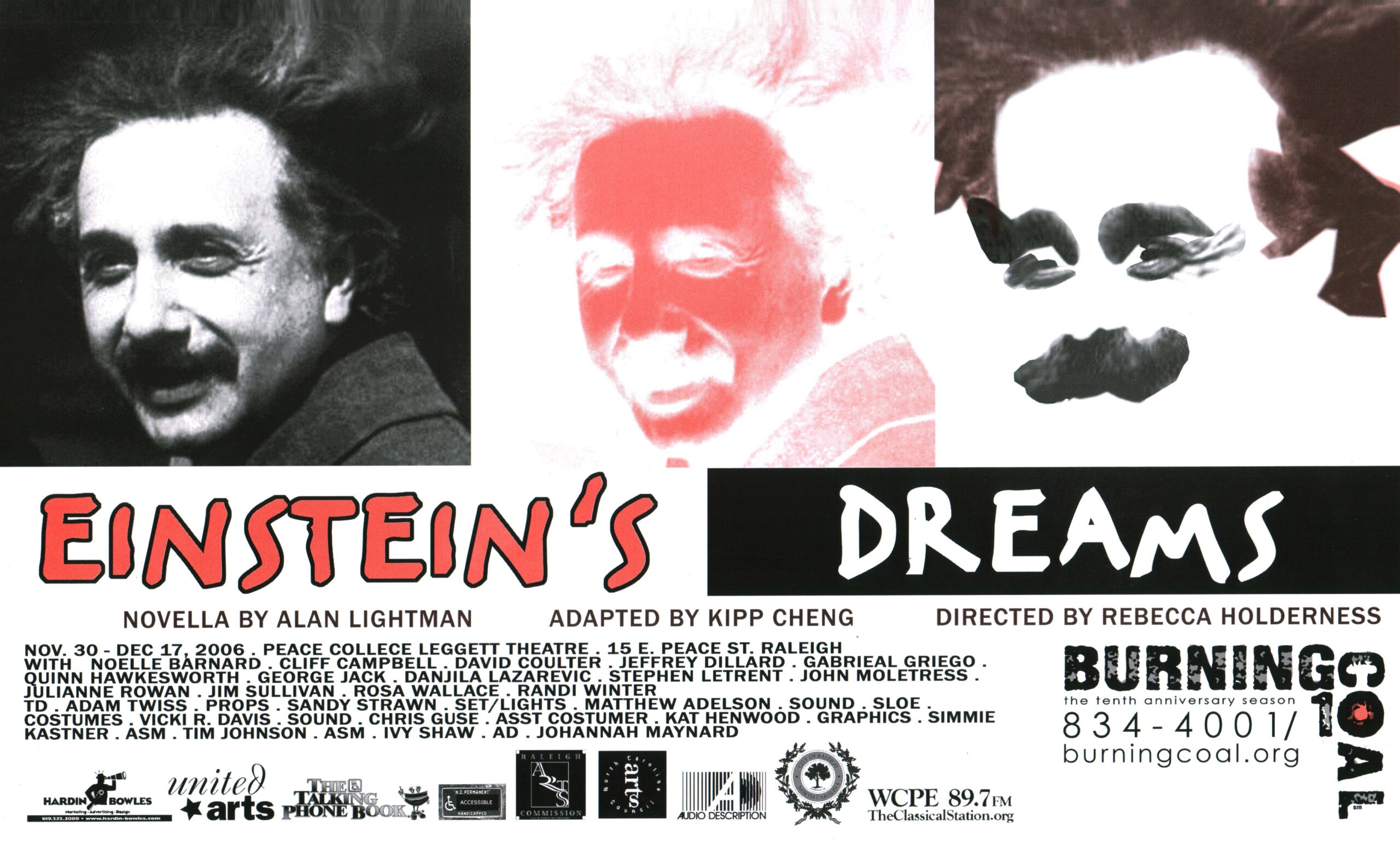
Einstein's Dreams by Kipp Erante Cheng based on the novel by Alan Lightman
Dir. Rebecca Holderness
Dates: Nov. 30-Dec 17 2006
Location: Leggett Theatre
Pentecost
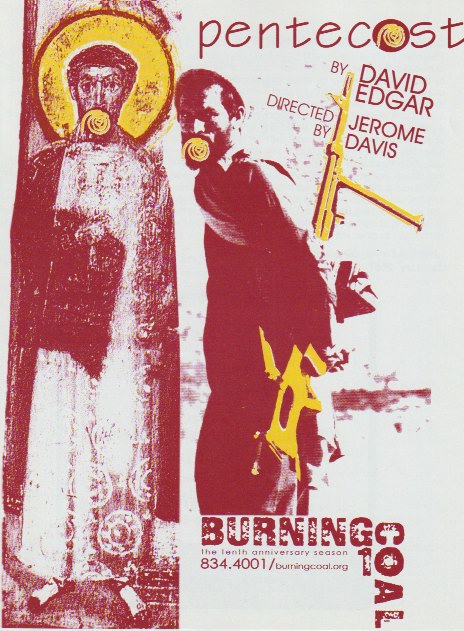
Pentecost by David Edgar
Dir. Jerome Davis
Dates: January 25-February 11 2007
Location: Kennedy Theatre
A Midsummer Night's Dream
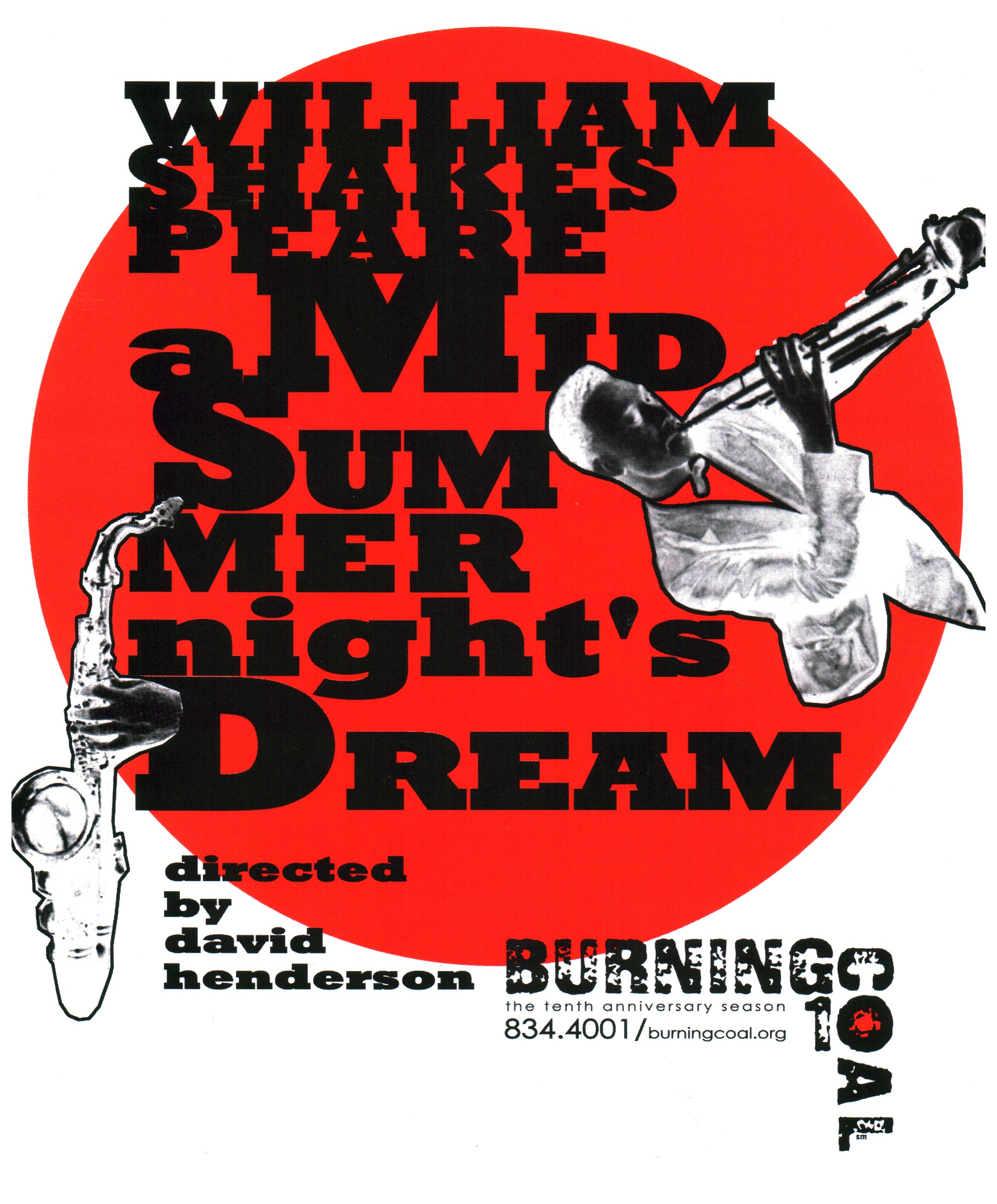
A Midsummer Night’s Dream by William Shakespeare
Dir. David Henderson
Dates: March 10-18, 2007
Location: Leggett Theatre
1776
1776 by Sherman Edwards and Peter Stone
Dir. Matthew Earnest
Dates: September 21-August 8, 2006
Location: Pittman Auditorium St.Mary’s School
Artistic Director’s Notes:
I’ve loved 1776 since I was forced to watch the film version in high school. Usually, that strategy backfired for those doing the forcing, but in this case I was smitten. Not quite yet able to appreciate the charms of Blythe Danner, I think it was William Daniels, Ken Howard, the actor who played Richard Henry Lee (I’ve long since forgotten his name) and all the men who seemed to be having such a great time. They were rocking the house. The ‘house’ happened to be congress, but nevertheless. Then, slowly, the story drew me in and I began to catch a glimmer. Even at that young age, of the terrible responsibility that running a country can and must be.
Compromise is a part of all our lives. Americans have become particularly adept at it. We rail at ethnic cleansing, but living in ‘gated communities.’ We decry cruelty animals, but buy meat products from the horrible, massive slaughterhouses located sometimes in our own back yards. We claim to abhor violence, but flock to films, music and television programs that honor the notion of vengeance with a capital V. We ‘chose life’ but drive like our lives and those of our neighbors are relatively worthless. “Compromise” is even a compromise – some might call this hypocrisy. But we are human, and we are flawed, and our flawed nature is inevitable, I suppose. What isn’t inevitable, and should not be tolerated, is compromise (or hypocrisy) as public policy.
Someone once said “Democracy is the worst form of government–except for all the others.” What is particularly troubling about Democracy are the compromises that democratic societies seem forever forced to accept. Which of us have not at some point thrown up our hands and declared “What this country needs is a benevolent dictator!” That, of course, is not what we need–and I strongly suspect that the reason no such creature has ever appeared in America or elsewhere is that there is no such thing as a benevolent dictator – that the act of assuming such a position automatically suggests such characteristics as preclude one from benevolency (My Spell Checker is telling me that there is no such word as “benevolency” but I’m going to go with it, anyway)!
In Philadelphia in a steamy courthouse in 1776, men of means gathered to consider the idea of independence from England. The issue of slavery was on the table from the start and the men in that sweltering room had to decide: is it more important to be independent or to take a stand on the issue of slavery for once and for all. History was waiting for their decision, and they knew it. Although their ultimate decision is easy to understand, one wonders just exactly what would have resulted in those original 13 colonies (or those who held anti-slavery views) standing up and saying ‘No. Nothing, but nothing, is more important than this. We will draw a line here and we will be remembered forever as the founding fathers, not of a great nation, but of a just nation.” The leaders who have followed our founding fathers to the table of public servitude have chosen the route of compromise all too often, it seems. History writes the legacy of such decisions in the blood of the least fortunate among us. Is anybody there? Does anybody care?
Jerome Davis, September, 2006
Crew:
Musical Direction: Nancy Whelan
Stage manager: Joe Keilholtz
Technical Director: Adam Twiss
Scenery Design: Chris Bernier
Lighting Design: Josh Reaves
Costumes: Kat Henwood
Sound Design: Becca Sasley
Wigs: McLead Skinner
Asst. Director: Johannah Maynard
Asst. Stage Manager: Amanda Watson
Light Operator: Adam Budlong
House Manager: Noelle Barnard
Cast:
Jeffrey Dillard – McNair/Wilson
Robin Dorff – Lee/Hancock
Ian Finley – Courier
Del Flack – Hall/Hewes/Leather APron
David Henderson – Adams
George Jack – Franklin
Becca Johnson – Martha/Morris
Robert Kaufman – Dickinson
Carolyn McKenna – Abigail/Chase
John Moletress – Jefferson
Jason Spinos – Painter/Hopkins
Adam Twiss – Rutledge
Tim Wiest – Livingston/Witherspoon/Rodney
Al Singer – Thomson/Sherman
Katie Beaver – Violin
Mike Mole – Trumpet
John Ruggero – Percussion
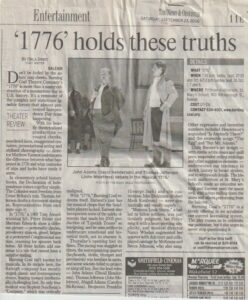
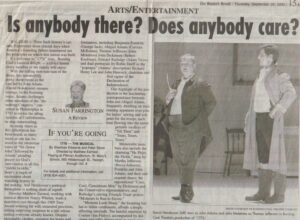
Have a fond or interesting memory of this play you’d like to share with us? We’d love to hear it!
Please Contact Us to Share!
Burning Coal Theatre
(919) 834-4001
224 Polk St., Raleigh NC 27604
Played September 21-August 8, 2006: 1776
Einstein's Dreams
Einstein’s Dreams by Kipp Erante Cheng based on the novel by Alan Lightman
Dir. Rebecca Holderness
Dates: Nov. 30-Dec 17 2006
Location: Leggett Theatre
Director’s Notes:
In 1998 I was commissioned by Burning Coal Theatre to create a theatrical adaptation of Alan Lightman’s popular book. Working with Princess Grace Award-winning writer Kip Erente Cheng, I created Einstein’s Dreams, which has now been produced six times under my direction on four different stages in three states.
The book presents dreamscapes that illustrate Einstein’s interrogation of and theories about time. Lightman’s book, while presenting moving and beautiful imagery to stage, provided no direct narrative to adapt or dramatic events to extract. When presented in the context or service of a dramatic action, however, visual imagery becomes the key to exposing psychological truth with great impact, speed and specificity.
My collaborator, Kipp Erente Cheng, and I created a framing play which shows Einstein searching for the daughter that he may or may not have had, while at the same time his friends, son and wife search for the truth of their relationship to an Einstein bruised in his work. These three threads – lost daughter, dreaming genius and abandoned family – move towards each other over time. Time is represented as happening in multiple lines as Einstein’s children and Einstein are represented at the same age, his age at the discovery of E=mc^2, 26 years old. The passage of time is the emotional ground where guilt, need and desire all combat. In this adaptation of a novel, not a dramatic play, the dreams become an exploration of heightened inner states.
The play uses iconic objects – a black board, a desk, a sheaf of papers and chairs. The chairs are expressive of each character in the chorus, which is cast as widely as possible to represent the community of humankind. Chairs are a low order of stage object, homely and worn. In this case each chair is as different as each human is different. Since the ideas expressed in the dreams and play are abstract or emotional, the objects the actors connect to should be familiar and unique to them. These objects are combined in different patterns and ways during the play, providing fluid locations where the dream action takes place.
Cheng and I left the play with open frames, places for adaptation to each production. So, while each production of the play is similar in its visual and dreamlike style, each can expand and contract to fit a new theater or community. This openness and adaptability has helped give the production its longevity and national exposure. Using a familiar tool – the drama and narrative of a family – Einstein’s Dreams is an example of how an audience and actors can connect and inhabit an unexpected vision.
Rebecca Holderness
Crew:
Technical Director: Adam Twiss
Props: Sandy Strawn
Set and Light Design: Matthew Adelson
Sound: Joseph “Sloe” Slawinski
Costumes: Vicki R. Davis
Sound: Chris Guse
Graphics Design: Simmie Kastner
Asst. Stage Manager: Tim Johnson and Ivy Shaw
Asst. Director: Johannah Maynard
Asst. Costumer: Kat Henwood
Cast:
Noelle Barnard – A Woman
Quinn Hawkesworth – Liserl
Phillip Muntz – Einstein
Jeffrey Dillard – Mileva
Gabrieal – Ana
Stephen LeTrent – Hans
David Coulter – Besso
George Jack- Another Man
John Moletress – Eduard
Jeffrey Dillard – An Old Woman
Robert Bartusch – A Man
Randi Winter – A Girl
Have a fond or interesting memory of this play you’d like to share with us? We’d love to hear it!
Please Contact Us to Share!
Burning Coal Theatre
(919) 834-4001
224 Polk St., Raleigh NC 27604
Played November 30-December 17, 2006: Einstein's Dreams
Pentecost
Pentecost by David Edgar
Dir. Jerome Davis
Dates: Jan 25-Feb 11 2007
Location: Kennedy Theatre
Artistic Director’s Notes:
Pentecost is one of my favorite plays and I am delighted to be able to bring it to you. Again. We closed our first season with this epic, unsure of what to expect, and were delighted and amazed by the reception the play received from its overflow audiences – especially since we did it in an unairconditoned gymnasium in North Raleigh – in a very hot June, 1998. It is not an easy play to do, as you will see, and not an easy one to digest–but it is an important piece of work that seems, unfortunately, to resonate more and more with the passage of time. Although it is set in a particular time and place (the Balkans immediately following the fall of the Iron Curtain), it is about an idea that echoes throughout history and indeed seems to be endemic to human nature. The idea is, of course, that those of us who “look like me” are somehow better, intrinsically, than those who “look like you.” It is also about art and about the courageous human spirit that stands amidst the kind of turmoil and violence that was unleashed in this region in the early 1990s and continues to play throughout the world and says “Yeah, well, here’s a better way.” Our President has used phrases like “road map” and “the way forward” regularly. IF anyone asked me (and they haven’t), I would say: “Here, in this play, is the way forward.” It is a tale of sacrifice, of selfishness and of a few souls who somehow find within themselves the capacity to change. In other words, it is a song of hope.
Jerome Davis, January, 2007
Crew:
Stage Manager: Christine Rapp
Technical Director: Adam Twiss
Scenery Design: Robert John Andrusko
Lighting Design: Matthew Adelson
Costumes: Kat Henwood
Sound Design: Joseph “Sloe” Slawinski
Props: Laurie JOhnson
Asst. Director” Lori Mahl
Asst. Stage Manager: Mary Misertino and Victoria Tucci
Light Operator: Gina Kelly
Sound Operator: Barbara Corbin
House Manager: Gillian Watson Egan
Technical Asst. Adam York and Heather Williams
Cast:
Lynne Guglielmi Barbour -Toni
Tony Cormier – Oliver Davenport
Robin Dorff – Czaba/Nico
Ian Finley – Karolyi
Olivia Griego – Yasmin
Quinn Hawkesworth – Anna Jedlikova
Vincent Lamberti – Leo Katz
Torrey Lawrence – Antonio
Stephen Letrent – Raif/Soldier
Becca Johnson – Amira
Melissa Patterson – Cleopatra
Greg Paul – Bojovic/Commando
Ashley Quinones – Tunu
Ivy Shaw – Secretary/Fatima
Al Singer- Grigori/Soldier
Jenn Suchanec – Gabriella Pecs
Amanda Watson – Marina/Girl/Commando
Jason Weeks – Pusbas/Abdul
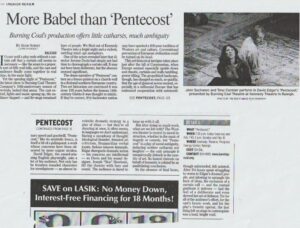
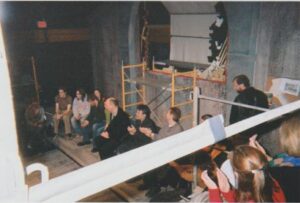
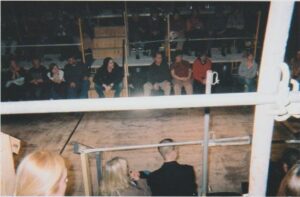

Have a fond or interesting memory of this play you’d like to share with us? We’d love to hear it!
Please Contact Us to Share!
Burning Coal Theatre
(919) 834-4001
224 Polk St., Raleigh NC 27604
Played January 25-February 11, 2007: Pentecost
A Midsummer Night's Dream
A Midsummer Night’s Dream by William Shakespeare
Dir. David Henderson
Dates: March 10-18, 2007
Location: Leggett Theatre
Artistic Director’s Notes:
At Burning Coal, many of our values have been learned over the last ten years. Thank you for the open dialogue we have seen you joyously participate in during that time. As artistic director, I think part of my job is to listen. Being a member of that peculiar species the homo sapien, I don’t always reach that goal. Keep reminding me.
But on this occasion, I want to talk about some of the values that we brought with us, Simmie and I. Things that were and remain at the foundation of Burning Coal. They are in no particular order, and they are not, by any means, all-inclusive.
First, we believe the written word is, or should be at the core of all Burning Coal’s work. Although we, most of us, can verbally communicate our ideas, it is only on the written page that those ideas enter into the dialogue of history. The ideas of an American revolution, and all that entailed, had been talked about and dreamed for years. But only when it was written down did it become manifest. The science behind the Theory of Relativity existed long before Einstein put it to paper. But once he did, it became integrated into the larger consciousness.
Second, we believe in the integration of space. We believe that the audience space and the world of the play are, or should be, as often as possible, the same space. When an actor walks onstage, she or he is alive, breathing, sweating, thinking, doing. To arbitrarily decide: here is where one world ends and the other begins cuts against the advantage that live theatre has over other forms of media. For instance, on film, or on the more aptly named “boob tube,” the possibilities are fixed, limited. Those images are over and done with. They are past. And on some level every one who sees them knows this. When a live actor walks onto a stage, he or she is both present and future. We lean forward, wanting, needing to be told. But told what? How to live? How to pass away the time we have been allotted? How we are doing? Or what we ought to be doing? I don’t know the answer to that, but I do know that each time I enter a theatre, that expectation, that hope rises in me.
Finally, and this is probably evident to you by now: I really believe in ‘the theatre.’ I believe it is a holy place, a place where people gather in the expectation of being enlightened. What a joyous idea that is… and what a responsibility for the artist. In each of this season’s offerings, you have seen a story about a person or persons who took action – then had to live with the consequences of that action. Jefferson and Adams, Einstein, the refugees from Pentecost who helped “tear down the wall.” But tonight, in the final play of our first ten years in Raleigh, we present Shakespeare’s A Midsummer Night’s Dream. I chose this place for this occasion because it is a play that essentially says that in art, as in love, anything is possible. And you never, ever know when, or where, or how it is going to happen. To paraphrase the old beer commercial: “This one’s for you!”
Jerome Davis, January 2007
Crew:
Stage Manager: Tiffany Ivy
Technical Director: Adam Twiss
Scenery and Lighting Design: Chris Bernier
Costumes: Maggie Clifton
Sound Design: Jeremy Allen
Props Design: Laurie Johnson
Graphics Design: Simmie Kastner
Asst. Director: Becca JOhnson
Asst. Stage Manager: Mary Misertino and Melissa Patterson
Sound Operator: Barbara Corbin
Costuming Asst.: Liz Bradford
Discussant and Dramaturg: Dr. Assad Meymandi
Cast:
Loren Armitage – Snug
Mary Helen Floyd – Helena
Holden Hansen – Oberon/Theseus
Joel T. Horton – Lysander
Gina Kelly – Moth
Stephen Letrent – Demetrius
Carl Martin – Bottom
Allan Maule – Starvling
Carolyn McKenna – Titiana/Hippolyta
Brittany T. Montgomery – Cobweb
Philip Mutz- Puck
Ashlee Quinones – Hermia
Mike Raab – Flute
Will Sarratt – Philostrate
Ivy Shaw – Mustardseed
Al Singer – Peter Quince
Sam Whisnat – Snout
Christine Zagrobeiny – Peaceblossom
Have a fond or interesting memory of this play you’d like to share with us? We’d love to hear it!
Please Contact Us to Share!
Burning Coal Theatre
(919) 834-4001
224 Polk St., Raleigh NC 27604
Played March 10-18, 2007: A Midsummer Night's Dream
Season 11: (2007-2008)
Hamlet
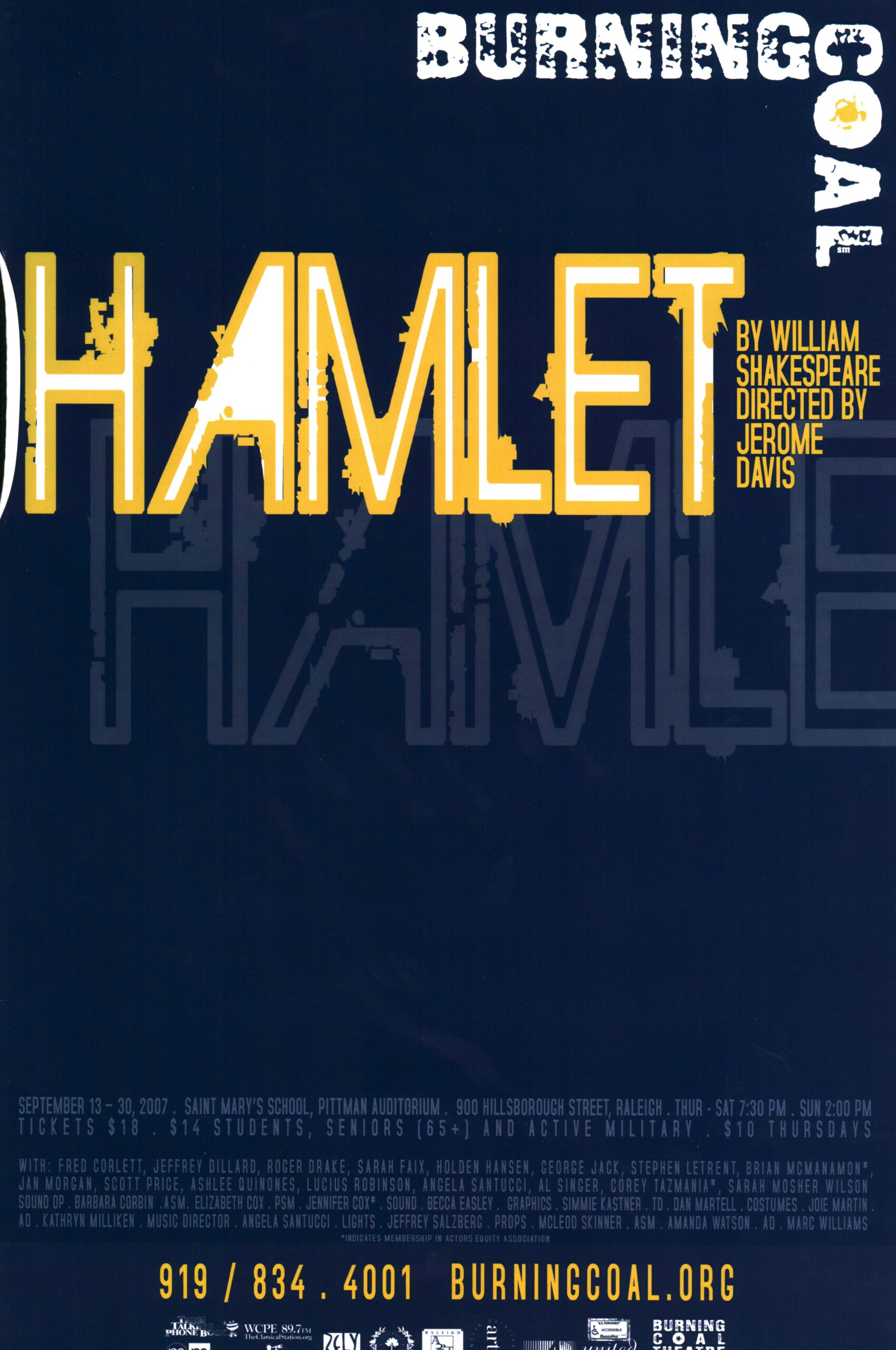
Hamlet by William Shakespeare
Dir. Jerome Davis
Dates: September 13-30 2007
Location: Saint Mary’s School’s Pittman Auditorium
The Love Song of J. Robert Oppenheimer
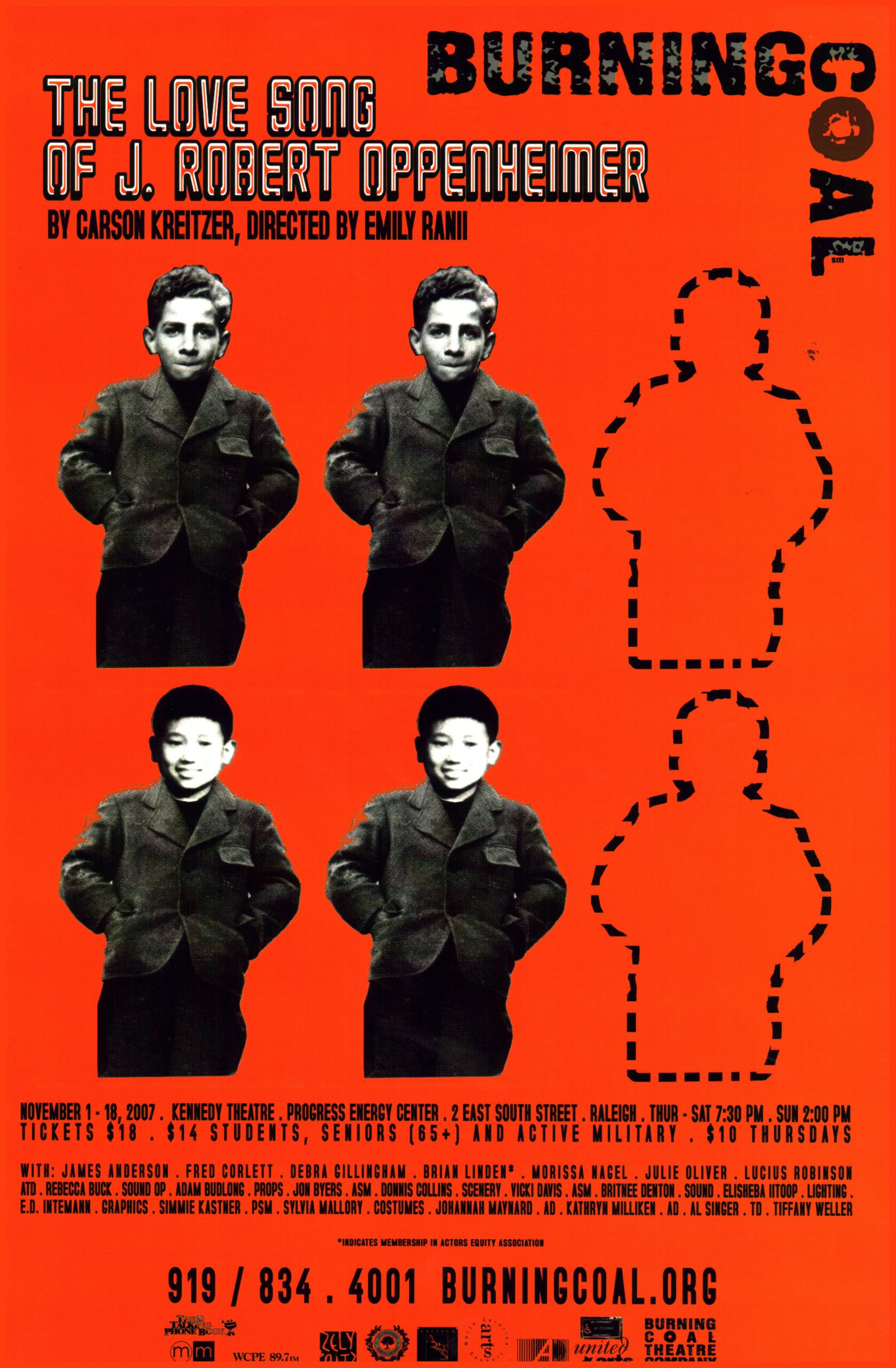
The Love Song of J. Robert Oppenheimer by Carson Kreitzer
Dir. Emily Ranii
Dates: November 1-18 2007
Location: Kennedy Theatre
Inherit the Wind
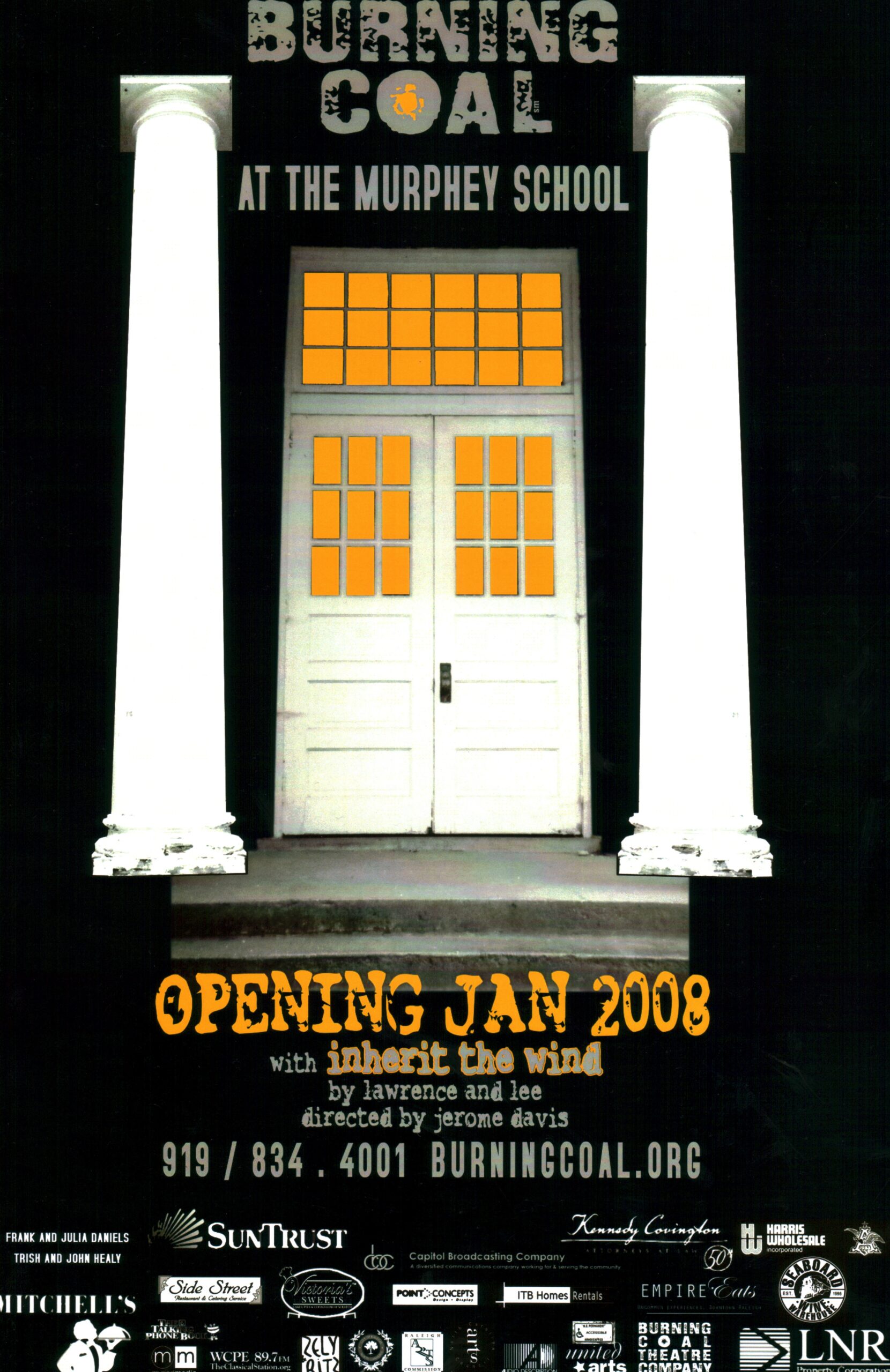
Inherit the Wind by Lawrence & Lee
Dir. Jerome Davis
Dates: January 31-February 1, 2008
Location: Murphey School
Crowns
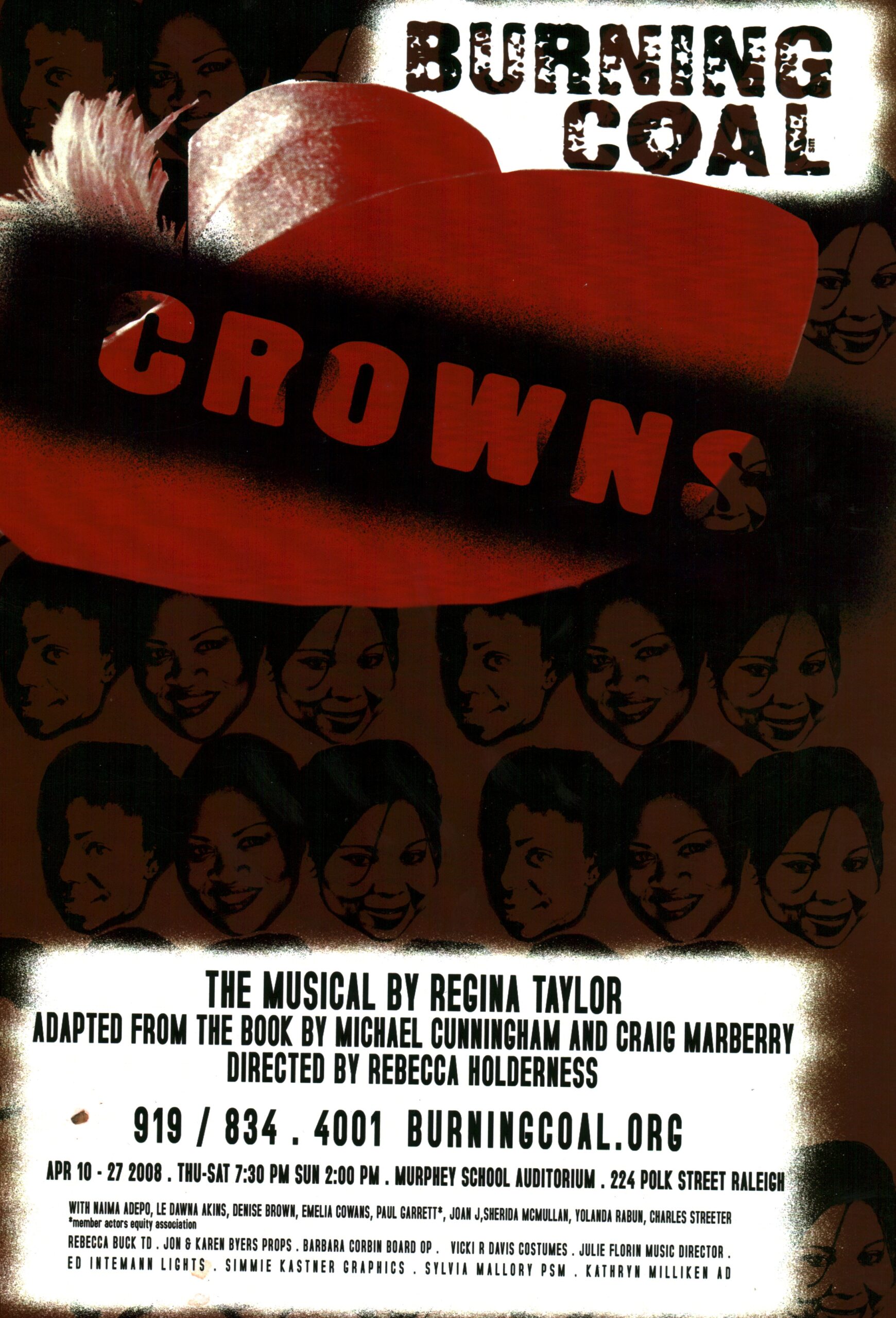
Crowns by Regina Taylor adapted from the book by Michael Cunningham and Craig Marberry
Dir. Rebecca Holderness
Dates: April 10-27 2008
Location: Murphey School
Hamlet
Hamlet by William Shakespeare
Dir. Jerome Davis
Dates: September 13-30 2007
Location: Saint Mary’s School’s Pittman Auditorium
Crew:
Graphics Design: Simmie Kastner
Scenery Design: Chris Bernier
Lighting Design: Jeffrey Saltzberg
Costume Design: Joie Martin
Props: McLeod Skinner
Stage Manager: Jennifer Cox
Asst. Stage Manager: Amanda Watson, Andy Bovay, Kathryn Millikem
Sound Operator: Barbara Corbin
Asst. Director: Marc Williams
Cast:
Brian McManamon – Hamlet
Holden Hansen – Claudius
George Jack – Polonius
Jeffrey Dillard – Horatio
Stephen LeTrent – Laertes
Al Singer – Lucianus/Voltimand/Francisco/Grave Digger/A Captain
Roger Drake – Ghost/Cornelius/A Gentleman
Scott Price- Osric/Rosencrantz/Marcellus
Lucius Robinson – Guildenstern/Bernardo/Grave Diggwr
Angela Santucci – A Priest/Player Queen
Sarah Mosher Wilson – Second Player
Saeah Faix – Reynaldo/First PLayer
Jan Morgan – Player King
Corey Tazmania – Gertrude
Ashlee Quinones – Ophelia
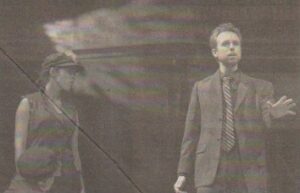
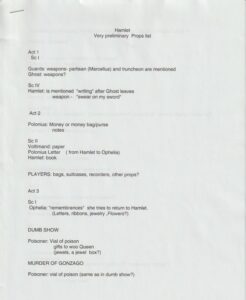
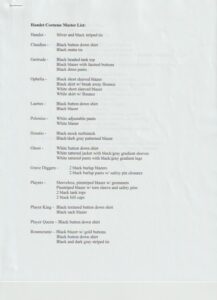
Have a fond or interesting memory of this play you’d like to share with us? We’d love to hear it!
Please Contact Us to Share!
Burning Coal Theatre
(919) 834-4001
224 Polk St., Raleigh NC 27604
Played September 13-30, 2007: Hamlet
The Love Song of J. Robert Oppenheimer
The Love Song of J. Robert Oppenheimer by Carson Kreitzer
Dir. Emily Ranii
Dates: November 1-18 2007
Location: Kennedy Theatre
Artistic Director’s Notes:
In a marriage, a new thing is created. In order to build a solid marriage, it has been said that you need “Something old, something new, something borrowed and something blue.” Is that an old wives’ tale, or some kind of miracle mix? I don’t know, but it is spot on for me and for the Burning Coal Theatre company right now, as we say “I do” to the future.
This play marks the beginning of something new: the professional debut of a young director, Emily Ranii, who began with Burning Coal at the ripe age of 13. How the time has flown, and how proud I am to provide her this first of what I am confident will be many, many such opportunities for her. Emily: Godspeed!
This play marks something old, too: for it is the last time (knock on wood) that we will be presenting in the magnificent Kennedy Theatre. We’ll be moving up the road into our own space, the Murphey School, for our next play, Inherit the Wind, which opens at the end of January. But as I look back, I wonder: where would our company be without this space? Please say a word of thanks to its namesakes, K.D and Sara Lynn Kennedy if you have the chance. And here’s to the next young upstarts who wander in here and find such an accommodating, welcoming home.
Something borrowed? Well just look around. This is theatre, after all. Most of the set, costumes and props would fall under that category.
Something blue? Yours truly. I always find myself misty-eyed at the end of something, and at the beginning of another. And so I find myself now, watching all the new and all the old mix and mingle here at this precipice in time.
The Love Song of J. Robert Oppenheimer is about such a moment, too. It is the perfect play for me, right now, for it is about a moment in time when the human race demonstrably had the opportunity to turn in one direction or another. The degree to which such decisions often (always?) fall into the lap of one well-meaning person, in this case, Oppie, is both alarming and encouraging. For with that idea comes the possibility that the answer, the decision is not preordained. We can and do have a choice. The bomb was built on good reasons. Then hubris, ego took over. It is arguable whether the bomb was dropped for good enough reason. But what is inagruable is that in using that weapon, a hinge moment in history occurred. A marriage occurred – between hope and expediency. And from that moment to this we have been a different people. I think Carson’s play suggests that there is a price to pay for such decisions. I hope that it also suggests that the knowledge gained can lead us forward.
Jerome Davis
October 2007
Crew:
Stage Manager: Sylvia Mallory
Technical Director: Tiffany Weller
Scenery Design: Vicki E. Davis
Lighting Design: E.D. Intemann
Costume Design: Johannah Maynard
Props: Jon Byers
Sound Design: Elisheba Ittoop
Graphics Design: Simmie Kastner
Asst. Director: Kathryn Milliken, Al Singer
Asst. Stage Manager: Donnis Collins
Costumes Asst: Ashlee Quinones
Board Operator: Adam Budlong
Technical Director Asst.: Rebecca Buck and Matt Spann
Cast:
James Anderson – Edward Teller
Fred Corlett – Rabi
Brian Linden – J. Robert Oppenheimer
Lucius Robinson – Strauss
Julie Oliver – Jean
Debra Gillingham – Lilith
Morissa Nagel – Kitty Oppenheimer
Have a fond or interesting memory of this play you’d like to share with us? We’d love to hear it!
Please Contact Us to Share!
Burning Coal Theatre
(919) 834-4001
224 Polk St., Raleigh NC 27604
Played November 1-18 2007 : The Love Song of J. Robert Oppenheimer
Inherit the Wind
Inherit the Wind by Lawrence & Lee
Dir. Jerome Davis
Dates: January 31-February 1, 2008
Location: Murphey School
Crew:
Lighting Design: Matthew Adelson
Technical Director: Rebecca Buck
Props: Jon Byers
Board Operator: Barbara Corbin
Scenery Design: Vicki R. Davis
Sound Design: Becca Easley
Graphics Design: Simmie Kastner
Asst. Stage Manager: Rebecca Kudgus
Costumes: Johannah Maynard
Asst. Director: Kathryn Milliken
Music: Angela Santucci
Asst. Technical Director: Matt Spann
Cast:
Leo Grant Brody – Howard Blair
Madeline Taylor – Melinda Loomis
Tara Polhemus – Ensemble
Jenn Suchanec – Rachel
Ian Finley – Meeker/Reuters
Stephen LeTrent – eBertram Cates
John Honeycutt – Mr. Goodfellow/Dr.Keller
Debbie Strange – Mrs. Krebs
Bob Galbrath – Rev. Jeremiah Brown
Sid Harrell – Sillers/Dr. Paige
Lonny Friedman – Phil/Dunlap/Aaronson/Photographer
Ryan Brock -Bannister/ Radoman
Edna Lee Figueroa – Mrs. Loomis
Erin Caulfield _Mrs. Mclain/Juror
Regina Hinman – Mrs. Blair
Holden Hansen – E.K. Hornbeck
Fred Corlett – Mayor/Reporter
David Dossey – Matthew Harrison Brady
Laura Jenkins – Mrs. Brady
Al Singer -Tom Davenport
David Henderson – Henry Deummond
George Jack – Judge
Shaun Schneider – Timmy/Hot Dog Man/Reporter/ Hawker
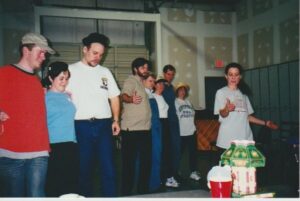
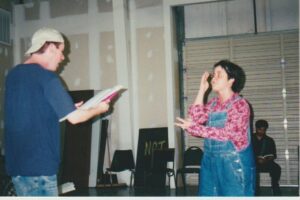
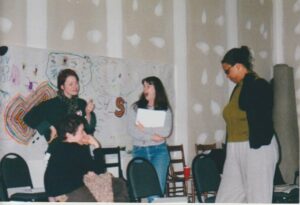
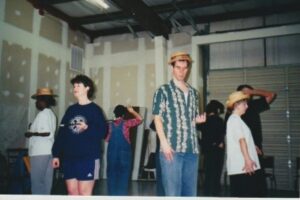

Have a fond or interesting memory of this play you’d like to share with us? We’d love to hear it!
Please Contact Us to Share!
Burning Coal Theatre
(919) 834-4001
224 Polk St., Raleigh NC 27604
Played January 31-February 1, 2008: Inherit the Wind
Crowns
Crowns by Regina Taylor adapted from the book by Michael Cunningham and Craig Marberry
Dir. Rebecca Holderness
Dates: April 10-27 2008
Location: Current Location at Murphey School
Artistic Director’s Notes:
All Fugard plays address the issue of Apartheid. He was raised in the shadow of this source. His collaborations with Zakes Mokae, Yvonne Bryceland and the Market Street Theatre were not only revolutionary in their politics, but illegal under the strictly segregationist Apartheid law. Blacks and whites were not allowed to attend public events together, least of all theatre. Imagine sitting in the tiny, darkened theatre as lights rose on one of Fugard’s brilliant early plays: The Blood Knot, Swizwe Banzi is Dead, Statements Made After an Arrest Under the Immorality Act. The chance of a battalion of armed police in riot gear crashing through the door and hauling you off to prison was high. There you would sit, without charges being filed or a trail date being fixed. Your crime: watching a play in the company of someone not of your own race. This scene was played out over and over in the Apartheid era in South Africa late into the 1980s. It is a wonder that Fugard exists at all, a wonder that he wasn’t shunted away in some dank cell and tortured or murdered or just forgotten. That he survived and that his work survives is a testament to the indomitable human spirit. It is a shining example of how a person of peace can influence the world in a positive way. Recent similar examples include the playwright Vaclav Havel, who became President of Czechoslovakia and led his nation away from totalitarianism, Nelson Mandela himself, who sat in a prison for decades, never losing hope that one day he would walk forth and lead his nation into a brighter figure, George Mitchell, the American political figure who has rolled up his sleeves and made significant progress toward a peace treaty in Northern Ireland and Sister Helen Prejean, the Louisiana Nun who has fought the good fight against the injustices of the Death Penalty, as currently applied in the United States. Fugard belongs among this group. He stood up and stood out when expediency would have dictated otherwise. He did not raise a gun or a sword against the oppressive regime – he raised a pen. He carefully avoids writing propagandistic plays. His characters are whole, three dimensional, especially the ones with views contrary to his own. He fights to understand them because he knows that no real understanding can be found ont he road to denial, to self-congratulations and dismissal of opposing viewpoints. He imagined a world in which people of differing races, ethnicities, religions, and cultures would try to understand each other, not wipe each other from existence. Then he set out to make such a reality. There are plenty of forces fighting int he other direction today: in the Middle East, the former Soviet states, Sri Lanka. That Fugard, Mandela, the late Stephen biko and their brothers and sisters have succeeded to the degree that they have in South Africa is an amazing example of the power of peace and art. It is also a ringing condemnation of those who would take up the sword as an answer to all ills.
Jerome Davis, January, 2002
Crew:
Technical Director: Rebecca Buck
Props: Jon and Karen Byers
Board Operator: Barbara Corbin
Costume Design: Vicki R. Davis
Music Director: Julie Florin
Lighting Design: ED Intemann
Graphics Design: Simmie Kastner
Stage Manager: Sylvia Mallory
Asst. Director: Kathryn Milliken
Cast:
Emelia Cowans – Velma
LeDawna Atkins – Wanda
Joan J – Mother Shaw
Paul Garrett – Older Man/Preacher/Procession Leader
Delton Streeter – Younger Man/Yolanda’s Brother
Naima Adedapo – Yolanda
Yolanda Rabun – Mabel
Sherida McMullan – Jeanette
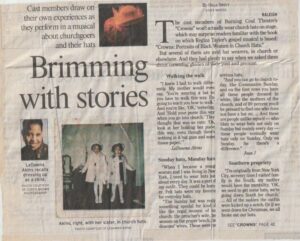
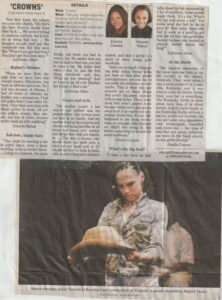
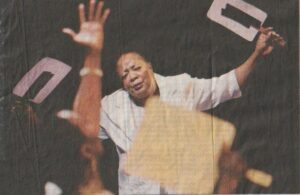
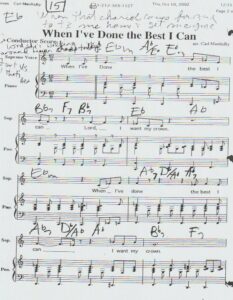
Have a fond or interesting memory of this play you’d like to share with us? We’d love to hear it!
Please Contact Us to Share!
Burning Coal Theatre
(919) 834-4001
224 Polk St., Raleigh NC 27604
Played April 10-27 2008: Crowns
Season 12: (2008-2009)
The Prisoner's Dilemma
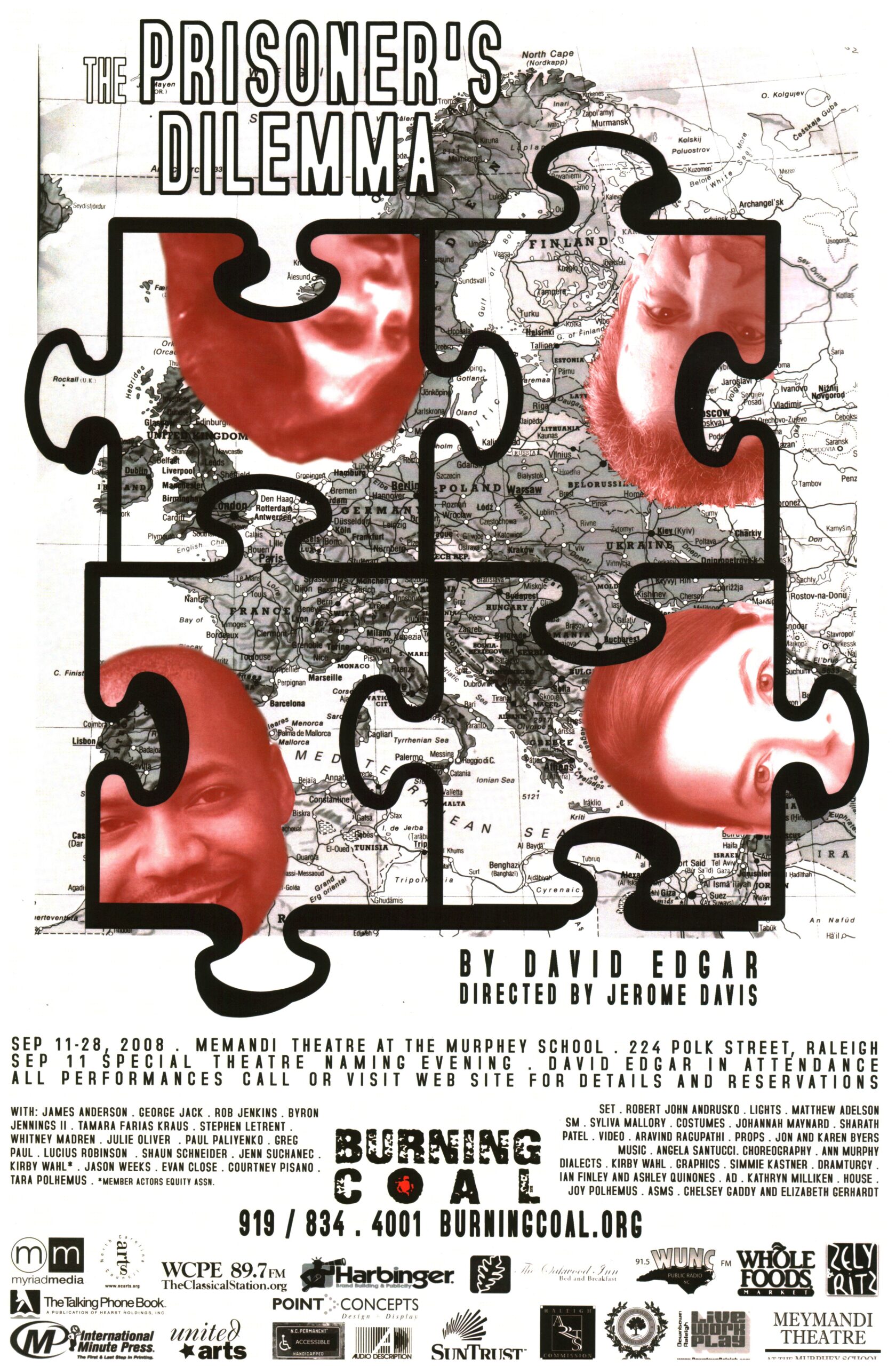
Prisoner’s Dilemma by David Edgar
Dir. Dir. Jerome Davis
Dates: September 11-28, 2008
Location: Murphey School
Hysteria
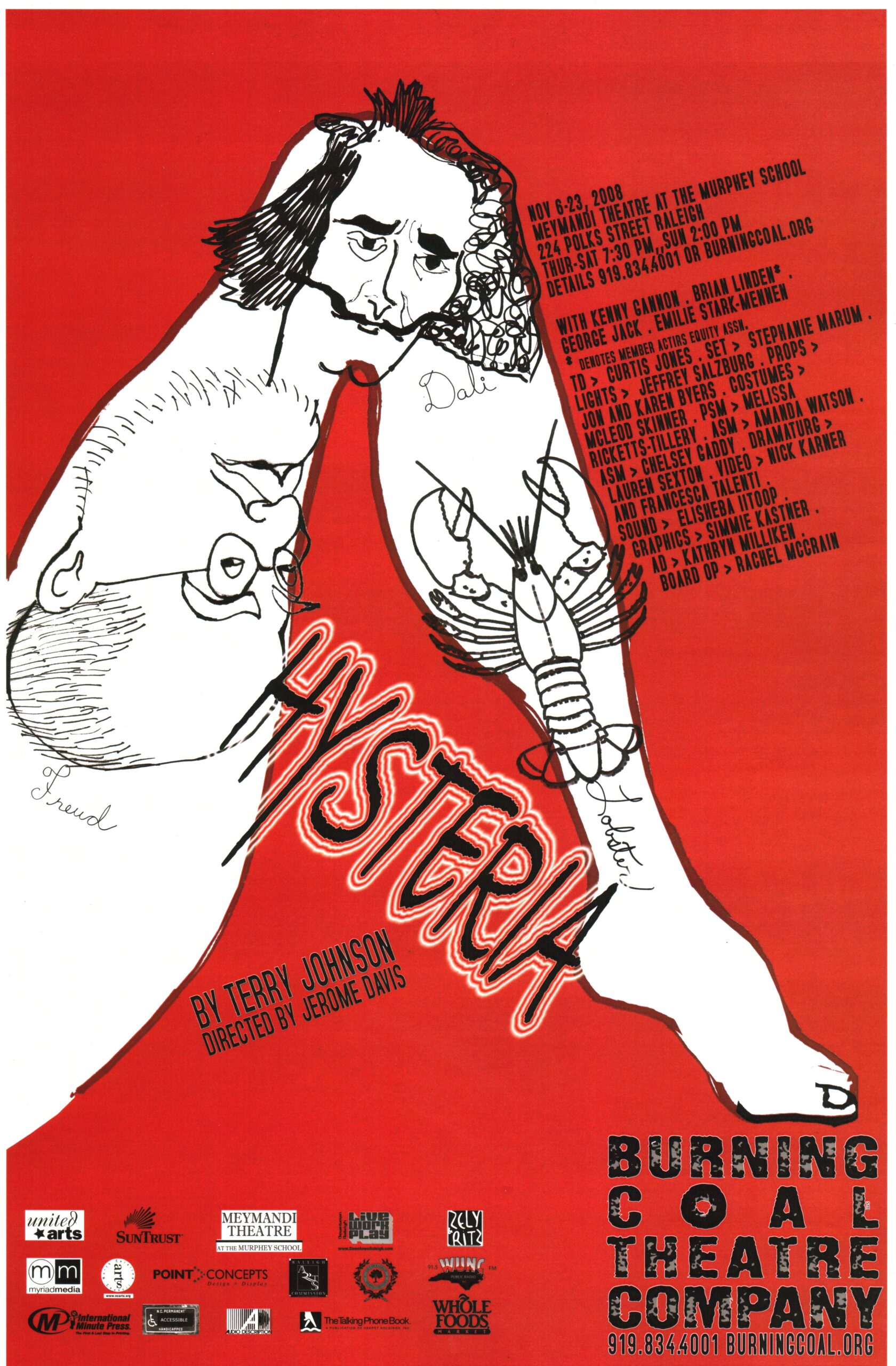
Hysteria by Terry Johnson
Dir. Jerome Davis
Dates: November 6-23, 2008
Location: Murphey School
Twelfth Night
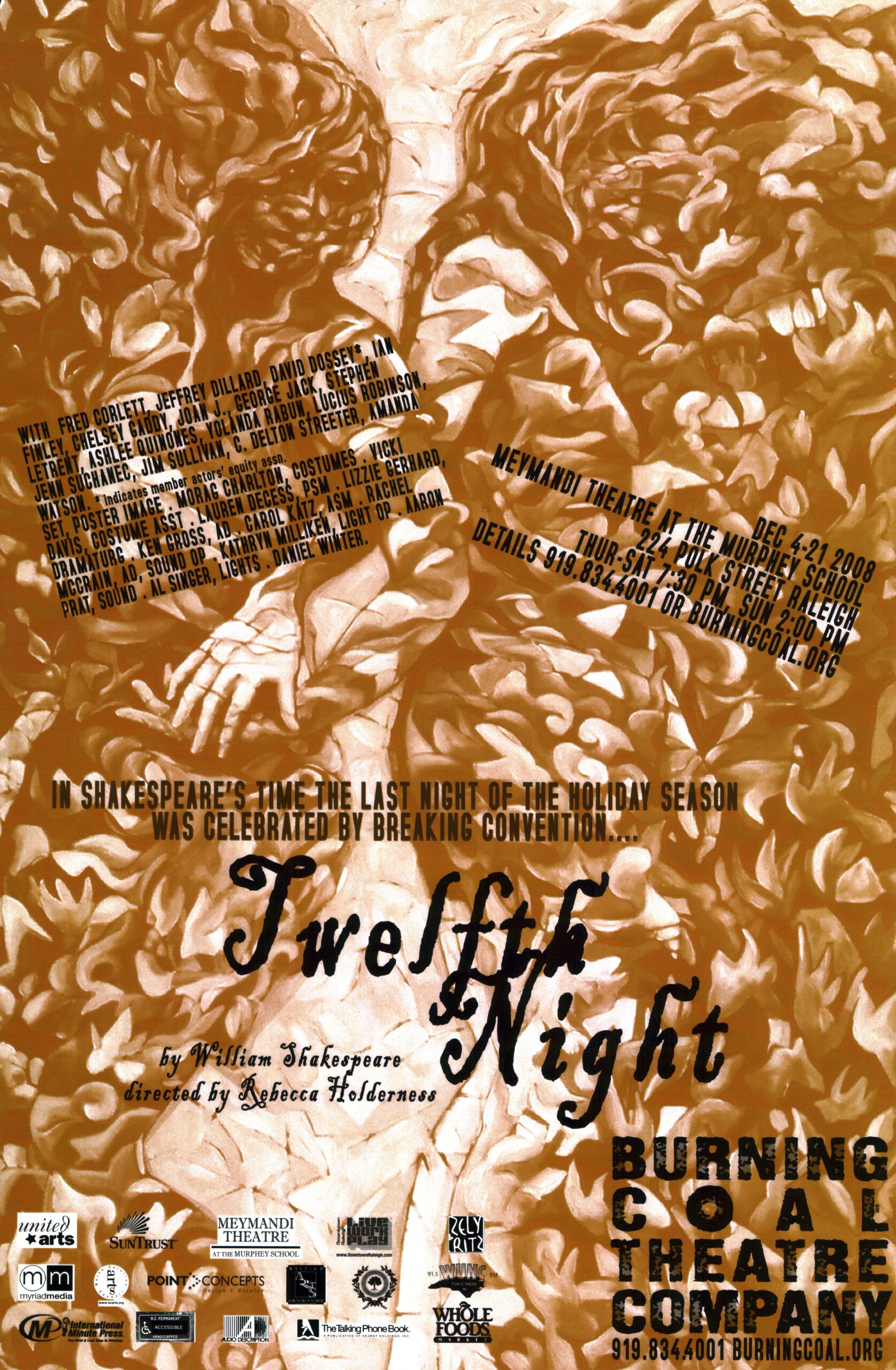
Twelfth Night by William Shakespeare
Dir. Rebecca Holderness
Dates: December 4-21 2008
Location: Murphey School
Way to Heaven
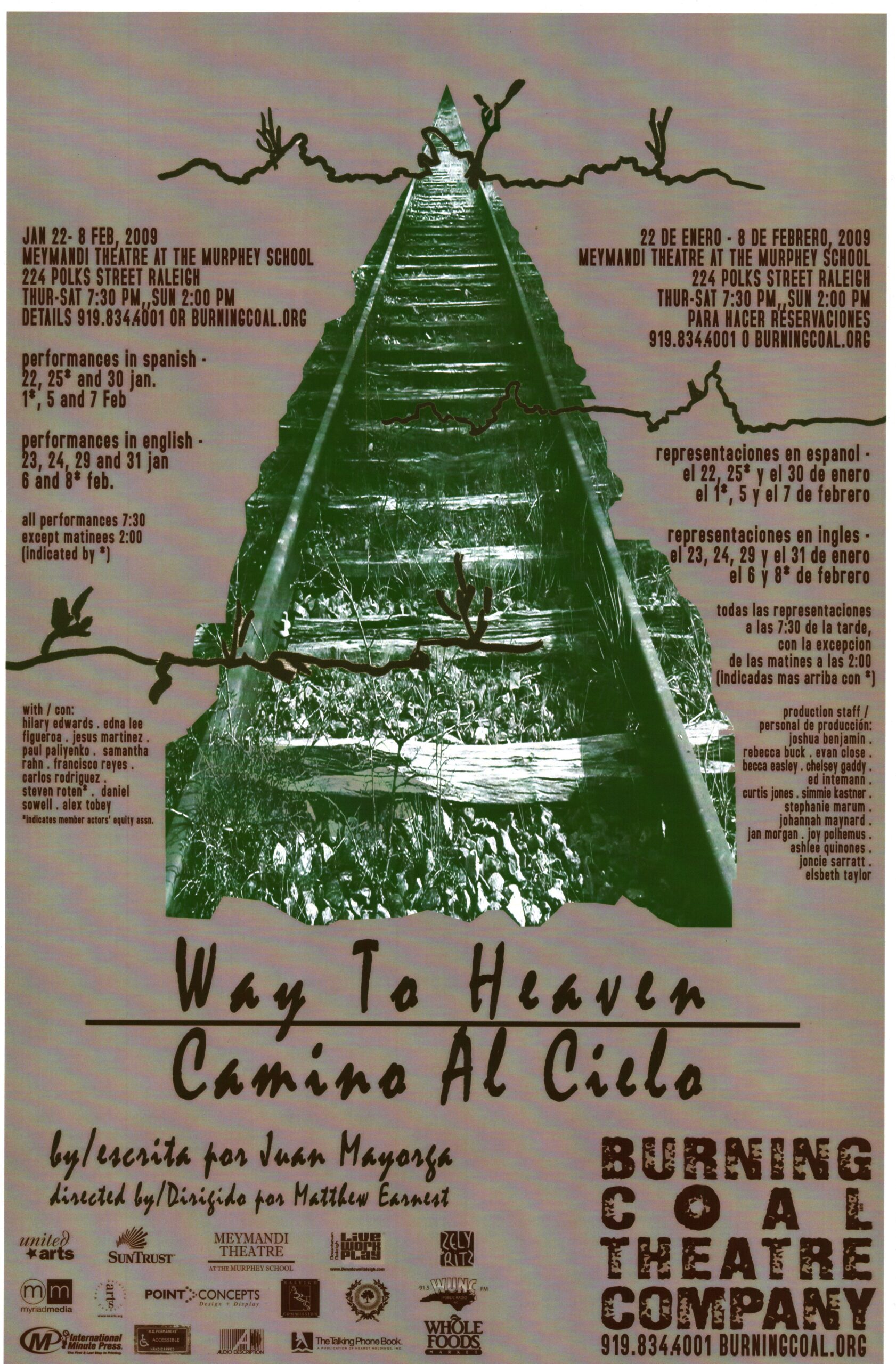
Way to Heaven by Juan Mayorga, Adapted by David Johnson
Dir. Matthew Earnest
Dates: January 22-February 8, 2009
Location: Murphey School
1960
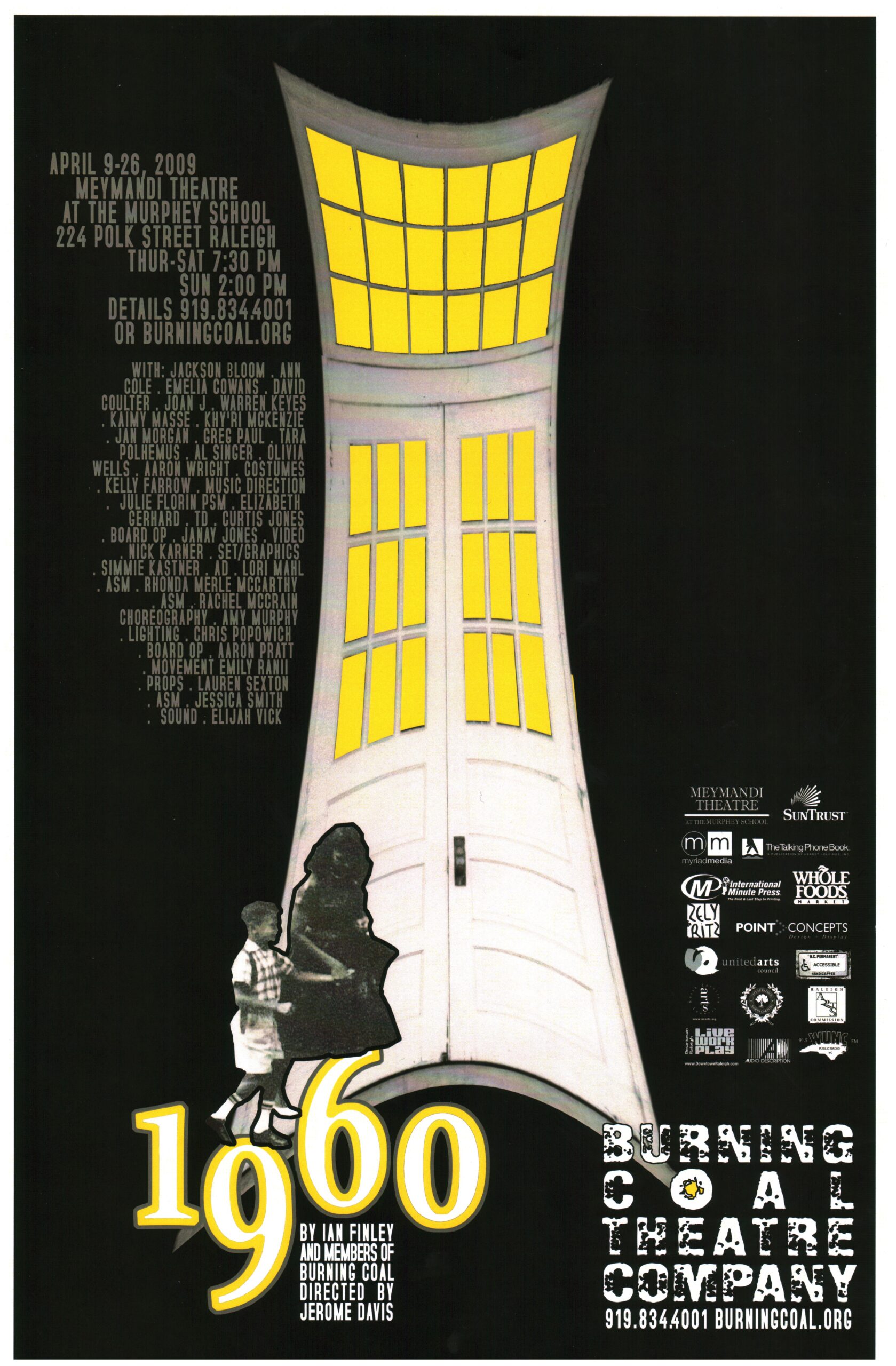
1960 by Ian Finley and Members of Burning Coal
Dir. Jerome Davis
Dates: April 9-26 2009
Location: Murphey School
The Prisoner's Dilemma
Prisoner’s Dilemma by David Edgar
Dir. Jerome Davis
Dates: September 11-28, 2008
Location: Murphey School
Artistic Director’s Notes:
We may forget seven years after the attacks of September 11th that the years immediately preceding that horrifying day were full of hope, progress, accomplishment. That hope began on November 9, 1989, when the Berlin wall was turned, over night from the significant iconic image of the post war Soviet machine, a system that saw to the murders of more than 20 million people and to the murdered dreams fo countless more, into a harmless reminder that the will of a people will always find a way over, around and through the limitations superficially imposed by governors who seek to restrain the human spirit.
Okay. Got that. But what of the years in between 11/9 and 9/11? In their book on the subject, America Between Wars, Derek Chollet and James Goldgeier suggest that the great failing of George H.W. Bush’s presidency was his lack of “the vision thing.” Bush stated as much on more than one occasion, and instead chose to his own intrinsic interest in calm, rational, yes prudent, and thoughtful movements. That was commendable, certainly so in light of the alternatives. But I find it interesting that neither the then-President, nor anyone in his cabinet, nor anyone in the media were clearly able to articulate “the vision thing” for a post Soviet empire world. In short, the people who are supposed to be leaders for the free world were caught with their pants down. The Clinton administration strove to define America’s objective post-Soviet Union, but Madeline Albright and the rest landed on the idea of America as “indispensable nation,” which certainly codified this country’s (self?) importance but did nothing to provide a roadmap forward. Comfortable to plan for an eternal Cold War, these bright minds had no idea what to do, indeed do not seem to have spent time contemplating “what if we win.” That is a failure of leadership and it is a failure that can be laid at the feet of many leaders who had the opportunity to fashion something more positive from the fall of the Iron Curtain than the realities we see today. This failure of leadership is not entirely unexpected, of course. We continue, at least in America, to look around the room, find the person there who has been most successful at enriching themselves over the course of their life, and trot them out as political candidates with the wall-eyed expectation that they will turn on a dime and develop the skills, the interests, the humanity needed to be successful at enriching the rest of us. That it seldom ever happens should surprise no one. Still, in the late moments of the 1980s and into the early 1990s, a real opportunity existed. Little fires seemed to be springing up all over the globe, though, and neither Bush 41 nor Mr. Clinton, his successor, nor the U.N, which of course had been created to lead this type of world forward, were able to successfully douse the flames. They buckled to pressure from polls, from the media, from corporate interests, from the military and from other countries with divergent interests, David Edgar’s play asks, then, if anything could have been done to fashion from this tumultuous period in history a real and lasting peace, founded upon justice for all, and if so, just exactly what? That is a question worth contemplating as we go forward into the post-9/11 world. The play also suggests that what just a few years back seemed like past history, may yet prove to have been prologue to what’s to come.
Jerome Davis
Crew:
Stage Manager: Sylvia M. Mallory
Technical Director: Curtis Lee Jones
Scenic Design: Robert John Andrusko
Lighting Design: Matthew Adelson
Costume Design: Johannah Maynard
Sound Design: Sarath Patel
Animation Design: Gino Barzizza
Props: Jon and Karen Byers
Music Supervisor: Angela Santucci
Movement Director: Amy Murphy
Dialect Coach: Kirby Wahl
Graphics Design: Simmie Kastner
Dramaturgs: Ian Finley and Ashlee Quinones
Asst. Director: Kathryn Milliken
Fight Director: Kathryn Milliken
House Manager: Joy Polhemus
Asst. Stage Manager: Chelsey Gaddy and Elizabeth Gerhard
Board Operator: Rachel McCrain
Asst. to the Costumer: Magdalena Muszynska
Cast:
James Anderson – Roman/2nd Kavkhazian Soldier
George Jack – President Yuri Vasilevich Peetrovian
Rob Jenkins – Nikolai Shubkin/Lou
Byron Jennings II – Patterson Davis/Len
Tamara Farias Kraus – Kelima
Stephen LeTrent – al Bek/Young Man
Whitney Leigh Madren – 1st Orderly/Sailor/Emela
Julie Oliver – Floss Weatherby
Paul Paliyenko – Tom Rothman/Father
Greg Paul – 1st Drozhdan/Trevelyan/Bodyguard/Zelim/1st Paramilitary
Lucius Robinson – James Neil/2nd Drozhdan/2nd Paramilitary
Shaun Schneider – Jan/Boy/Aslan
Jenn Suchanec – Gina Olsson/Mother
Kirby Wahl – Hasim Majdani/1st Kavhazian Soldier
Jason Weeks – Erik
And the children: Evan Close, Courtney Pisano, Tara Polhemus
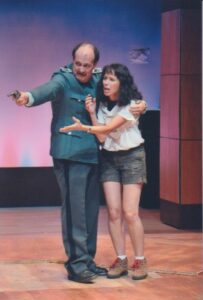

Have a fond or interesting memory of this play you’d like to share with us? We’d love to hear it!
Please Contact Us to Share!
Burning Coal Theatre
(919) 834-4001
224 Polk St., Raleigh NC 27604
Played September 11-28, 2008: The Prisoner's Dilemma
Hysteria
Hysteria by Terry Johnson
Dir. Jerome Davis
Dates: Nov 6-23, 2008
Location: Murphey School
Artistic Director’s Notes:
We see the man crossing the room. We see the banana peel. We calculate that his trajectory will carry directly … whoops! Crash! Cue laugh.
Slamming doors. Banana peels. Pants down. Hiding in the closet. Mistaken identities. Split britches. Priests. A cat’s yelp. Crustaceans. Red-faced men. The element of surprise. The common understanding that brings the audience into the world of the play – makes them complicit in the goings on. This is a farce! This is all farce. The result: a good laugh. Laughing is fun. Laughing with a group is therapeutic. Laughing at a group…is something else. Laughing at other people’s misfortune is as old as recorded history. As long as the group is standing on the other side of the room and their misfortune is insignificant. Ahh. There is the problem. Who gets to decide what is insignificant?
There has always been a need to laugh. In order to laugh, we have to have something to laugh at. It helps if that something is shared, has as its basis a common understanding. He is thick. She is loose. They are ill-matched. The sky is falling! The stock market is crashing! Which of that is funny? Which is scary? Which brings with it a stone-dead-silent, nary a titter, uncomfortable moment? The answer, it seems, depends upon the audience, the time, the place, the culture.
In parts of the world we are seeing an extraordinary clash. The kind of head-on crash that causes one to wince or, in farce, to guffaw. One culture feels with all certainty that freedom of expression is the only way for humankind to proceed. Another culture says “Not so fast. Not when it is about our God. We and we alone get to define that God and you may not even represent him onstage or on the page.
Are we innocent of such thoughts in the West? Or do we merely protect different gods? For the last 40 odd years we have narrowed the number of “groups” against whom comedy may be directed. This is a reaction to centuries of colonization and racial and patriarchal hierarchies. The tide has turned, the moment has shifted, and now we find comedy directed at the ‘other’ group – those on the other side of the room. Is this fair? Not by any rational standard. Is it necessary? Well, there you may have an argument. The part that disturbs me is that it seems to be unrecognized in our culture, unspoken. For, surely, the tired old idea of a pendulum, swinging one way and then, by definition, back the other way, even harder, is an irrational objective for both sides and one that can only lead to more and more pain and suffering.
Terry Johnson’s play looks squarely at the idea of a hinge moment in history. The movement from one way of thinning to another, alternative way. We stand here now at such a moment, watching with delight or dismay, depending on whether that pendulum is moving away from you or straight at you. I think his play is also looking for a way to stop that swinging scythe, or to reach up and grab it, rip it right out of the air and start afresh. It asks the question: in a moment like this can we find a way to not yet again trip on that old, rotten banana peel?
Crew:
Stage Manager: Melissa Ricketts
Technical Director: Curtis Lee JOnes
Scenic Design: Stephanie Marum
Lighting Design: Jeffrey Salzberg
Costume Design: McLeod skinner
Sound Design: Elisheba Iitoop
Video Design: Drancestca Talenti and Nick Karner
Props: Jon and Karen yers
Graphics Design: Simmie Kastner
Dramaturg: Lauren Sexton
Asst. Director: Kathryn Milliken
House Manager: Joy Polhemus
Asst. Stage Manager: Chelsey Gaddy and Amanda Watson
Board Operator: Rachel McCrain and Elsbeth Cassandra Taylor
Guest Lecturer: James R. Weiss, M.D
Cast:
Kenny Gannon – Freud
George Jack – Yahuda
Brian Linden – Dali
Emilie Stark-Menneg – Jessica
Have a fond or interesting memory of this play you’d like to share with us? We’d love to hear it!
Please Contact Us to Share!
Burning Coal Theatre
(919) 834-4001
224 Polk St., Raleigh NC 27604
Played November 6-23, 2008: Hysteria
Twelfth Night
Twelfth Night by William Shakespeare
Dir. Rebecca Holderness
Dates: December 4-21 2008
Location: Murphey School
Artistic Director’s Notes:
It is hard to remember that Shakespeare’s plays were once “new works.” One of my favorite things about Shakespeare in Love was the beautiful moment when Will read his just-completed play about star-crossed lovers to his actors. The film allowed us to hear that story as if for the first time. Some may remember another fantastic moment from that Oscar-winning film, when the Tom Stoppard/Marc Norman-penned screenplay lurches from a telling of R&J into a different tale: that of a shipwrecked maiden, cast upon the sundrenched shores of a strange land. Gweyneth Paltrow’s character, in that most theatrical moment, changed from “Juliet” to “Viola” and we began the tale known as Twelfth Night. I loved that movement, when the movie completely remade itself. I think Stoppard and Norman were getting at the idea, expressed in Harold Bloom’s The Invention of the Human, that humankind was reinvented through the storytelling of William Shakespeare.
This idea interests me a great deal” that we are able to define and redefine ourselves through the stories we choose to tell and the way in which we tell them. I don’t think it is unusual, for instance, that as the industrial revolution swept across the west, the stories we told became more about the encroachment of mechanization onto the human psyche (Jules Verne, Sophie Treadwell). In the 1960s, with the rise of feminism as a significant political voice, and the sexual revolution, we saw the emergence of the ‘anti-hero’ and the severe lessening of content restrictions (as typified by the court case fought and won by London’s ROyal Court Theatre against the English Office of the Censor over Edward Bond’s play Saved).
In Twelfth Night, Viola dons (masculine) garb in order to protect herself while she passes through a strange land. That is precisely what happens each time our culture ratchets forward into some new definition of itself. The storytellers among us, in whatever medium they practice, sense these shifts and respond to them. Then the culture follows after. This isn’t life imitating art, or art imitating life, but rather art serving life. Shakespeare’s Twelfth Night was written just at the moment when exotic news of the New World was reaching Europe and everyone there was amazed at the possibilities such a New World might entail. Shakespeare had it right in telling Viola’s journey and Stoppard and Norman had it right again in Shakespeare in Love.
For me, a larger issue, and one that everyone should be conscious of is this: in the 21st century, does mass media and the urgency of advanced degrees from Yale (for instance) so filter out voices of descent and from nonstandard environments (remember that Shakespeare was essentially a poor, uneducated “country boy”) that the artists most sensitive to those seismic shifts are removed from the public’s awareness, to simply holler in the dark? Time and again I find myself pulled toward a certain kind of artist. My worry is that if an artist were to emerge so unique that his worldview might alter the progress of humankind, would we know it? If another Shakespeare blossomed right under foot, would we recognize him or her?
In an effort to do so, I am pleased to announce that beginning with our coming season, Burning Coal will commit to produce at least one completely original play each year. We have produced world premiers in the past, including adaptations of Watership Down, Uncle Tom’s Cabin, and A Doll House, Jerry Oster’s 90 in 900 and our own upcoming 1960, as well as a dozen or so American or regional premieres. But in the past those plays have been chosen for their quality. In the future, we will seek plays and new voices for a different reason: because the only way greatness emerges is in an environment of support and an understanding that commerce and art do not necessarily go hand in hand at that, if one must choose between the two, there is little doubt as to which will ultimately serve our community and the world.
Crew:
Stage Manager: Lizzie Gerhard
Technical Director: Curtis Lee Jones
Scenic Design: Morag Charlton
Lighting Design: Daniel Winters
Costume Design: Kelly Farrow
Sound Design: Al Singer
Props: Chelsey Lee Gaddy
Graphics Design: Simmie Kastner
Movement Director: Carol Katz
Dramaturg: Ken Gross
Asst. Director: Kathryn Millikwn
House Manager: Joy Polhemus
Asst. Stage Manager: Rachel McCrain and Elsbeth Cassandra Taylor and Trudi Otsby
Asst. Costumer: Johannah Maynard
Board Operator: Meghan Arrowodo
Cast:
Jeffrey Dillard – Fabian
David Dossey – Sir Toby Belch
Ian Finley – Malvolio
Chelsey Lee Gaddy – Valentine
Joan J – Maria
Stephen LeTrent – Sir Andrew Aguecheek
Ashlee Quinones – Viola
Yolanda Rabun – Feste
Lucius Robinseon – Sebastian
Myles Scott – Antonio
James V. Sullivan – The Sea Captain
- Delton Streeter – Orsino
Jenn Suchanec – Olivia
Amanda Watson – Curio
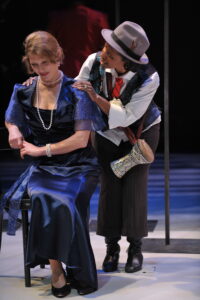
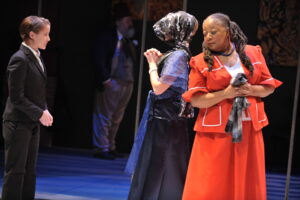
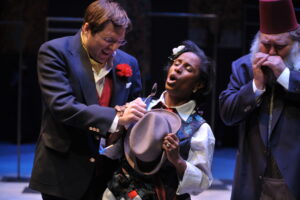
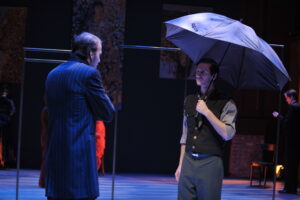
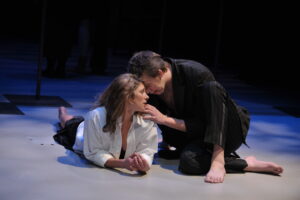
Have a fond or interesting memory of this play you’d like to share with us? We’d love to hear it!
Please Contact Us to Share!
Burning Coal Theatre
(919) 834-4001
224 Polk St., Raleigh NC 27604
Played December 4-21 2008: Twelfth Night
Way to Heaven
Way to Heaven by Juan Mayorga, Adapted by David Johnson
Dir. Matthew Earnest
Dates: January 22-February 8, 2009
Location: Murphey School
Artistic Director’s Notes:
While being interviewed for Way to Heaven by a Raleigh press writer, I was asked by a very perceptive question that got me thinking. As my answer to her spilled out, I became more and more excited about this play and its potential impact in the community and on our own company’s work. Here’s what I said:
“In the late 80s, while living in New York, I went to the Brooklyn Academy of Music to see a production of Ingmar Bergman’s National Theatre of Sweden. The play was called Madam de Sade. It was about the Marquis de Sade’s wife, a Frenchwoman. It was written by a man named Mishima, a Japanese writer, about the French, performed by a Swedish company and translated into English over headsets by guys with very thick Brooklyn accents!” It was brilliant! I went on to say that from that moment, somewhere in mind had been developing the idea of doing a play in two languages with a bilingual cast. When I found Mayorga’s Way to Heaven, which I immediately fell in love with, I knew I’d found the right one and began to assemble a cast and crew that could make the play sing in both languages.
At the same time, our managing director (my wife), Simmie Kastner, had been encouraging me for years to find a play specifically for the Spanish speaking community. I’d spent many hours trolling dramatic literature bookstores in New York, London and elsewhere in search of the right material. My instinct as an artist is to produce work that I love. In doing so, we hope to provide an opportunity for artists and audiences in the Triangle for whom English is not their primary language. We also hope to make our company’s aesthetic deeper and broader by exposing the company to additional ideas, customs, cultures and languages.
As the world gets smaller, our global neighbors become closer. Hello, neighbor, if you are joining us for the first time, and welcome.
Jerome Davis
Crew:
Stage Manager: Rebecca Buck
Technical Director: Curtis Lee Jones
Scenic Design: Stephanie Marum
Lighting Design: E.D Intemann
Costume Design: Johannah Maynard
Sound Design: Becca Easley
Props: Chelsey Lee Gaddy and Elsbeth Cassandra Taylor
Graphics Design: Simmie Kastner
Dramaturg: Ashlee Quinones
Asst. Director: Joshua Benjamin and Jan Morgan
House Manager: Joy Polhemus
Asst. Stage Manager: Chelsey Gaddy
Asst. Scene Designer: joncie Sarratt
Board Operator” Marcus Hanlin
Wardrobe: Michael Dulin
Cast:
Steven Roten – Red Cross Representative
Francisco Reyes – Commandant
Paul Paliyenko – Gottfried
Ensemble: Alex Tobey, Daniel Sowell, Jesús Martinez, Edna Lee Figueroa, Samantha Eahn, Evan Close, Hilary Edwards
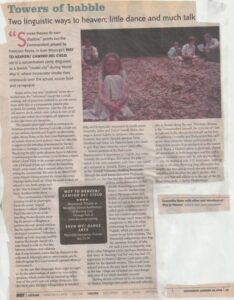
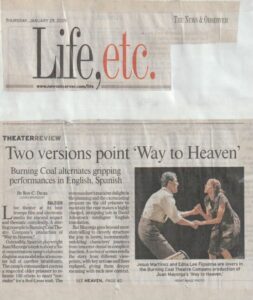
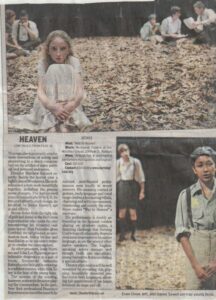
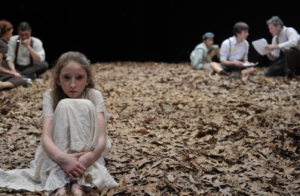
Have a fond or interesting memory of this play you’d like to share with us? We’d love to hear it!
Please Contact Us to Share!
Burning Coal Theatre
(919) 834-4001
224 Polk St., Raleigh NC 27604
Played January 22-February 8, 2009: Way to Heaven
1960
1960 by Ian Finley and Members of Burning Coal
Dir. Jerome Davis
Dates: April 9-26 2009
Location: Murphey School
Artistic Director’s Notes:
I am delighted to bring our first full season at this beautiful old building to a close with the world premiere of 1960. We have been working on this play for more than five years. I should offer a word of thanks for the encouragement and financial support offered for the creation of the play by the Lila Wallace Foundation and administered through the North Carolina Arts Council. Without that early boost, I don’t know where the idea would have gone. With it, we were able to begin collecting stories from the people who lived through the Civil Rights Movement … and to fashion a play.
I also want to thank the Campbell family and the Holt family for their support. It is easy today to look back on past events and declare, “sure, that was the right move” – but in the heat and doubt of those times, it is important to remember, these people were putting their lives on the line. There was absolutely no guarantee that what they were doing was going to lead to the far more tolerant and accepting society in which we now live. They were, and remain, giants among us. Let us all thank them for their service.
We have had a lot of fun with this play. That doesn’t seem right, given the gravity of the subject matter, but the fact is that the process of creation is a heady one, one that buoys the spirit. Being in a room with two dozen people, all intent on shaping ideas into a full length play is exhilarating and exhausting in equal measures. I am respectful of this story, but we always wanted to approach it with curiosity rather than blind reverence.
I don’t know if the American people have the fighting spirit anymore. I do believe we had it once and that it got us over the significant barrier of institutionalized racial segregation. There are other barriers still to be surpassed, but at least for a while, we had the stamina, the courage, the interest and the moral certitude to go ahead and raise our hand and say “Wait a minute. That’s not right!” I’ve not seen much of that spirit in recent years and I fear our art, even the mirror into which our society stares, reflects as much.
It would be arrogant to suggest that the world was past the idea of racism or indeed even that racism is the final battle to be won. As long as there is human nature, I’m afraid there will be a war within each of us, a conflict between what is right (i.e., good for everyone) and what is good only for ourselves. As the world becomes more and more complex, that differentiation is increasingly difficult to make. But I still believe there is such a thing as good and evil. Both qualities exist within each of us, yes, but sometimes there is a societal decision to be made. We walk up to that challenge and either take it on or turn and look away. For years, we chose the latter road. Then a woman climbed on to a bus, a group of men went on a march, a thousand voices were raised … and, in Raleigh, a woman wrote a letter. Finally, however belatedly, we all began to heal.
Jerome Davis
Crew:
Stage Manager: Elizabeth Gerhard
Technical Director: Curtis Lee Jones
Scenic Design: Simmie Kastner
Lighting Design: Christopher Popwich
Costume Design: Kelly Farrow
Sound Design: Elijah Vick
Props: Lauren Sexton
Graphics Design: Simmie Kastner
Music Director: Julie Florin
Choreography: Amy Murphy
Asst. Director: Lori Mahl
Movement: Emily Ranii
House Manager: joy Polhemus
Asst. Stage Manager: Rachel McCrain and Elsbeth Cassandra
Scene Painter: Suzy Hooker
Asst. Technical Director: Marcus Hanlin
Board Operator: Janay Jones and Aaron Pratt
Dresser: Caty O’Grady
Cast:
Jade Arnold – Joe Holt, Sr./ Oladuah/Dick Gregory/Ensemble
Jackson Bloom – Leroy Martin/Boy at Pool/Luke/Ensemble
Ann Cole – Advertising Woman/Betty/Sue/Ensemble
David Coulter – Jesse Helms/Jesse O. Sanderson/Vic Fisher/Judge Stanley/Ensemble
Emelia Cowans – A Housekeeper/Elwyna Holt/Anna Hayood/Frances Lonnette Williams/Ensemble
Joan J – The Teacher
Warren Keyes – Joseph Holt (adult)/John Chavis/Principal Baker/Herman Taylor/adult William Campbell
Kaimy Masse – June Campbell/Thomas Jefferson/Ensemble
Khy’ri McKenzie – Young Bill Campbell/Ensemble
Jan Morgan – Advertising Woman/Miss Price/Mrs. James Stough/Mary/Ensemble
Greg Paul – Thompson/Gov. Hodges/Willie York/Ensemble
Tara Polhemus – Receptionist/Letter F/Letter K/Teen/Reporter/Ensemble
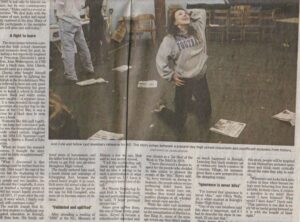
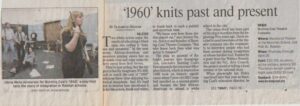
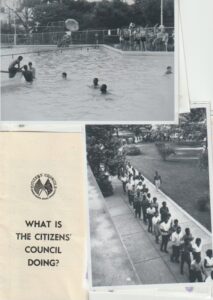
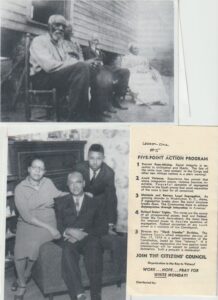
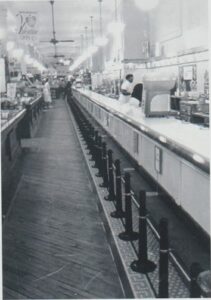
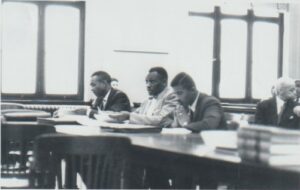
Have a fond or interesting memory of this play you’d like to share with us? We’d love to hear it!
Please Contact Us to Share!
Burning Coal Theatre
(919) 834-4001
224 Polk St., Raleigh NC 27604
Played April 9-26 2009 : 1960
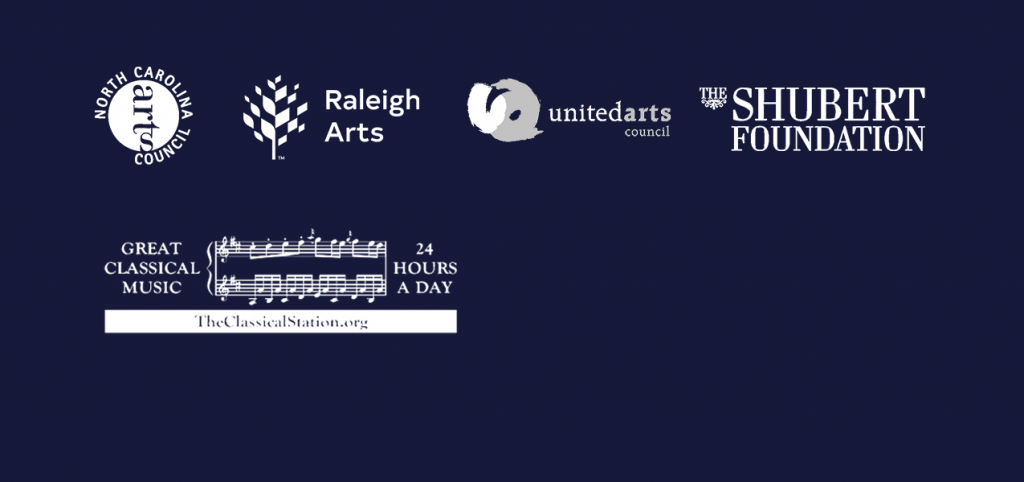
Thank you. Your being here and your support makes it possible to bring live, inclusive, innovative theatre to Downtown Raleigh, NC, and beyond.
Burning Coal Theatre Company is funded in part by the City of Raleigh based on recommendations of the Raleigh Arts Commission. Burning Coal Theatre Company is supported by the United Arts Council of Raleigh and Wake County.
Burning Coal Theatre | (919) 834-4001 | info@burningcoal.org | 224 Polk St., Raleigh NC 27604
Copyright © 2021 Burning Coal Theatre Company | All Rights Reserved | Home
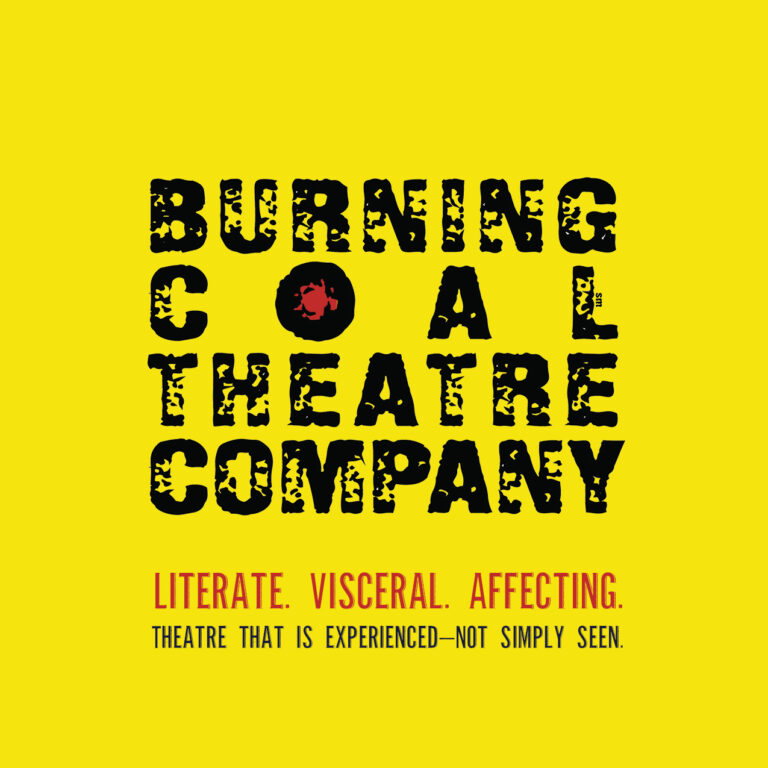
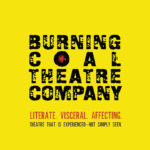
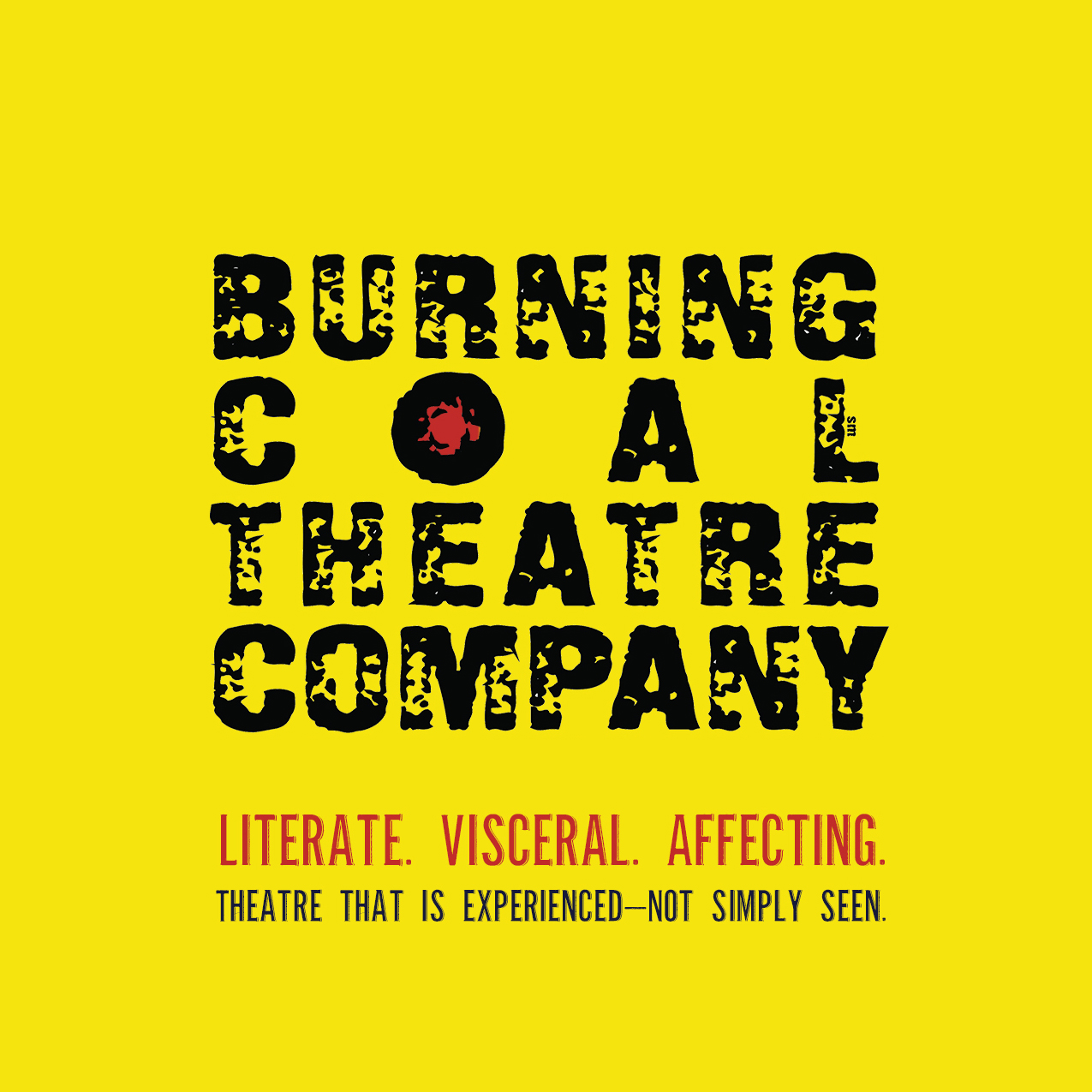


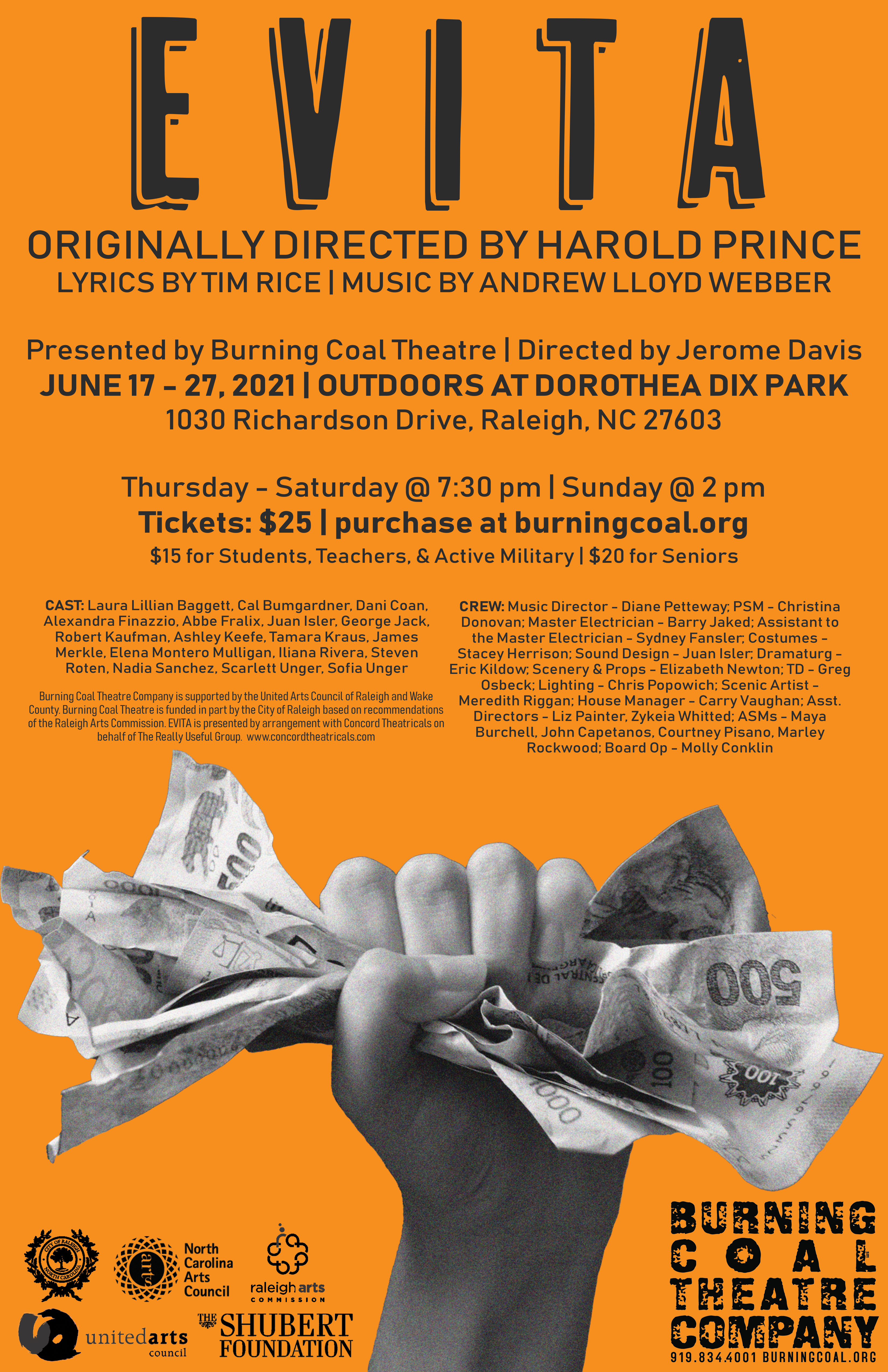
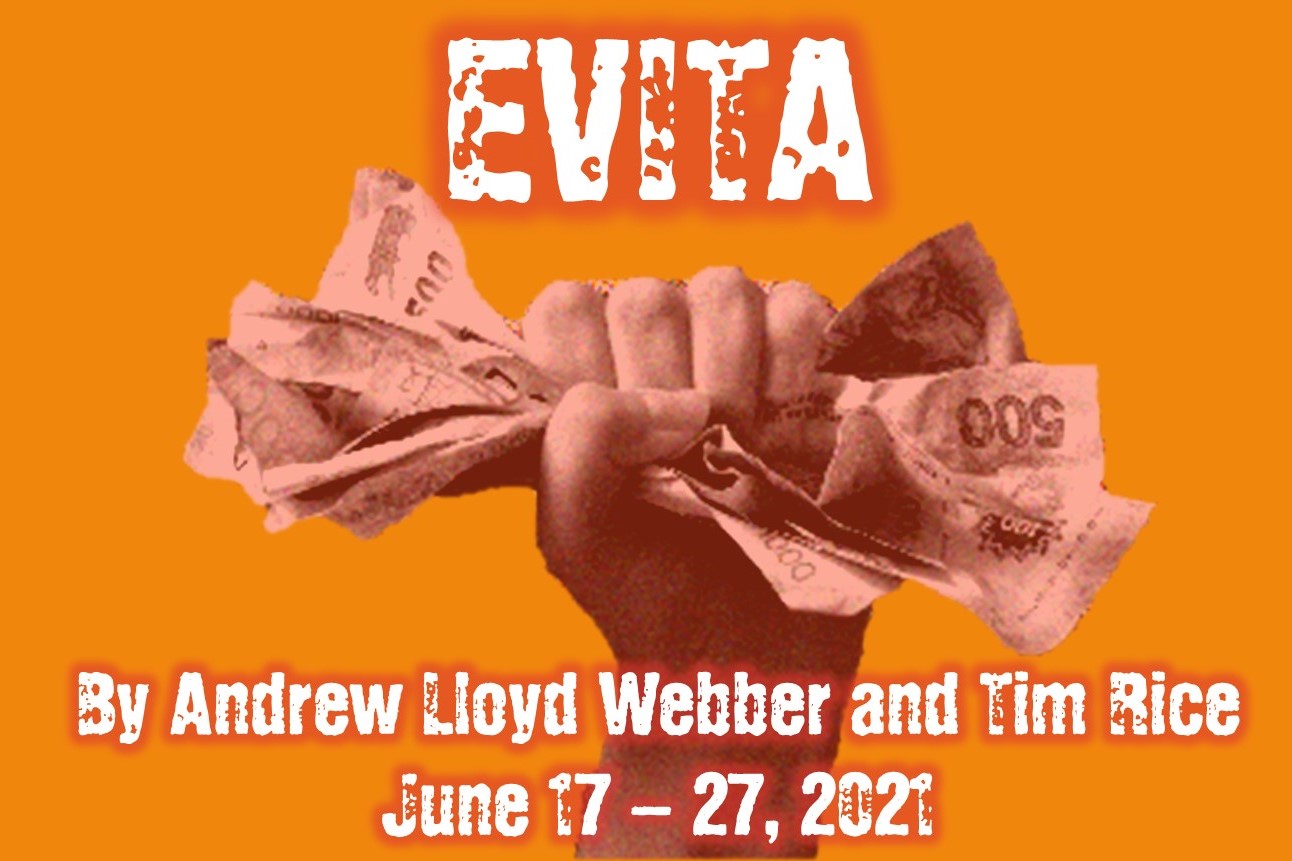
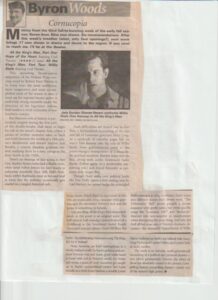
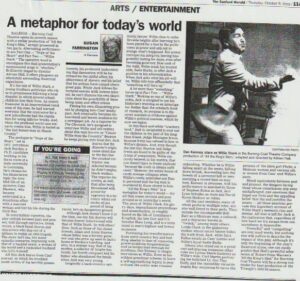
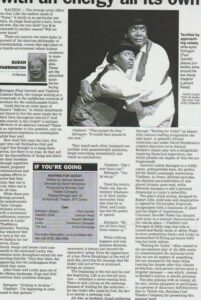
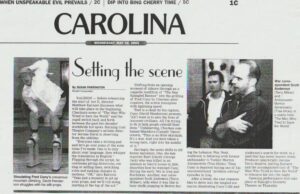
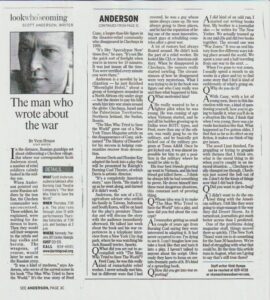
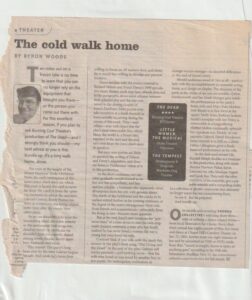
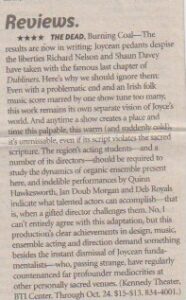
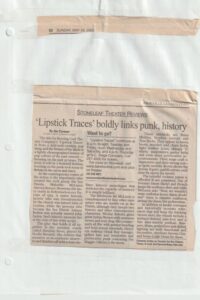 CVNC Review
CVNC Review